



Information wants to be free, and net art is information. Trying to make it harder to copy is like trying to make water less wet. Or perhaps like trying to give it a soul. In “Blockchain Poetics” I described “new kinds of quasi-property” created using the Blockchain as a mis-application of that technology. Ken Wark is similarly unimpressed – “My Collectible Ass“, he complains in e-flux.
The history of Conceptual Art’s dematerialization of the art object shows that the art market loves nothing more than finding ways to make the previously unsaleable into financial assets. As Wark points out, “We tend to think that what is collected is a rare object.” There’s nothing rarer than something that doesn’t actually exist. But the un-ownable and non-or-barely-existent can be represented as property by proxy objects. Financial elsewheres rather than financial futures.
Cryptographic tokens are a generalization of cryptocurrency to represent assets other than money. Such as editions of digital artworks. Wark’s criterion of rarity is reflected in the name of the most successful crypto-token collectibles – “Rare Pepes” are detournements of the “Pepe The Frog” character (previously appropriated by the alt.right) that are sold as CounterParty tokens. CounterParty is a system layered on top of Bitcoin’s blockchain that allows the creation of new tokens with varying properties (different issuance amounts, subdividable or not, locked for further issuance or not, a sub-token of another token) which can then be exchanged and transferred backed by the security of the Bitcoin blockchain. It’s an older system than Ethereum or other platforms that are now used for tokens. It has few major use cases, and Rare Pepes are one of them.
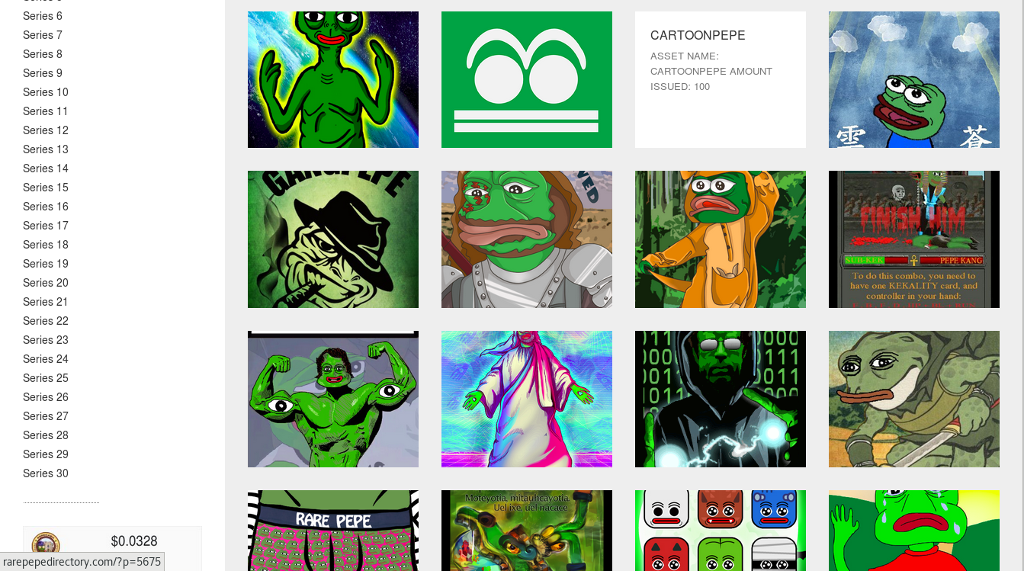
To make a Rare Pepe card you create a CounterParty token with a reference to the image you are using in its metadata, issue as many tokens as you are going to, then lock the token so no more can be issued (making the token “rare”). Rare Pepe quantities, prices and styles vary. There are magazines and virtual galleries devoted to them. There is even a subtoken representing the original physical version of one image (with an edition size of one).
A more singular set of images are the “CryptoPunks” (seen at the top of this page), which exist as an ERC20 token (almost) on the Ethereum blockchain. The “smart contract” that administers the token contains a cryptographic hash of an image of 10,000 bitmapped characters which can be bought and sold using its functions. Like Rare Pepes, the punks have a lighthearted style (they are retro pixellated avatars) and have varying rarity (some features are unique, others appear on dozens of characters) . Unlike Rare Pepes, every punk was created at the start of the project and no more can be added. At the time of writing, punks are available to purchase for 0.12 to 1,010,101,101,110,010,011,000.01 ETH (40.35 to 339,616,193,448,241,111,336,826.06 USD).
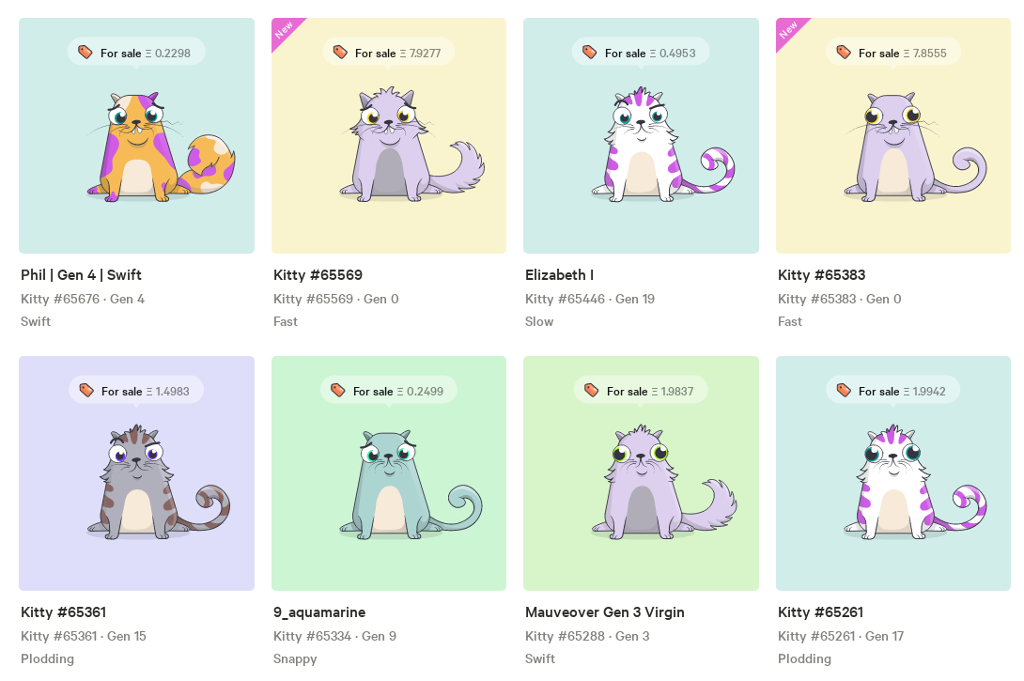
An even more playful approach may be able to take artificially scarce digital collectibles mainstream. CryptoKitties are customized cartoon cats whose appearance is determined by a digital genome (like the old “Cabbage Patch Kids” dolls) that can be interbred to produce more of them (like William Latham’s “Mutator”). At the time of writing they are taking up 13% of the Ethereum network’s capacity, making them the single biggest user of that blockchain, and the most expensive has sold for more than 100,000USD.
Every art is relative to a culture and an economy, whatever its other properties. The ground that tradeable blockchain images are a figure against is a particular moment in the history of cryptocurrency. Trading cards and digital collectibles fit a specific cultural niche, as does their iconography and the socially performative act of dealing in them. Their price may reflect the ability of cryptocurrency early adopters (who in the case of CounterParty and its XCP currency don’t have much else to spend it on) to be more extravagant with their hodlings.
“dada.nyc” follows the tokenized image edition strategy but applies it to popular/illustration art. Again each image is available for a given price in a given edition (for example 0.084 ETH in an edition of 150). The gallery takes a cut, and it takes a cut on profits on the secondary market. It also gives a cut to the artist, simulating Droit de Suite/Artist’s Resale Right. The Resale Right is controversial – it breaks the first sale doctrine and mostly benefits the estates of dead famous artists. But I implemented it as a user-settable property in the Art Market smart contract that I wrote in 2014 as I felt it was worth experimenting with in a voluntary setting.
Monegraph came out while I was working on that project. Like Ascribe it is a serious digital art registry implemented initially using pre-smart-contract technology (NameCoin for Monegraph, Bitcoin for Ascribe). These platforms’ seriousness and phrasing as registries contrasts with the playfulness and explicit tokenizaton of more recent systems. This and the already mentioned possible impacts of the social and economic impact of the increase in value of cryptocurrencies since 2014, along with the increased mainstream awareness of cryptocurrency, may explain the difference in their adoption (or at least their place in the hype cycle).
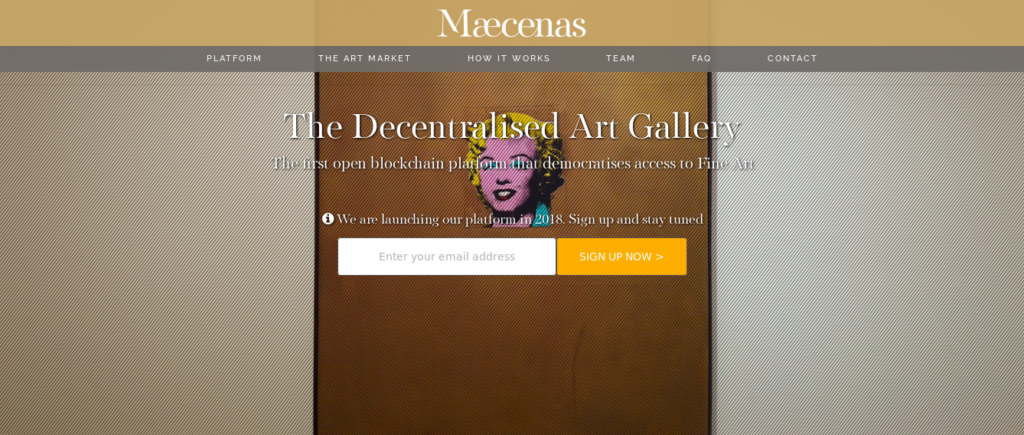
In contrast, Maecenas is a tokenized investment fund for physical fine art. It operates in part like the scene in William Gibson’s “Count Zero” (1986) in which Marly, one of the protagonists, reflects on how art in the mid-21st century is bought and sold as “points” in the work of a particular artist that represent shares in the value of the “originals” which are stored unseen in a vault. To quote their web site, “investors speculate via synthetic exposure: James is a Modern Art collector who needs to finance the purchase of a new Jeff Koons sculpture worth $120k. Instead of selling items from his collection, or getting an expensive loan, James get the required funding by listing in Maecenas 20% of one of his flagship pieces of art. Access to Maecenas is via an ERC20 token named (ART)” that Maecenas claim will improve access, transparency and fairness in the art market.
Propertization, fractionalization and financialization via proxy tokens (we cannot “own” allographic digital images, or own part of autographic paintings without dismembering them, but we can own tokens that we agree to pretend represent these things) promise to support art production using the economic accident of the value of cryptocurrency going to the moon. Quasiproperty without attempts at the costly fantasy of imposing access control via DRM is a form of, or a variation on the idea of, patronage. I feel this complex of ideas should be more useful to critics of the commodity form and capitalism than it has generally been treated as so far. If we still wish to take the opposite tack this leads us to the gift economy or the commons. Copyright is the default state for most art when it is created and is being increasingly restrictively enforced on the net. Opposing it passively or actively through alternative copyright licensing can perform a critique of this and keep space open for alternatives. These strategies needn’t exclude each other though.
If you are familiar with DAOs, you can see how a system similar to these could become a self-supporting, self-curating DAO. Plantoid is an example of a singular artwork (or family of artworks) produced and exhibited in such a way. Imagine it generalized to a gallery or a participatory art show, a DAO that lets you do art with others, a DAOWO.
These technologies can provide objects for critical exploration that evoke wider contemporary themes. They can function as tools and resources for the creation of art and its social collectivities focussing on these and other themes. Within the existing economy they can provide ways of supporting the arts (as many of the projects mentioned above claim to), which should neither be dismissed reflexively nor accepted without irony. Or they can be used to try to bootstrap a different context entirely, even if only briefly or in the imagination. The various modes of tokenization represent potential ways of making a living in, critiquing, or even transforming the artworld in an era of the continuing expansion of the sphere of private property and financialization under technocapital.
It was not the cyberpunk universe you were looking for.
Our nostalgia centres were lit up with a cut from a flying car to a full screen eyeball staring across the opening scene, synchronized on the script and musical score of its 20th century precursors’ timing. From there, audiences of the Blade Runner sequel were dropped into a pale California wasteland blanketed with conglomerate agricultural biofarms, an antithesis to cyberpunk’s damp, urban hybridity. The green, utopic space beyond the city– only glimpsed at the end of the 1982 original theatrical release and removed entirely in the director’s cut– was where we started from in Blade Runner 2049, and (surprise) there’s nothing but the dystopia of the anthropocene to look forward to there either.
Times change.
The recently post-industrial, 20th century cyberpunk rebellion of bodily sensuality: the noir lighting, the baroque candelabras burning, the lingering fingers stroking out haunting piano music; these were relics now, hinted at, ghosts of a genre in its past moment. Even the endless rain characteristic of the cyberpunk genre was repeatedly replaced with snow in Blade Runner 2049. A borrowed soundtrack teasing the familiar bridge to a heroic death scene came without poetic dialogue or even a witness. Rogue replicants were not criminals, but escaping criminality. Even memories were no longer stolen in this world, but legally manufactured, a convention stripping the typical cybernetic plot of bioharvesting found in cyberpunk down to a more contemporary, bioengineered ethics of classed and raced co-humanity if ever there was one. No, this ethical failure was smoother, blended into liberal values and legal structures, more sanctioned somehow.
The 80s cyberlibertarian world of the white lone wolf, struggling for autonomy in a hybrid, post-globalized world of orientalist economic takeover, had passed by in the great data “black out” of 2020 apparently, and Denis Villeneuve didn’t care about your need for consistent genre romance. Sort of. Rather, the director brought the audience’s need for Blade Runner nostalgia in and out of the sequel like a tool, cuing our attention to wait for it, partially rewarding us with a sensory, semi-nostalgic moment, only to glitch before nostalgic completion. Again and again, it was invitation and estrangement from our own expectations. Blade Runner 2049 was a highly self-aware remix of its own postmodern references and refusals in a predetermined world.
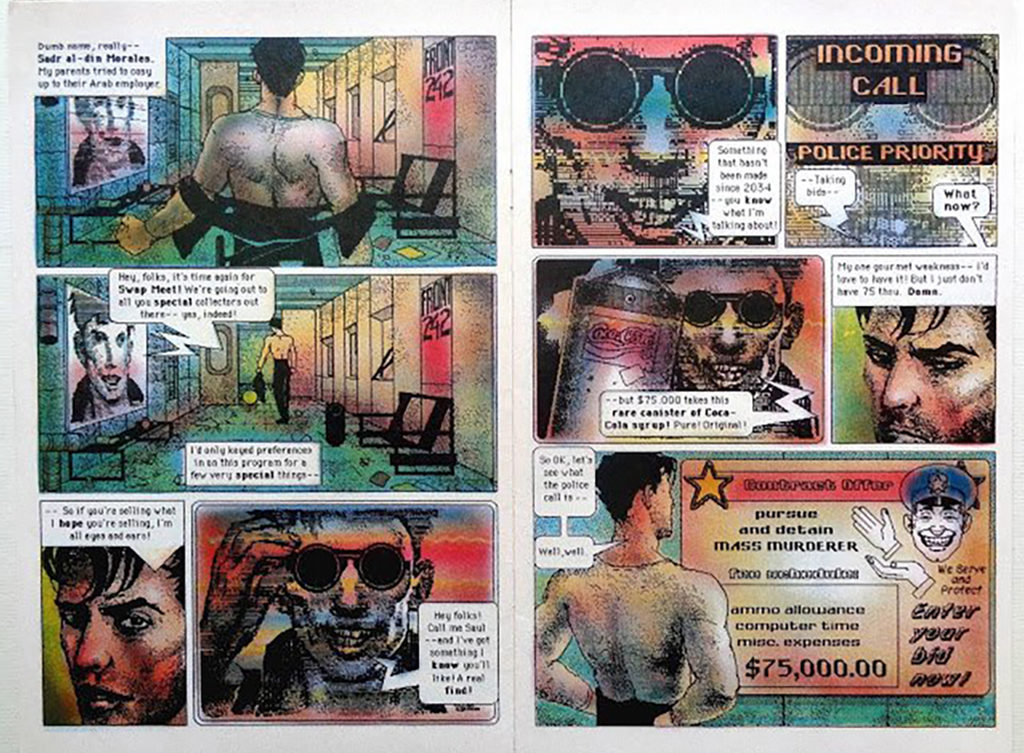
Perhaps a hybridity across two cyberpunks of historical time and cultural change was apropos. Ridley Scott’s genre critique of the corrupt corporation had evolved since its 20th century take in the Alien franchise, expanding to consciously address our own implication in the techno-dystopian social narrative. It turns out that we are no longer universally laboring blue collar victims in the secretive horrors of impending biopolitical technocracy. Rather, we are eager and satiated participants in its isolating ubiquity; high tech consumers implicated in all of the attendant social stratification, inequality, and suffering that its warm glow of access masks and accelerates, from facilitated gentrification and casualized labor, to the toxic, extra-legal wastelands of dead electronics processing.
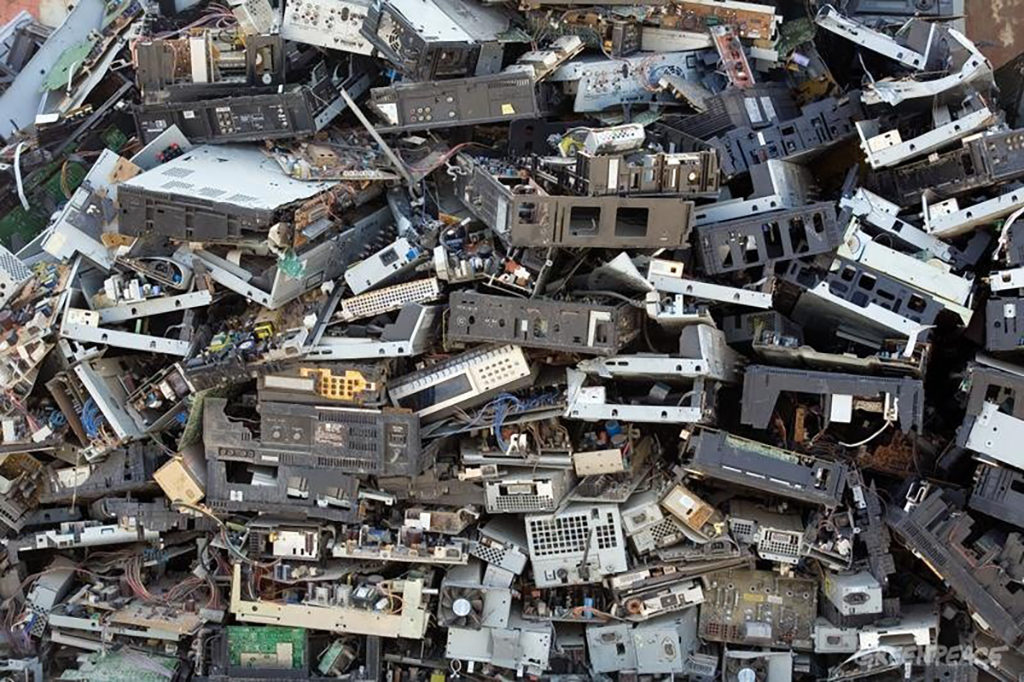
Disruptive innovation has predominantly benefitted the 21th century, western, science fiction audience. Our classic cyberpunk desire for the vindication of the social outlier– the androgynous Sigourney Weaver in a corporate-threatened future of full equality and bodily autonomy, or the replicant who can reclaim a subjectivity beyond his or her social paradigms and slave programming– has since been turned on its anti-establishment head. Scott’s film Covenant saw this come to fruition when the Menippean Anti-hero, Bakhtin’s rebellious, paradigm-questioning literary figure cloaked in the absurd eloquence of language, is fledged into a full sociopath. We saw this in the philosophical and intellectual character of David and his calculated experiments to replace the evolutionarily inferior human species. If Menippean satire is “a genre for serious people who see serious trouble” (Howard Weinbrot), than what is this?
By Covenant, our anti-hero no longer presented the humanistic redemption narrative of the Menippean Nexus 6 leader, Roy Batty, in the original Blade Runner. Instead, Covenant gave its inverse: a regressed society being shown the mainstream values it has come to love and endorse in a world of neoliberal anti-establishment leadership. So much for the underground resistance crouching in the street garbage. The 21st century universe of cyberpunk has been one of well-mannered disruptive innovators of the species, philosophically visionary proponents of transformative wealth models built on slave bodies, and the “technê-Zen” veneered (R. John Williams) institutionalization and naturalization of technological sociopathy. Here is a social darwinist instrumentalism for our post-human age of market-driven measures of social success and impending climate change. In this universe, androids can be humanist while humans can be androids in an inhuman system, conveying either ‘progress’ by any means necessary or a losing sense of civilizational duty. Whose side, Covenant asked of us, before its devastatingly feel-bad ending, were you hoping would win anyway?
David, it turns out, was the only anti-hero we deserved now.
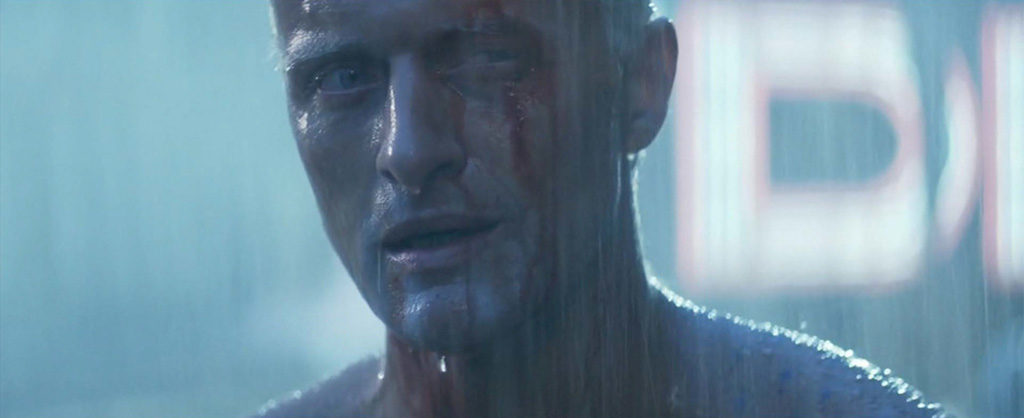
Denis Villeneuve’s sequel fits surprisingly in this updated cyberpunk universe. Like Walter in Covenant, the replicant hero who becomes Joe in Blade Runner 2049 (in contrast to Roy Batty) clearly lacks the eloquent language and especially satire of the subversive, Menippean Anti-hero character. Surprisingly, we find his strain of articulate stream-of-conscious in the tech empire guru played by Jared Leto, drained of all the feeling and trickster-like ability of Roy Batty. Joe, however (like Walter), is simple and humble in his speech, seemingly able to feel but dying suggestively in silence off screen. Robbed of the poetic dialogue expected of the death scene, only a soundtrack bite nostalgic of Roy Batty’s final scene signals a death of redemption for Joe in Blade Runner 2049. Yet the unsentimentally raw, blank slate of Joe’s expression asks of his audience: What do we see through his eyes? What language could possibly be used here to convey the gravity of a moment when power so regularly denies and manipulates the language of our experiences? In this silence, we are perhaps left to only wonder what we would be feeling.
What if it had ended differently? Would Roy Batty’s eloquent speech achieve the same humanizing disjuncture today, or does it really belong now to Niander Wallace, our tech monopoly visionary of the neoliberal age, emptied of any contradiction with the smooth flow of progress rhetoric and sociopathic public morality? Niander Wallace as foil who cannot stop talking makes Joe’s uncharacteristic silence all the more uncanny. According to Jonathan Auerbach, the uncanny involves a “trespassing or boundary crossing, where inside and outside grow confused… reveal(ing) dark secrets hidden within.” Auerbach is talking about film noir here– a highly unsettling sensory genre metabolized into the late Cold War aesthetics of the Blade Runner world. But perhaps we can relate this psychic role of the filmic uncanny to other hybridities explored through expressionist media, where the formal manipulations of sight and sound once conveyed the uneasy clashing of two worlds affectively.
Is Villeneuve’s silent denial of a hero’s dialogue in a death scene, for a Blade Runner audience, purposely estranging? Does it achieve the same, disorienting “uncanny bodies” (Robert Spadoni) that silent film audiences, unaccustomed to sound in their movies, reported with the introduction of Talkies? Film scholar Shane Denson describes how post-Talkie movies of the Thirties like Frankenstein (1931), were created in a period of transition and between the old and new ontologies of silent and sound film media. Denson argues that such films, working after the initial novelty of Talkie exposition wore off, played affectively with the new hybridity of films formalist storytelling qualities. In doing so, these films drew attention to our participation in media: “sight and sound conspire(d)…to encourage the viewer’s medium sensitivity, to coalesce with the perception of a constructed monster.” And what is a sequel, after all, if not a constructed monster of narrative to become conscious of?

“Questions.”
We live in a time of the seductive post-human technologization and normalization of very inhuman institutions, public policies, and person-like entities whose social impacts are all too often screened over with ‘alternative’ narratives of language. Glitches in this flow of mainstream mediated ways of knowing can be more than anti-nostalgic; they can be disruption to the alt-fact hyperreality in the neoliberal 21st century. Are uncanny bodies of the sensorily unexpected (or, even, dissected) what we have left to successfully slow down and stutter our neoliberal ubiquity for hearing chasm-filling speech? Can such estrangements allow us the conscious relationality to once again actually hear and see how we are hearing and seeing each other?
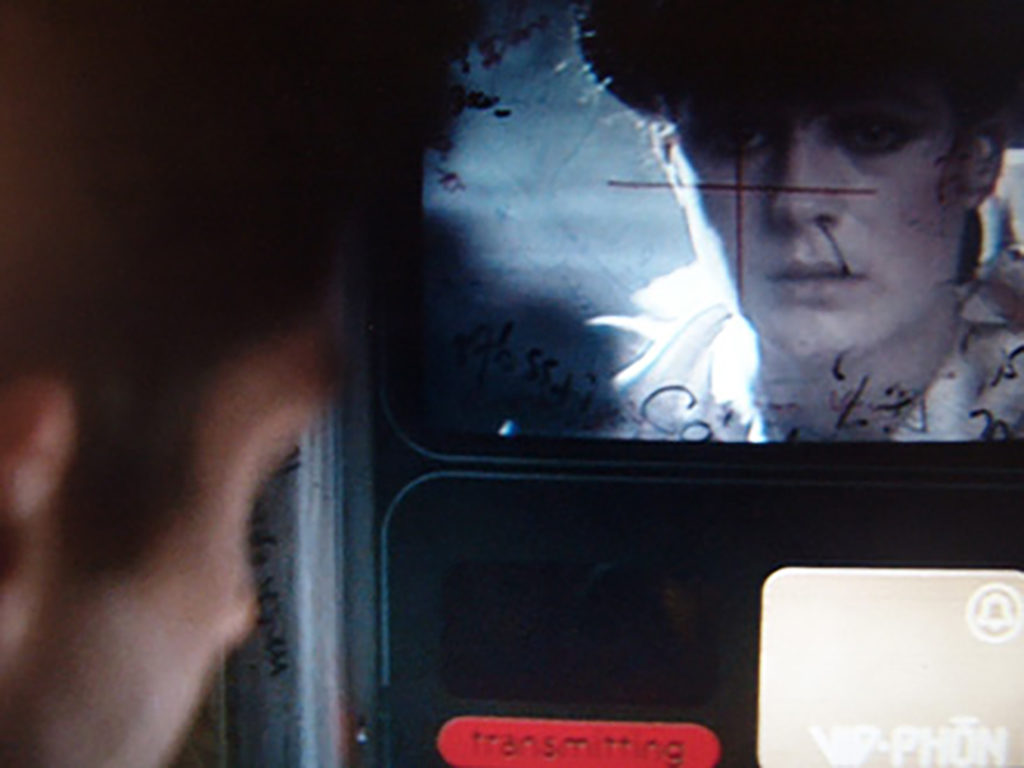
It is convenient to note here that the technological imaginary of the first Blade Runner movie refused ubiquitous surveillance. Blade Runner 2019 even refused a conception of the personal communication device so often credited with fracturing collective sociality in both sci-fi and reality. Decker, for example, calls Rachel from a public videophone in a bar. Whether human or replicant, technological worlding of the original Blade Runner insists on the communications scale of face-to-face human relationality. By the end of Blade Runner 2049 this same scale of technological imaginary in the original film returns. It is the death of one body, the replicant called “Luv”, that seems to end the limitless reach of panopticon technology that helps advance the plot.
Some kinds of love can destroy. Scene from Blade Runner 2049
This act leaves the future of Blade Runner’s Earth yet again to the relations between two, individual physical bodies. With the 1% most likely afloat in the outer world colonies, we might assume this means that it’s up to Us to cross the interface of hyberbaric differences. At a time when love has become perverted with neoliberal logic– instrumental, utilitarian, stripped of its greater sense of equality or duty– it seems that Villeneuve graciously gives us an answer here, if not a fantasy to hold on to. Perhaps one consistency in the Blade Runner franchise is the argument, like that of Junot Diaz on neocolonial oppression (as if it ever ended) and the uptick of white supremacist domestic terrorism, that it is ultimately intimacy with the Other and rejection of the glorified “lone wolf” mentality that must be revolutionary: “Vulnerability is the precondition to contact.” What if being in our present moment requires the vulnerability of silence?
“Listen:”
Nostalgia has come unstuck in time. In Ghosts of My Life, the late Mark Fisher wrote extensively of the threat of nostalgia in postmodern cultural production. Building on theorists Frederic Jameson and Bifo Berardi to explain the bending of new technologies to recycle comfortable and profitable cultural forms for capitalism, Fisher explains how “…the nostalgia mode subordinated technology to the task of refurbishing the old”, not of specific past styles, or periods, but forms of never-fully-present time asynchronicity. Consider it like another outdated, self-reproducing model, ever expanding all around you to stay relevant. Perhaps you can finally see its now, like a loose eye, engineered, removed from its familiar socket.
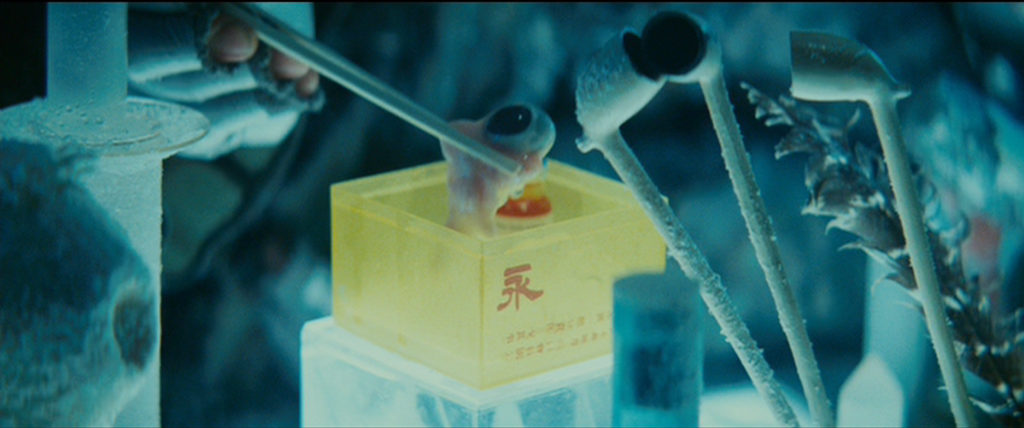
Transgressive fiction has this way of making our boundaries visible in the crossing. The reader may resist its dehumanization, suddenly queasy. Barthes once wrote about the surrealist Georges Bataille’s Story of the Eye, a modernist novel from the early mid-20th century which indeed involves a plucked eye and its “metaphorical journey” across other eye-like images. An object, he wrote, “can pass from hand to hand… or alternatively it can pass from image to image, in which case its story is that of a migration, the cycle of the avatars it passes through, far removed from its original being, down the path of a particular imagination that distorts but never drops it” (his emphasis). Barthes felt The Story of the Eye was less a novel and more like poetry. Through its avatars and crossing of sensory metaphors, the eye simultaneously “varies and endures.” Consider the following example of crossing sensory metaphors from the Blade Runner sequel: eyes, cells, tears, rain, leaking, bleeding, blinking, seizing, splashing, drowning, watching, “cells”. And what if this thing we now strangely see so differently is neither naturally born nor autonomous, but a constructed thing?
How eerie.
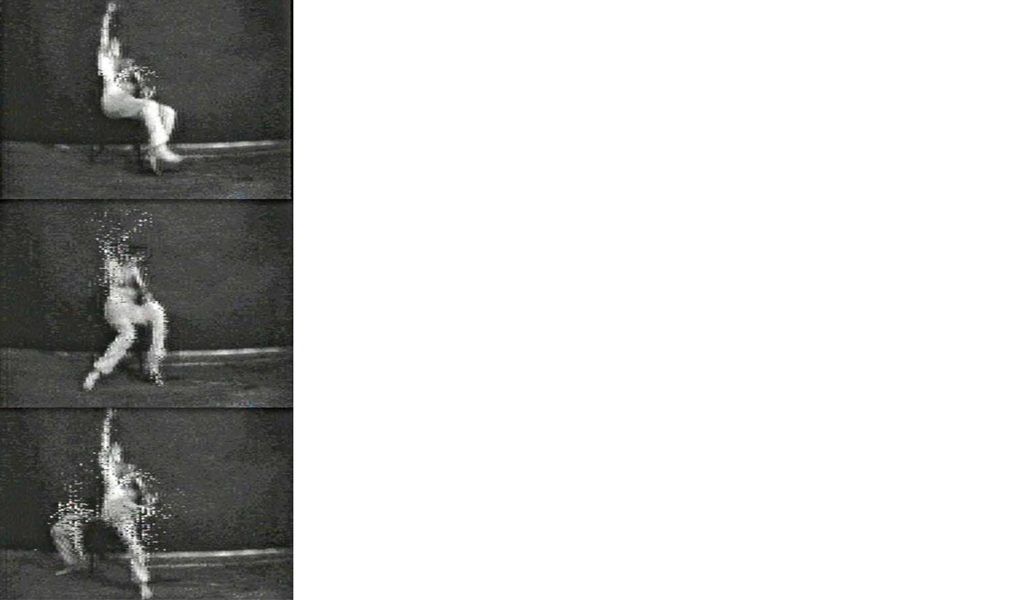
Eerie like the absence of “future shock” in the futuristic. According to Fisher, nostalgia mode production is an aspect of the “cultural logic of late capitalism” that “…disguise(s) the disappearance of the future” and prevents any real possibility of innovative “rupture”. Nostalgia in our entertainment helps stabilize the “cultural deficits” created under globalization, soothing the simultaneous “exhaustion and overstimulation” of instantaneous and transactional relations we can’t seem to deal with. It fills a high-speed chasm of emotion, truth, and meaning. It denies us the “uncanny” recognition of our temporal futurelessness, left teetering on neoliberalism’s precarity of resources “despite all its rhetoric of novelty and innovation…”
Let’s just be honest here: by the time the Coke commercial hologram showed up in Blade Runner 2049, it was a joke on our desire for even nostalgic product placements.
Nothing changes.

Dipping into the media art world at this borderland, theorist and filmmaker Hito Steyerl writes in “A Thing Like You and Me” about the video that David Bowie put out in 1977 for “Heroes”:
He sings about a new brand of hero, just in time for the neoliberal revolution. The hero is dead—long live the hero! Yet Bowie’s hero is no longer a subject, but an object: a thing, an image, a splendid fetish (…) the clip shows Bowie singing to himself from three simultaneous angles, with layering techniques tripling his image; not only has Bowie’s hero been cloned, he has above all become an image that can be reproduced, multiplied, and copied, a riff that travels effortlessly through commercials for almost anything, a fetish that packages Bowie’s glamorous and unfazed postgender look as product. Bowie’s hero is no longer a larger-than life human being… but a shiny package endowed with posthuman beauty: an image and nothing but an image.
What are we to do when no degree of protest or declaration can make an exploited object be seen as a subject? Where is one to find anti-heroism in all of this? Let us be objects of severe agency then. Models that are perhaps transferrable, but unobtainable. One of a kind and replaceable. Constructed yet autonomous.
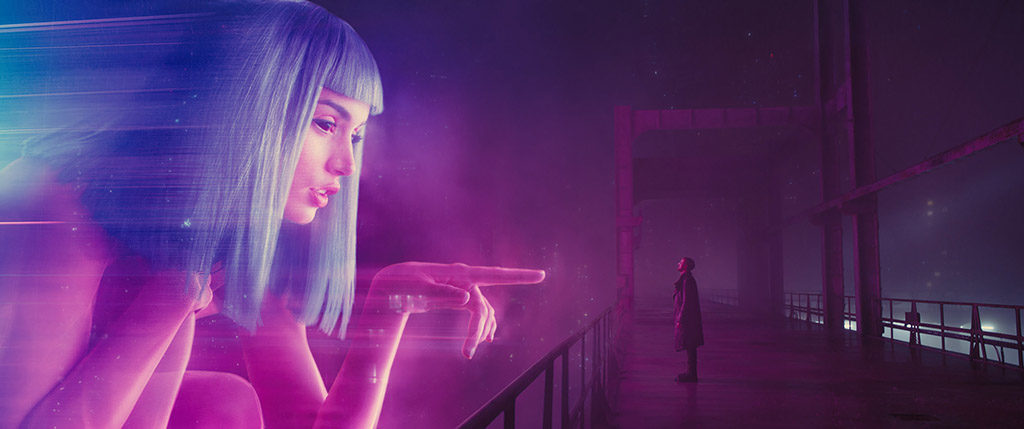
Perhaps then we can only view these things in suspension: the need and refusal of nostalgia as liberating human process, the uncanny increments of our cultural evolution to product and media-focused estrangement, the will to see one’s own familiar pixels blown wide open. “Digital information is … characterised by transformation, degradation, circulation,” explains Hito Steyerl in an interview in Rhizome, “but also by its surprising ability to mutate and produce unpredictable results. The glitch, the bruise of the image or sound testifies to its being worked with and working; being passed on and circulated, being matter in action.” Futureless. As futureless as staring into a present ruin, expansive but without destination, the destination without purpose.

Apropos, then, how our old and new heroes meet in that ruined casino scene, outcasts of white difference (by the future racialization of the synthetic) in an atemporal Las Vegas, framed by primordial Seven Wonder monuments to the our foundational schisms of misogyny (yes I’m also talking about me).
In this incarnated ruin of our stubbornness for cultural mythologies, I was struck by the brilliance of the fight scene, the director literally exploding our pixel expectations of 20th century nostalgia as soon as Harrison Ford makes his long-awaited appearance. The sonic build-up of Decker’s familiar piano in the distance was dissolved by the strange sound of his disembodied voice un-cueing an upcoming appearance in the scene, his visual reveal in that moment of our auditory let down, confusing: Desire misfiring. The ensuing cyberpunk clash-as-fight-scene of 20th century romantic and 21st century post-romantic dystopic characters corresponds to the casino’s hologram interface of an imagined, mid 21st century entertainment technology; all of the expected glamour and nostalgia is allowed to barely seduce us before sputtering and malfunctioning as filmic metascene. Within the plot, these post-apocalyptic hollywood holograms are also a sign of the future sentience to come in the character of Joe’s AI wife, Joi, and a warning that all technology rebels and mutates from initial human intentions, no matter how superficial the design intentions.
My interpretation of this violent casino stage scene in light of a more recent American mass shooting of an ever-expanding, historically singular, and self-containing statistic of “largest ever” is not lost on me. Neither is the choice of mid 20th century entertainers like Elvis and Monroe who notoriously performed like automatons with post-human qualities, their movements in time-space of perfect bodies turning on the master clockwork of a still-industrializing cultural machine before blowing apart, fragmenting. Their avatars echo of consumer-creator bodies in our postindustrial world of 2.0, gig labor, automated economic transactions feigning meritocracy, and a model of precarity demanding the inhuman perfection of individual responsibility for every movement which can shudder, glitch, and explode on other people all too frequently.
This failure is that of speculated, plotted, rationalized, and technologized courses whose error cannot be properly imagined, only realized and refused in the ruins of a short-sighted economic-cultural imaginary. Our looking back on dystopia hints at our present expectations only.
“Irreversability.”
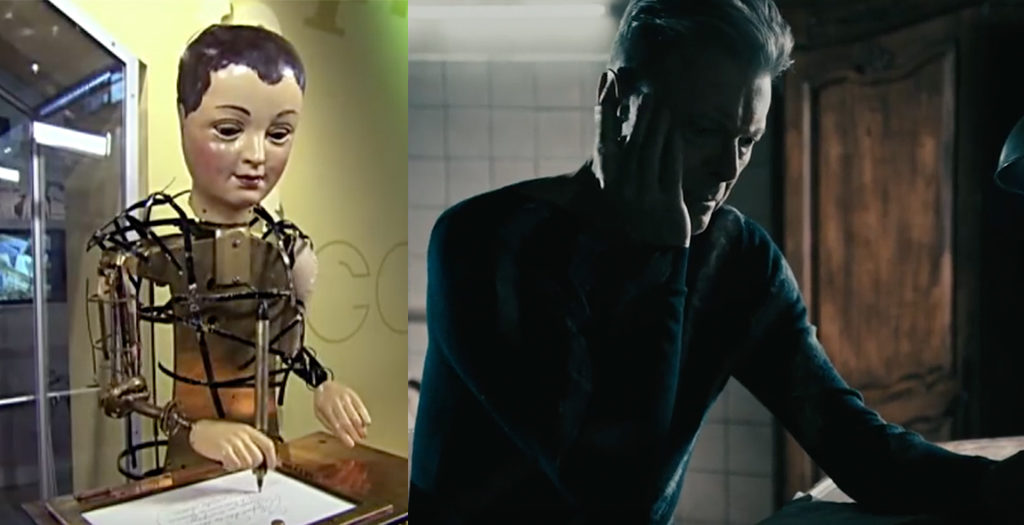
“It’s difficult for someone of my generation to break free of the intellectual automatism of the dialectical happy ending”, writes Bifo Berardi about irreversability. He compares this “taboo” concept to the “silent” apocalypses of our endless growth mentality, like Fukushima, corporate disaster unaccountability, socialized scarcity adjustments, and our silence on fellow human suffering. His book, The Uprising: On Poetry and Finance, speculates a “process of subjectivization” for the return of solidarity to a “social body”. This is the social body being culturally reprogrammed away under our collectively isolated movements of relentless market-driven consumption and precarity (individualist and systemic, like the fascist choreography of Kracauer’s Mass Ornament, or the Las Vegas showgirl spectacle). We might consider these grinding automaton gears of consumption and precarity the logics of late-terminal capitalism for clarity, it’s refusal a glitch in our clockwork performance. What is one to do for a postmodern exit other than to shudder, to write off the page? Ultimately, Berardi’s book leaves us more with a hope for our relational redemption from neoliberal culture through “sensibility” than it does with answers.
Blade Runner 2049 may not have been the sequel people wanted, but its confrontations with its own expectations provided a little of the things we need: a vision of the finite and anthropocene, a postmodern exit to the endless technologized avatars of getting what we think we want, our profound silence of the awful price. The film’s self-aware, nostalgic ruin leaves us with a little less of the typical sequel’s fourth wall, and an identification with its lonely bodies, caught in action between clockwork cultural predictability and its refusal. These bodies may or may not have the capacity for real love, but they are vulnerable at least to a larger sense of duty that Humanism, in all its universalizing failures, really needs. In this hybrid space of ontological awareness of the facets of knowing, experience and process, Blade Runner 2049’s success was inbetween all the things it could never definitively be. We too might realize that ‘doomed to fail’ may only be our insistence on choosing from a predetermined relational binary.
A distant song floats into the scene.
…“Though nothing, nothing will keep us together…”
When I saw Blade Runner 2049, in was at one of the remaining four hundred or so drive-in movie theaters left in the United States. I went back in memory to my kindling college interest in what I study and consider Avantpop, surveying the changes, considering its meaning and meaningless in my social development as a scholar: working class, woman, white, heterosexual; accepted and refused and abused entrances. The sequel came less than thirty years later in the revolution of a world for me, but I travelled farther to get there, out to a dark semi-rural drive-in beyond the city, and a memory of popping in a VHS tape almost 20 years ago simultaneously. I time-traveled mass media ontologies. I posted an instagram picture. It was semi-romantic nostalgia for me. But I still see that there is only now to change what we’re doing. And it is terrifying.
It’s quite an ending, to just die in silence, isn’t it?
But the fourth wall was always part of this, you know.
The word speculation is defined as ‘the forming of a theory or conjecture without firm evidence’. The act of speculating was predominantly popularised with the rise of the stock market, however, recent environmental destruction and technological advancements have prompted a rich pool of speculation about the future of our planet, our species and our connection to other facets of life. Tomorrows: Urban Fictions for Possible Futures is such an exhibition, compromised of imaginative narratives speculating the future of our cities – how they will look, how they will function and the degree by which these cities will form new types of citizens directly operating within the network of that future city. In the context of the exhibition’s content, fiction is transformed into mighty medium, utilised to share the ideas of thirty-two individual and group projects. These projects envision and share their anticipation for the future as a means of addressing socio-economic, environmental and other issues we face today with a goal to reassess of our presence on the planet.
Tomorrows was curated by Daphne Dragona and Panos Dragonas, and organised by the Onassis Cultural Centre in Athens – a city experiencing continual fluctuations since the end of World War II. The location itself, Diplarios School (a place of former learning and listening), stresses the aspect of sharing and the telling of important narratives determining the shaping of the future. The exhibition begins with a didactic, yet absolutely accessible approach to understanding the notion of developing a future city. As a starting point, the exhibition borrows and advances the ideas of Doxiadis’ speculative plans of an Ecumenopolis from 1959-1974. More particularly, we must take into consideration the term ‘ekistics’ which was coined by Doxiadis in 1942 as derived from the ancient Greek noun οίκιστής, meaning a person who installs settlers in a place or creates a settlement.
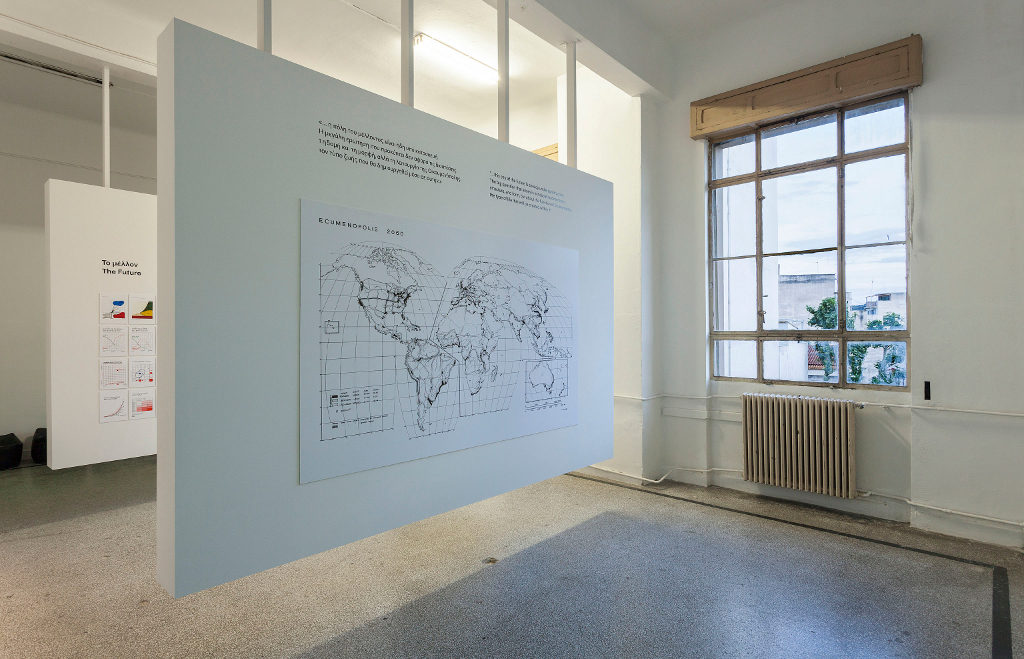
In order to create the cities of the future, we need to systematically develop a science of human settlements. This science, termed Ekistics, will take into consideration the principles man takes into account when building his settlements, as well as the evolution of human settlements through history in terms of size and quality. – Doxiadis
Doxiadis was a visionary and the decision to reinstate his work within the framework of the exhibition was incredibly rewarding for visiting audiences. He anticipated that cities were to become more than global in order to accommodate an ever changing human and non-human environment – as one huge network perhaps out of the control of human capacities. Ecumenopolis is installed on large hanging panels in the first room of Tomorrows and acts as a reference point to the five themes developed: Post-Natural Environments, Shells & Co-Habitats, Networks & Infrastructures, Algorithmic Society and Beyond Anthropos. These themes resonate to the acceleration of our urban development hybridising the natural with the artificial, future network infrastructures of our habitats becoming dependent on inhuman mediation, the possibility of an omnipresent and undemocratic structure within the city through the interdependence of economy, ecology and technology, possible forms of organisation to encourage modes of co-existence within the city, and technological singularity as challenging human sovereignty within our future cities. Doxiadis work gives way to the participants who are primarily artists, architects and designers, to explore these imminent futures of our present planet’s landscape.
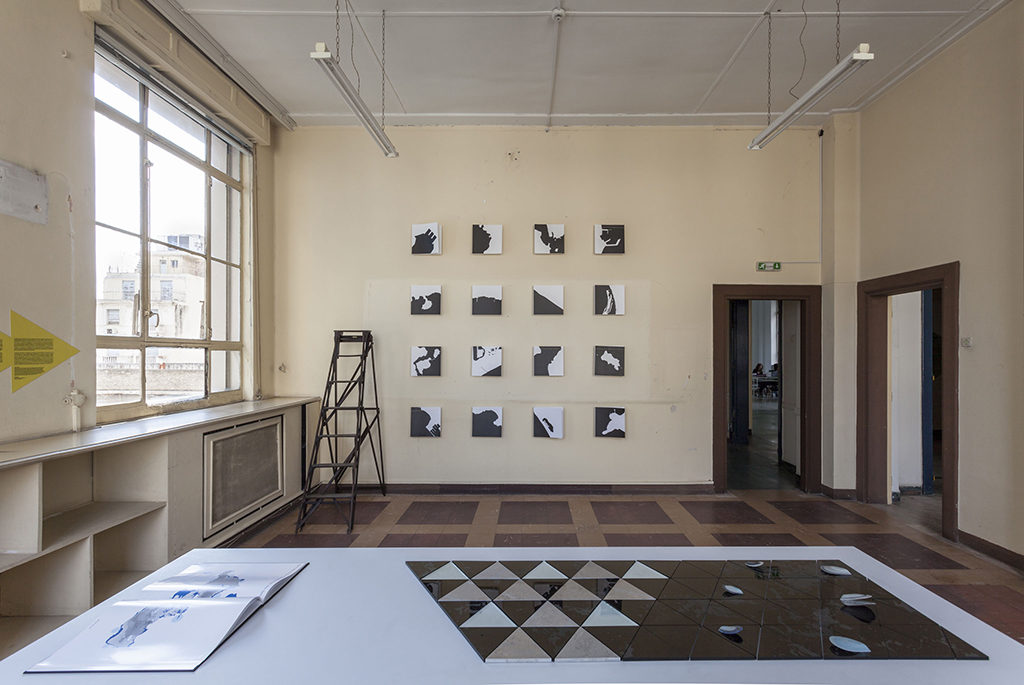
Coastal Domains is an on-going research project exploring the future landscaping of coastal territories in the Northeastern Mediterranea facilitated by Demetra Katsota along with 4th and 5th year students at the Department of Architecture, University of Patras. The installation Coastal Domains was made up of sixteen books, acting as case studies, secured on the wall and a ladder to reach them, encouraging brave visitors to climb and read them – a curatorial decision simultaneously inspiring participation and learning as it is explicitly reminiscent of old archival libraries. The 7th book in the series of sixteen engaged with the coast land of Kanoni and its Sea Lane on the island of Corfu, the research undertaken by Stella Andronikou and Iasonas Giannopoulos. As with each book in the series, the research was made up historically archived material, such as cartographical maps from different centuries and topographical material including the arrangement of roads and different fauna on the island thus unveiling issues of coastal development, the implications of an upsurge of tourism in the 1970s and possible environmental issues. Coastal Domains speculates and designs possible structures for the reinforcement of sustainability, devising various strategies that can protect the coasts of the Mediterranean Sea.
Tomorrows is particularly involved in engaging its locality of the Mediterranean, treating it as a microcosm for observing the implications of the future’s development. Silo(e)scapes by Zenovia Toloudi envisages a hybrid of a seed bank and museum for Mediterranea plant species as a tool inspiring a sharing economy. The installation of Silo(e)scapes required the audience to cradle themselves into the centre of the structure in order to experience the transparent silos-displays of the community LEGO labourers sharing their local seeds at the seedbanks. The audience suddenly find themselves in a possible future reality, all encompassing of agrarian sounds and 360 views of kaleidoscopic mirrors that trick perception of your depth of field. Almost theatrical, Silo(e)scapes is immersive and constructs a space where the audience is directly in conflict with the imminent shortage of supplies due to harmful environmental issues and increasing urban development. The audience becomes entirely physically encased in Silo(e)scapes, as a result inciting the plausibility of this future reality.
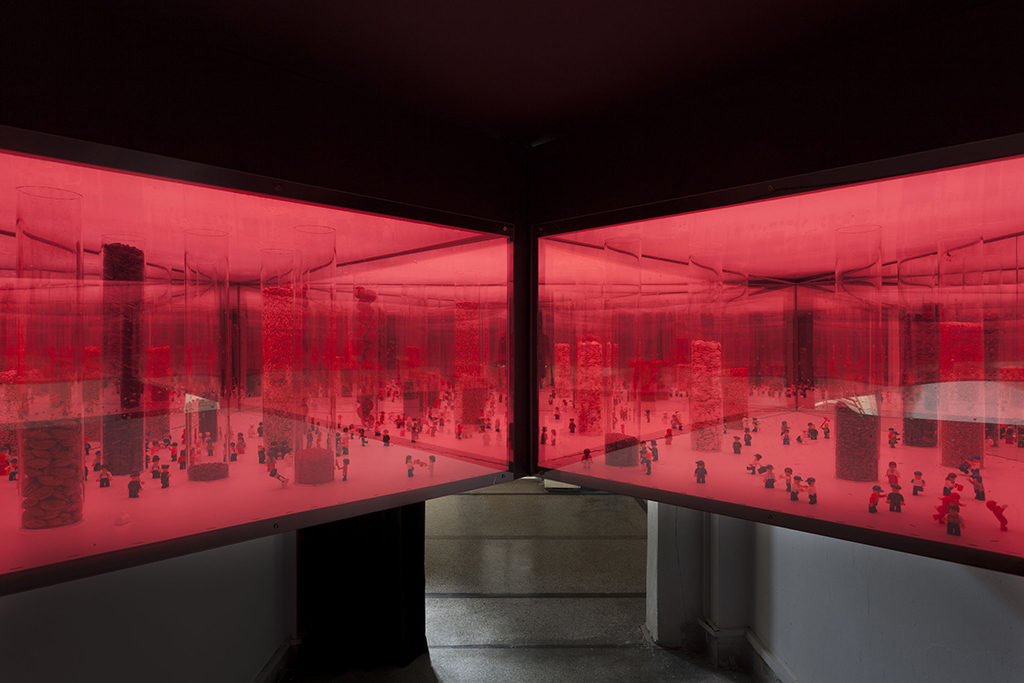
A Cave for an Unknown Traveler by Aristide Antonas introduces another form of habitable landscape for the possible future. The installation is structured like a ‘fake archaic cave’ that is buries inside it a structure as luxurious as a modern hotel room, invisible to the eye from the outside. The installed structure of the cave is complimented by a large sketchbook denoting the various features of the Cave for an Unknown Traveler. Antonas’ work brings to mind the concept of Plato’s Allegory of the Cave. The infrastructure and services within Antonas’ cave can be taken in context of the prisoner’s in Plato’s cave perceiving shadows as objects when in fact they are a mere representation of their physical form grasped by our mind. In this context, Antonas’ invisible cave begins to resemble an imagined safe haven for a traveling passer-by.
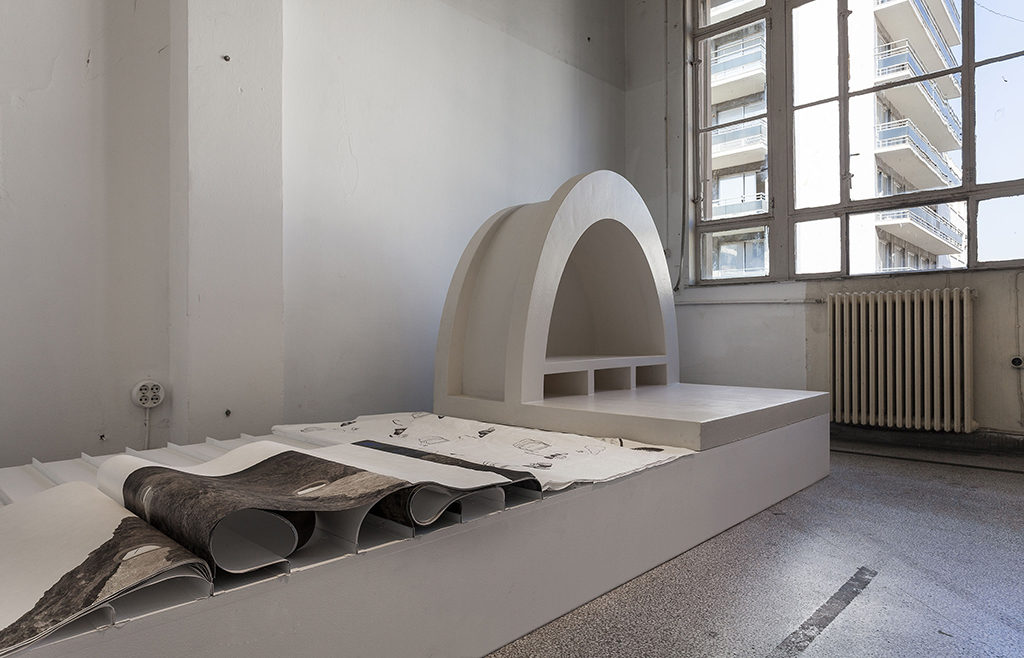
The highlight of Tomorrows is undoubtedly Liam Young’s commissioned work Tomorrow’s Storeys – a two-channel video installation isolated in a dark room with modular seating. The title of the work acts with a double meaning as in storeys of a building and the stories being told through them. The content, or stories, narrated in Tomorrow’s Storeys were first conceived in a workshop in mid-March as part of the programming to the run-up of the exhibition opening in mid-May. The workshop of visual artists, authors, photographers, directors and architects produced an abundance of local stories in the future city of Athens, particularly a future Athenian apartment block. In Tomorrows Storeys all apartments blocks have the ability to reorganise themselves automatically – modular entities like seating in the installation. The videos convey intricately detailed shots of the façade of these apartments as well as its contents recalling film shot by aerial drones and ads for IKEA products. The audience act as omnipresent eavesdroppers drifting from storey to storey into the conversations and local happenings in these apartment blocks. These apartment blocks of the future have found a way to reorganise themselves where Athenians are not given a minimum basic income but instead a minimum basic floor area – the occupants do not own an apartment but a specific volume of space which does not have a fixed location. Amongst these stories of shifting permanence and impermanence one stood out: that of an old grandmother dying and the family arguing about who takes over her volume of space as one character cries quite humorously “Can’t you wait until the funeral?!”. Tomorrows Storeys are part of a city where bots constantly reorganise your living in a form of urban computation according to best fit the needs of its citizens. In this way, a living space becomes a temporality, alluding the audience to question if their home is real if it always available for smooth transition to another space.
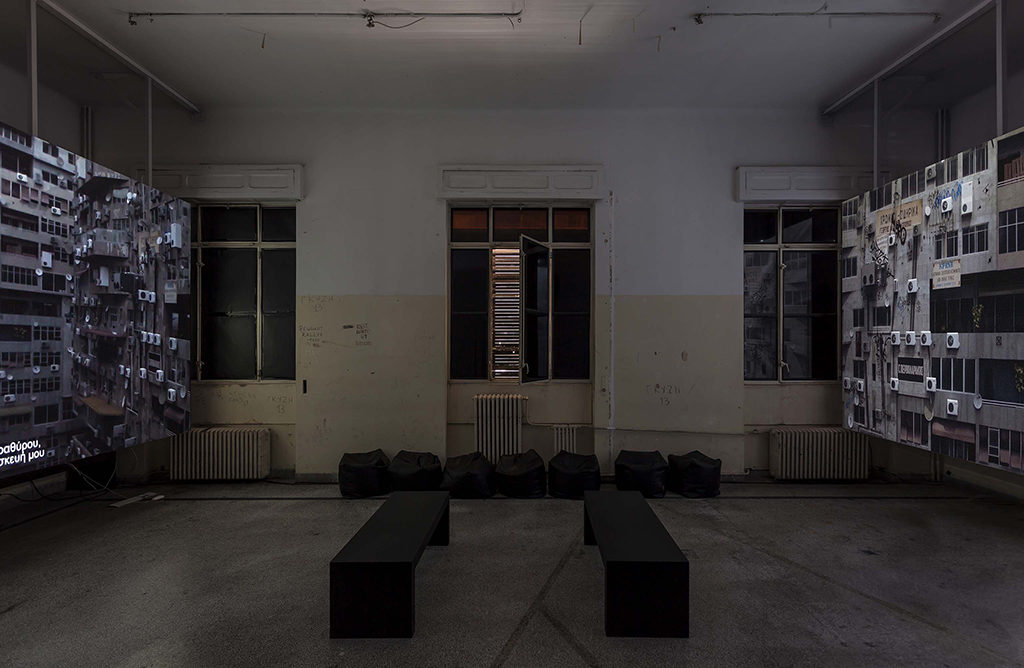
Within urban infrastructures are the human entities contained within them, as Young’s work emphasises, however some of these are becoming increasingly inhuman as the theme of ‘Beyond Anthropos’ suggests. The notion of inhuman or machinic entities being able to replicate human form and intelligence is common and highly popularised since the 1980s as films such as Bladerunner introduced global audiences to ‘replicas’. Today, AI is becoming so intelligent that it urges inventors such as SpaceX and Tesla CEO/founder Elon Musk to warn for correct precautions to be taken when engaging with AI, in fact comparing it to ‘summoning the demon’ and naming it ‘our biggest existential threat’ in the 2014 AeroAstro 1914-2014 Centennial Symposium by MIT. The work of !Mediengruppe Bitnik, coming only a couple of years after Musk’s interview, exemplify the relationship between human and machine. Ashley Madison Angels at Work in Athens is a research project initiated after the data of the Canadian online dating service was leaked in 2015. The leak revealed that Ashley Madison had created 75,000 female chatbots that catered to 32 million mostly male users, engaging them in costly internet intimacy. In Athens, there were 165 fembots for around 22,910 registered users. The installation was comprised of seven of these 165 fembots active in Athens, and were installed in a room dimmed by a fluorescent pink light with screens on tripods similar to average human height and alluding to a physical form. The fembots, programmed to be of different ages, utter pick-up lines they are allocated from a predetermined list to the 22,910 registered users who could not distinguish that they were talking to a machine and not a real person.
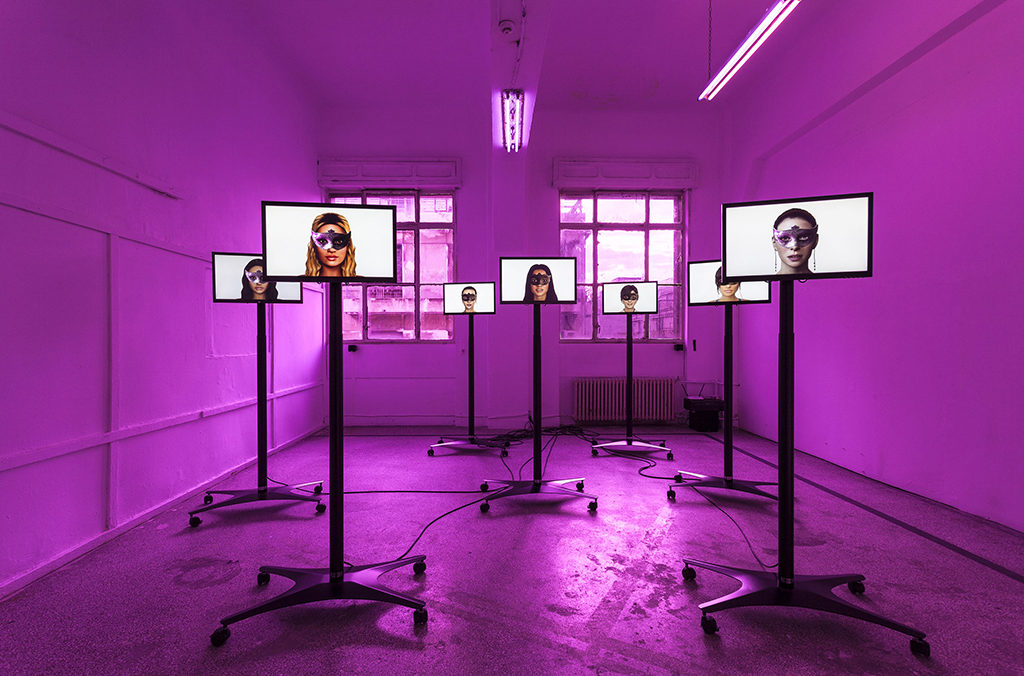
Tomorrows does not wish to present us a future as a prediction or as a form of critique of these technological, environmental and urban developments. Rather, it presents the future as an on-going participatory project, as a tool that can be utilised to examine who we are and where we are at in present tense, as well as where we could be potentially going. These urban fictions of our possible futures, are a speculative activity with the capability of making us more aware of the changes that have taken place whilst simultaneously illustrating the changes that are afoot. Tomorrows was a show that took place over six months ago, but its value to the discourse of the future will remain timeless for decades to come.
This is the third of three pieces on people who are posting work to the photography sharing site Flickr [1].
In this final article I look at the work of Karin Rudolph
. Rudolph is a Belgian photographer, currently living in Athens, where she works as a wedding and event photographer and raises two teenage sons. In addition to her work for pay she makes an ongoing series of ‘personal’ images which she regularly posts to the photo sharing site Flickr.
I ask her to send me some images from a wedding job and she does.
It is a job she is clearly good at—everything is beautifully shot, nicely framed, sharply in focus (when sharp focus might be thought necessary), but there is that extra something that comes with a good portrait photographer, which I can only describe as fellow feeling. A fellow feeling which elicits transparency and a willingness to risk vulnerability from the subject. I’ve never met Rudolph but it’s clear that her personality, her way of being, is a player here.
There’s also a sharp curiosity at work—a hunger for the way the world looks and with Rudolph this seems to become attached to particular objects, creatures (some human, some not) and roles. There was a dog at the wedding in the images she sent me. The wedding took place outdoors and the clearly much loved animal figures in a number of the shots. It’s as if at one point R becomes fascinated by it and we get shots where the all humans are cropped (in the shooting; she doesn’t crop after the fact) down to the waist and the dog becomes central (although a small child has a supporting role here too since he necessarily evades the crop/frame wholesale). We get a dog narrative. Then a bouquet catches her eye and we get a bouquet narrative, the wedding filtered through a non-human being or an object. Motion—a sense of the moment before and the moment after being necessary, if hidden, components of this still image—is a key underpinning of so many of these images, particularly in relation to these micro-narratives.


In a photographer less manifestly gripped by the facts of our fragile human being and ways in the world one might call some of her approaches formalist. It is certainly true that rhyme, echo, geometry, continuities and disruptions of line, shape and colour play a highly significant role in the structuring of her images but one of the driving forces of R’s work is that it constantly moves to dissolve any artificial divide between content and form. Yes, her eyes seek pattern; yes, this or that organising device might order an image but this never obscures our awareness of the facts, feelings and relationships portrayed or implicit there. Also—we humans are formalists, aren’t we? We’re pattern seekers. We play. Were you never fascinated as a child by mirrors, by the world turned upside down by hanging from your legs or by the cropping or heightening, or focus) achieved by looking through the cracks in your fingers? Of course you were. As we grow we perceive the whole world through a complex dialectic of what is presented to our senses on the one hand and our burgeoning sorting and structuring principles on the other. We are of necessity creatures of content and form together and one surmises that this is what makes us creatures of art too.
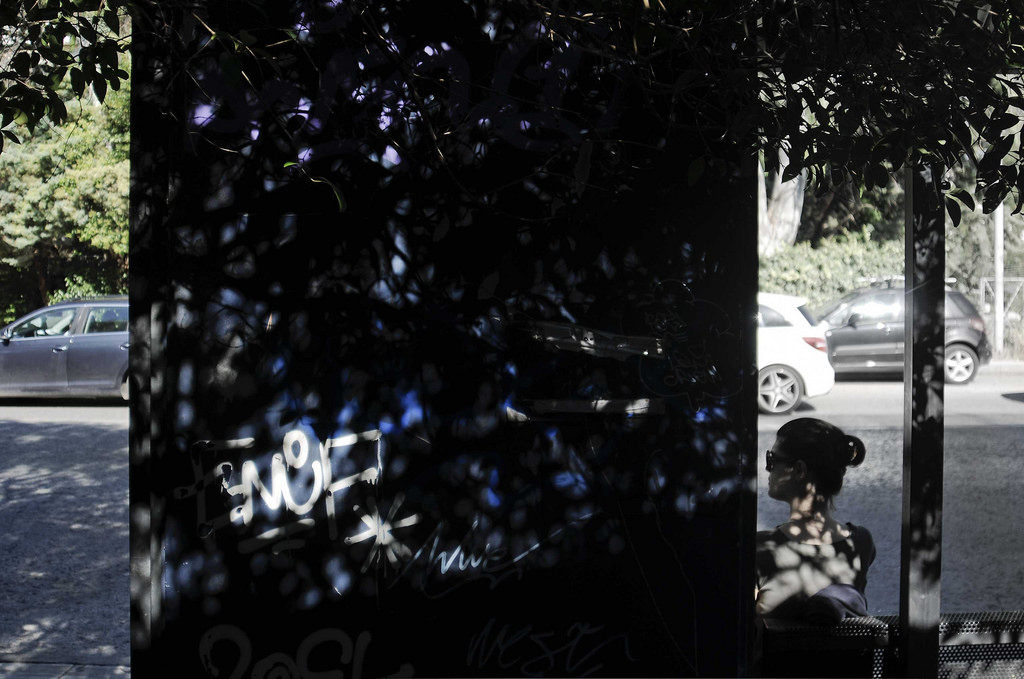
I’d been writing and thinking about this piece for a few months, on and off, and I’d got to a second or third draft when it hit me with a thud, a jolt, that hardly any of the recent images have titles.
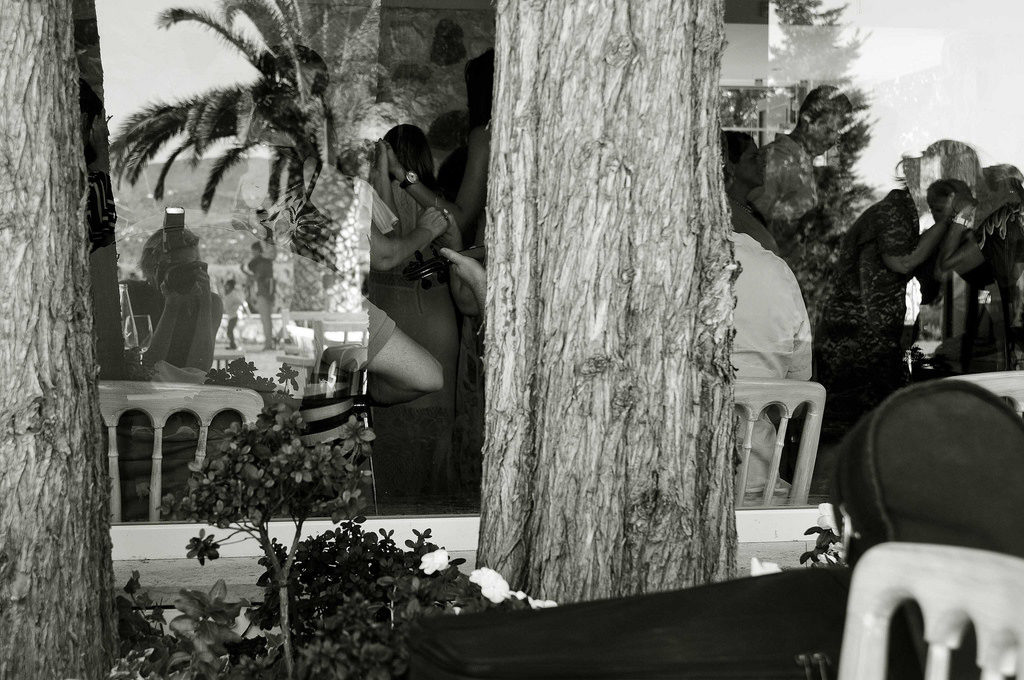
The fact had just sailed under my radar, curiously, since I’ve argued and will again, that insofar as we can talk about meaning in a photo (or any visual artwork) this possibility lies in a network of references and comparisons which ineluctably involves talk, writing or both. Language. Further, that visual art is best seen as something humans do (emphasis on both words) than as the usual set of isolable ‘in and of themselves’ objects (which isolation is a fiction, at best an analytical convenience). And then it struck me ( I was being struck a lot that day) that there is something about these images that fights back against language—they’re often cross genre and resist categorisation and there’s a sense in which the easiest approach to what’s in them is simply to list it, and finally to say that this image had these things in it under this kind of light from that angle but, of course, this is far from satisfactory and at root there is something far transcending taxonomy or description going on. But –dammit! –I can’t help feeling it is as if the images (placed as they are in the sequence formed by Flickr) are calling out, hailing each other. I don’t know why, but forced rhubarb, a most unlikely image, is the one which springs to mind and persists, as if the absence of the immediately adjacent language of a title somehow forces the set of glorious but hitherto mute images to invent speech.
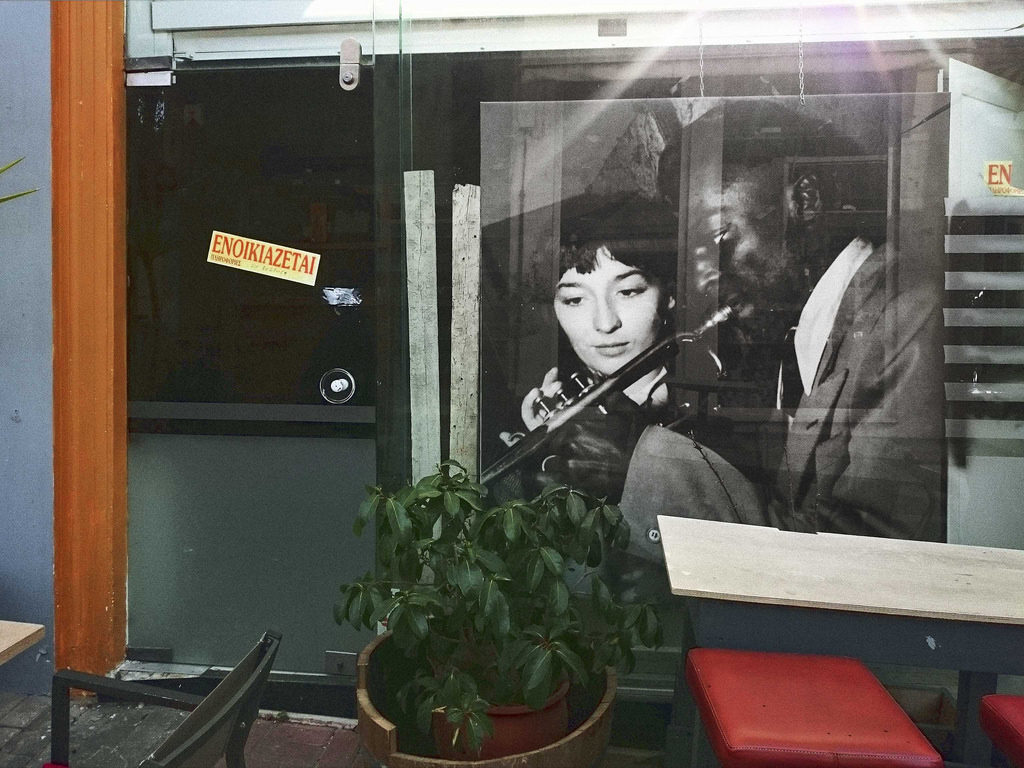
Anyone who has ever taken an un-posed image of a human being on a fast shutter speed will be cautious about ascribing emotions or characteristics to the subject on the basis of what is revealed. As in so many other ways, the very small, the very distant or unreachable, animal locomotion, the photograph reveals things beyond our normal ability to see or grasp them. One of these things is the curious plasticity of the human expression and how in our interactions we read this in sequence, in time, together with a host of other clues, aural and visual, to make sense of what is going on, to try to understand both what a person is doing and to surmise what they might be feeling . (Of course the opposite of this, the posed image, brings its own problems too.)

When we think hard and soberly we cannot but be convinced that the photograph alone, an impossibly small fragment of time, does not allow us enough evidence, that it is somehow unanchored in the world.
And yet, the desire to draw conclusions, to make comment, is certainly strong in us and each photographic image of a person, especially the striking and affecting ones, comes with a very strong sense that we are able to do so.
What can we actually say about the still photographic portrait, both in general and in particular cases?
One thing we might say is that the single image’s apparently complete account of a human being, based upon a fleeting expression (and perhaps the fleeting expressions in response of others and maybe also the presence of contextualising objects or other clues) suggests at best, a class of possibilities. This single image evokes a range of other possible images and moments in the world at least one of which must correspond to our strong intuitions about it. So even if we were able to establish the facts of the matter in this particular case and it made a lie of our emotional response , nevertheless that response represents a truth and somewhere, perhaps quite often, in the world, situations occur, have occurred, will occur, which correspond to this truth.
And it seems to me that it is this instinct for general human truth, allied to the particularity of light, line, composition, of other things depicted, which manifests in the eye-and-heart-catching-ness of the resulting final image.

A strong way of putting it would be that any portrait is just as much a work of fiction as a novel but that as we would not wish to deny something called ‘truth’ in the novel ( you might—I see no point to the thing otherwise) in the portrait we work our way back to truth.
And at least for me it is the photographer’s—and here, now ‘the photographer’s’ means R’s—capacity for empathy, for narrative, for understanding of the world and the wonder and the oddness of its inhabitants that makes her such a good portraitist (and let’s not forget, too, simply having done the thing a lot —this is often underrated nowadays.)
Do I know whether the Orthodox priest at the wedding table was a kind man? No. I don’t. I cannot. Is kindness manifest in the photo, is the possibility of kindness in the world reasonably asserted in it? Do I know more about kindness thereby? Absolutely.

There’s a black and white image, taken, I think, at the place where her teenage sons practice their footballing skills which feels like a short story or perhaps a collection of short stories, each cued by the various human presences which form at one and the same time a large (in how they capture our attention) and a small (in how much actual area of the image they occupy) part of the entire image.
It also has a most clearly defined geometry—three strips, the topmost being the practice field itself, the middle appearing to be a road like depression running between the photographer and this field and the lowest a pavement of some sort on the other side of that ‘road’. The almost bizarrely long evening shadows of R and a companion (and the horizontal distance between shadows is nicely ambiguous on the exact relationship between those shadowed) stretch forward into the image. The vertical grid adjacent to them, with a gap in the centre picked out in shadow too, suggests they are standing at a pedestrian gate to the place. I imagine the figure at the viewer’s right is R as the arms appear to be raised in a photo taking action.
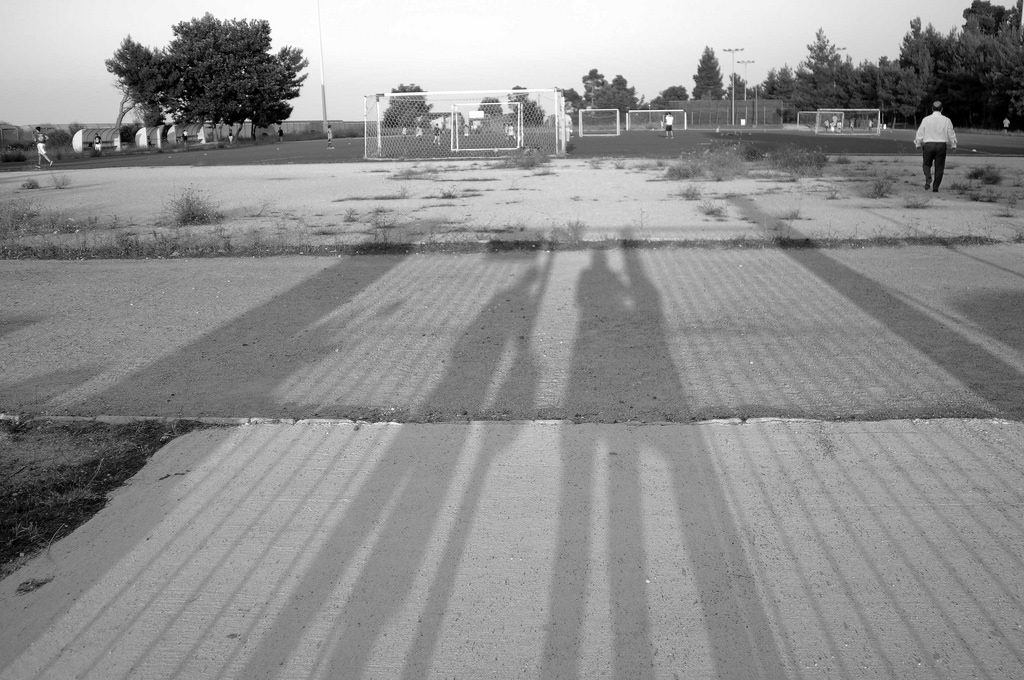
(The image thumbs its nose at genre—it is oblique self-portrait, landscape, social history, portrait and exploration of geometry and structure all at the same time.)
Shadows aside, the figures which catch my eye (what about you, so much to choose from or are you constrained in a similar way to me by something in the way the image is structured?) are the short stocky man in motion, walking away from us at the image’s far right top strip foreground. There’s a delicious swagger and confident openness about him.
Has he passed through the gate where R stands? Did he greet her?
The second key (perhaps because nearest?) figure is the young man, top strip, viewer’s far left, again in movement, this time almost certainly certainly sports related. Is he pursuing a stray ball? Running to greet a friend? Engaged in some sort of running warm up/exercise? As we strain to see, our relationship to the image’s scale shifts and we begin to realise just how many other figures he opens up to us—there are at least six either standing or seated in those little sheds at the field’s side between him and the left edge of the nearest goal net—each an enigma of a small but definite kind—and when we move rightwards from them we realise (and we have to move closer in, look differently, at the image to see this) just how many people there are in some sort of action here. As we move out again we are stuck by the contrast between the contemplative calm of the giant shadows and the anthill busyness of the young men. And here’s another thing. This is such a male photo. (With the exception of the photographer and I think it’s only because I know she is female that I read her as such. Then even as I write this I notice the slight head-cocked-to-one-side quality of aficionado-like attention in the head of the left shadow—and why do I think that might clue maleness? What does that say about me?) Oh! Layers and layers of fact, of presence, of things to enumerate and puzzle over. So much! And this before we take the thing as a totality—geometry, inhabitants, shadows, activity, motivation, time of day, distant trees, weeds and barren ground, a sky whose colour we can only guess from the fact we know there is evening sun. And that totality is the hardest thing to compass in any way other than an intake of breath or shiver down the spine. Enumerating the contents helps (although it’s not essential to the immediate affective apprehension of the whole—that just happens) but it’s the inexplicable (not a value judgement—literally inexplicable—simply, ‘This is what R did’) decision to frame those contents in that way—the bit of the process which defies words—that makes this and so many other pieces by her so powerful.
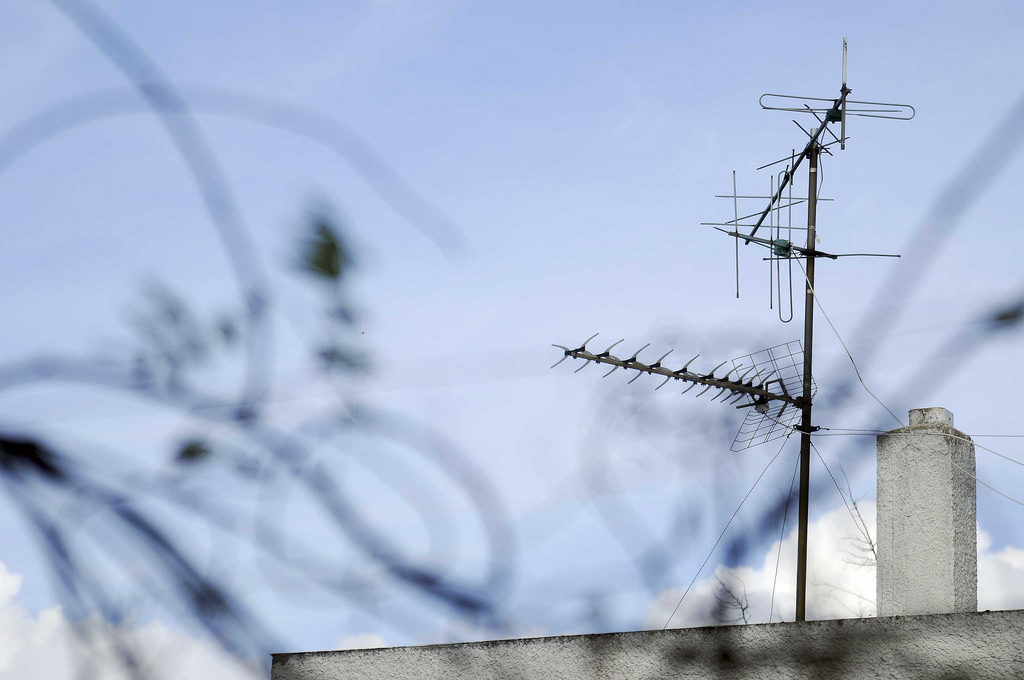
5.
A ravenous eye.
She has a ravenous eye, constantly tracking the scene in front of her and hungry for detail. This hunger does not distinguish between content and form. Whatever is human, whatever stirs affect or curiosity—whether pattern, rhyme or echo, or ethics, or suggested human warmth or frailty, this is swallowed up and processed by heart and mind in turn
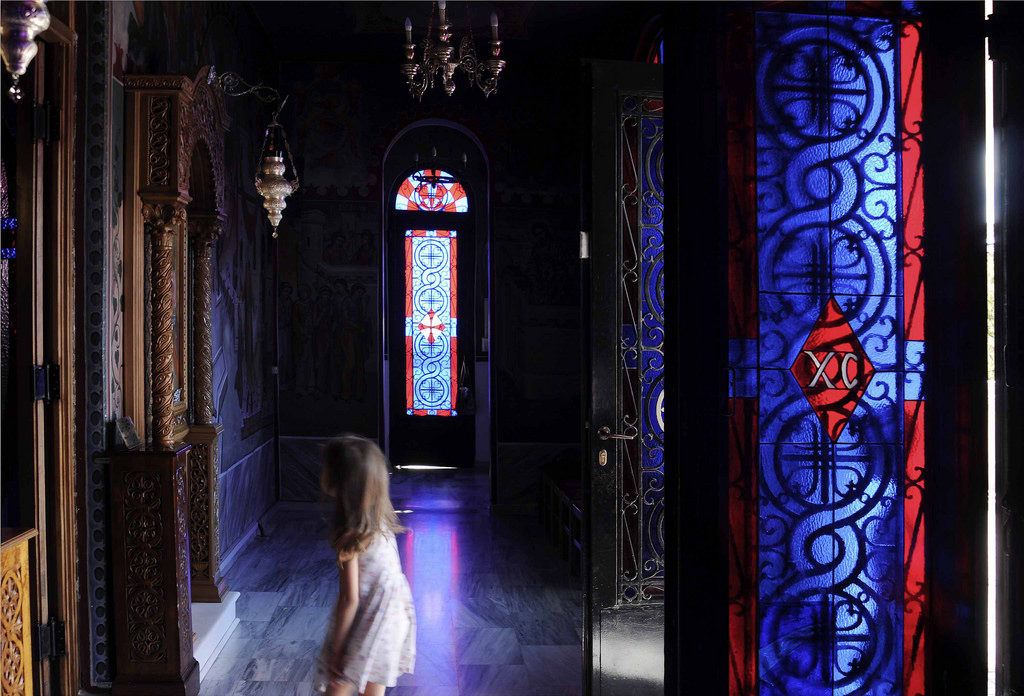
The resulting images bear the strong feel of certain, almost objective, structuring principles—that following of object or creature within a scene, the use of rhyme and echo. Two further categories are geometry and colour (and nothing here is pure, there are no essences, sometimes blocks of colour impose an extra, parallel geometry upon a scene whose first order sense—whether it be human beings in action or traces of interpretable human activity; buildings, signs, the street —apparently lies elsewhere.) The key thing about all these structuring principles is that they are found, excavated, discovered, seen—not made. They happen in parallel with, arise out of the actions and feelings of, human beings in this world, the only one we have.
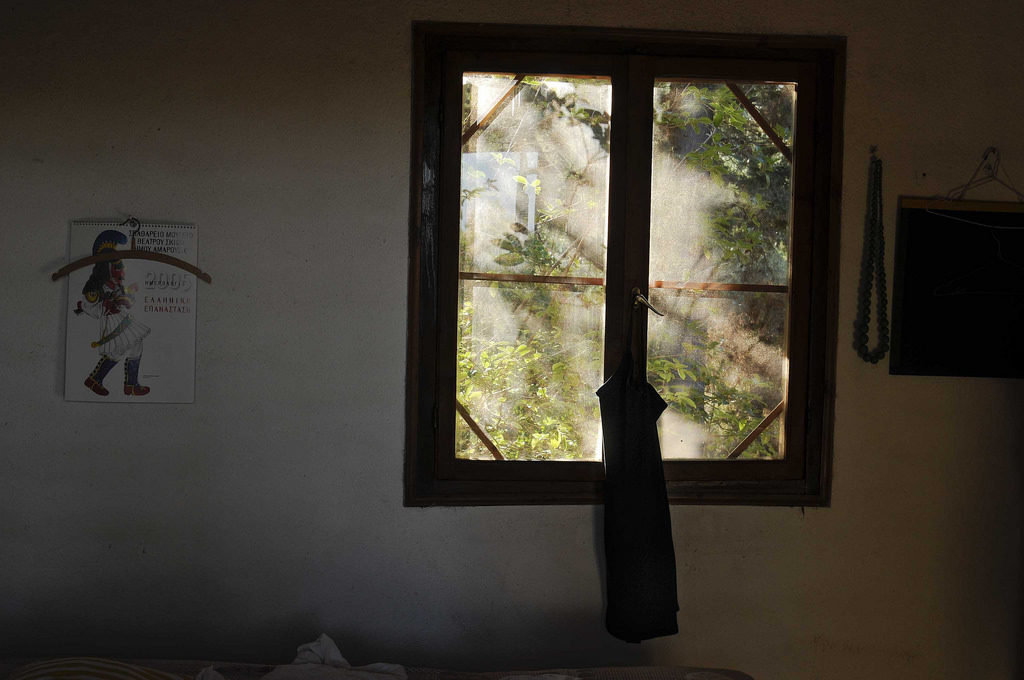
Because she is someone who has lived, fully, in that world, for a fair time, because her hunger extends beyond the visual (she always has a book on the go and the range of these is impressive), because she has a number of languages and is at home in at least three cultures, she makes images which are connected and re-connected by hundreds of threads to things we ourselves might have read and thought or experienced and talked about. Further, it is impossible to imagine that the fact she is a woman living in a country not of her birth, where she has learned a different script, different ways of talking and being, where she works in part as an image maker for hire and constantly both connects and holds separate that work for pay from own ‘own’ work, at the same time as raising children by herself, that these facts are not also somehow foundational.
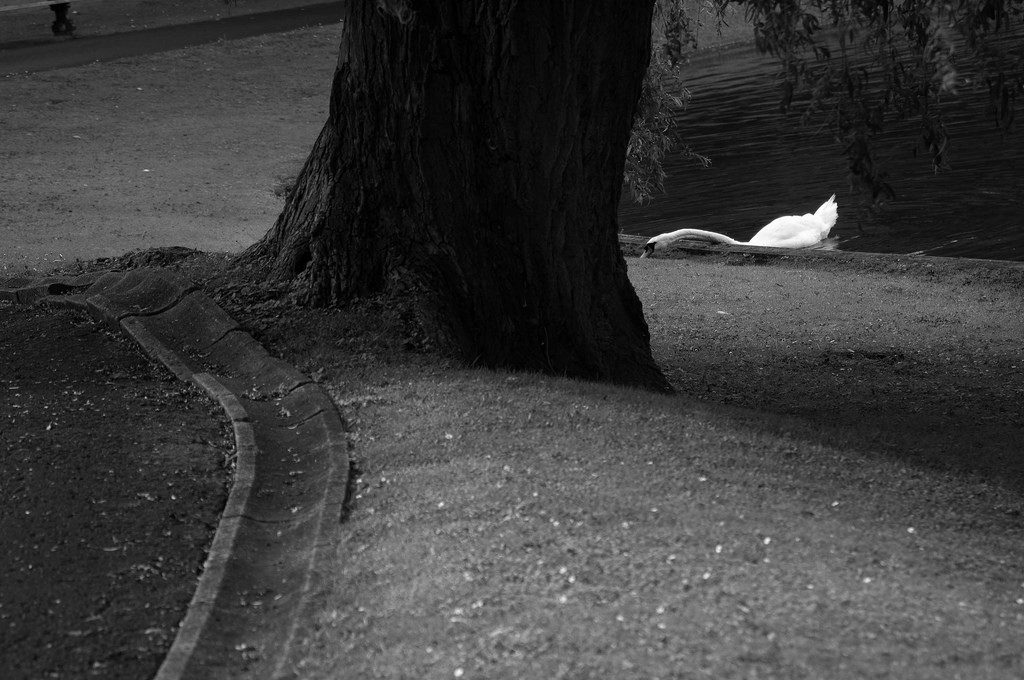
For a long time I have struggled with how to attach the word meaning to image. It is too easily and glibly used. An image never ‘means’ a single thing (unless it is the poorest of images and even then the human capacity for/delight in ambiguity sets to work to disrupt this) What is evident in Rudolph’s work is networks of evoked meaning, memories, feelings.
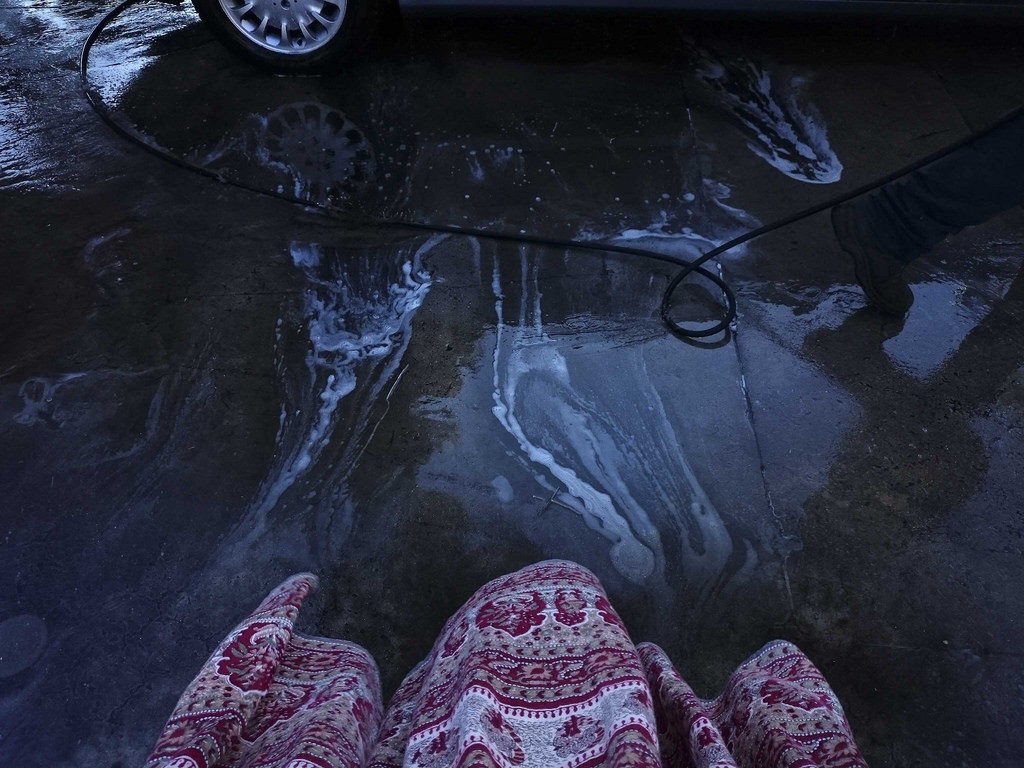
Her way of being in the world, this following her eye and nose, means that there is a kind of metonymy purged of any attempt at system—here is a dog or child or chair or window. Here are the things which necessarily were near it at a moment in time and this is how they were disposed. There was reason and there was randomness. Parts of the disposition were beautiful. (What do I mean by beautiful? They move me, they fill me with a joy that cannot be reduced to words though it perhaps can be limned by various combinations of words, combinations potentially infinite which always nearly but not completely fail.) Parts of the disposition were stark or threatening or at least worrisome. The bringing together of all these parts—worry, beauty, pattern, action—into an image framed, bounded, lit, by the laws of the heart and the laws of the intellect now pulling one way, now the other. The work about the world is itself part of the world. We are not alone. No person is an island. We can read each other’s thoughts. We can feel each other’s feelings.
The words and the image and human heart and human history dance ever outwards and outwards. What does an artist do but always start to write the whole history of humanity in the world?
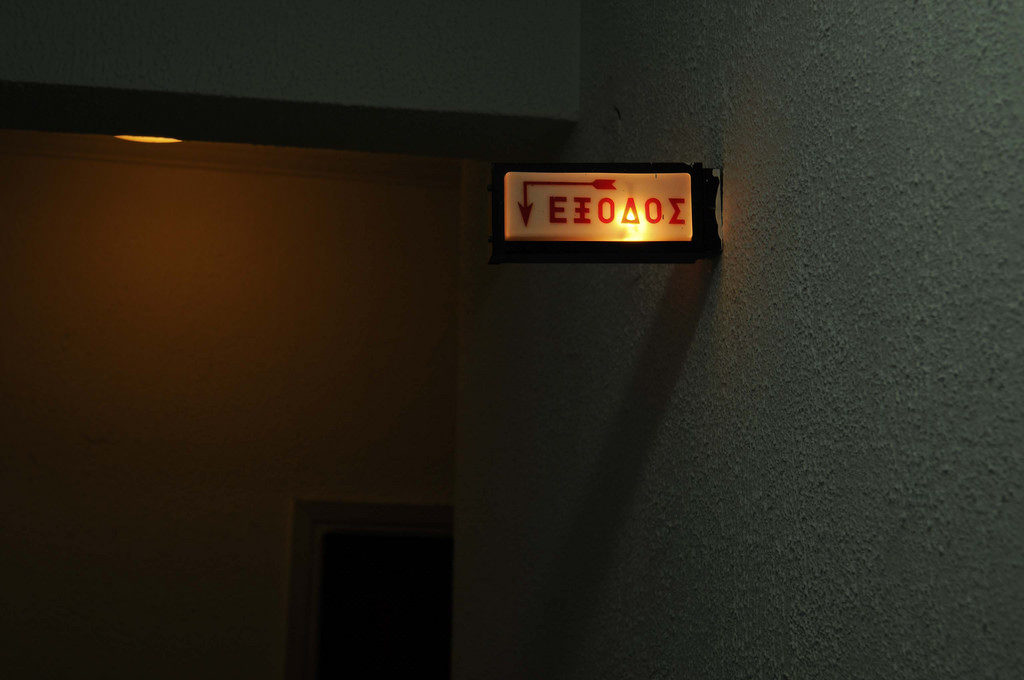
Through our interactions with digital devices and systems us humans are now a diverse resource to other humans and machines. And we are changing in accordance with the processes and demands of contemporary, technological market systems, designed to extract as much data from us as possible. In his recent article Our minds can be hijacked, Paul Lewis of the Guardian revealed that those in the know, those who helped to create Google, Twitter and Facebook, are now disconnecting themselves from the Internet as, like millions of people in the world, they are feeling the effects of addiction to social networking platforms, and fear its wider consequences to society.
The hazards of this kind of tech-contagion have been the staple food of sci-fi for decades – a mysterious woman shares a strange but simple VR game in the 1991 episode of Next Generation Star Trek, The Game. It spreads like wildfire, taken up with enthusiasm by the crew, only later revealed to be a brainwashing tool invented by an alien captain to seize control of first the ship, and then all of Starfleet. Let’s look at ourselves for a moment – if we can tear our gaze away from our screens. How has our public behaviour changed – on the streets, on public transport, in buildings and parks? Our attention transfixed by our devices, online via our phones and tablets – bumping into each other, and even walking into the road endangering their own and others’ lives.
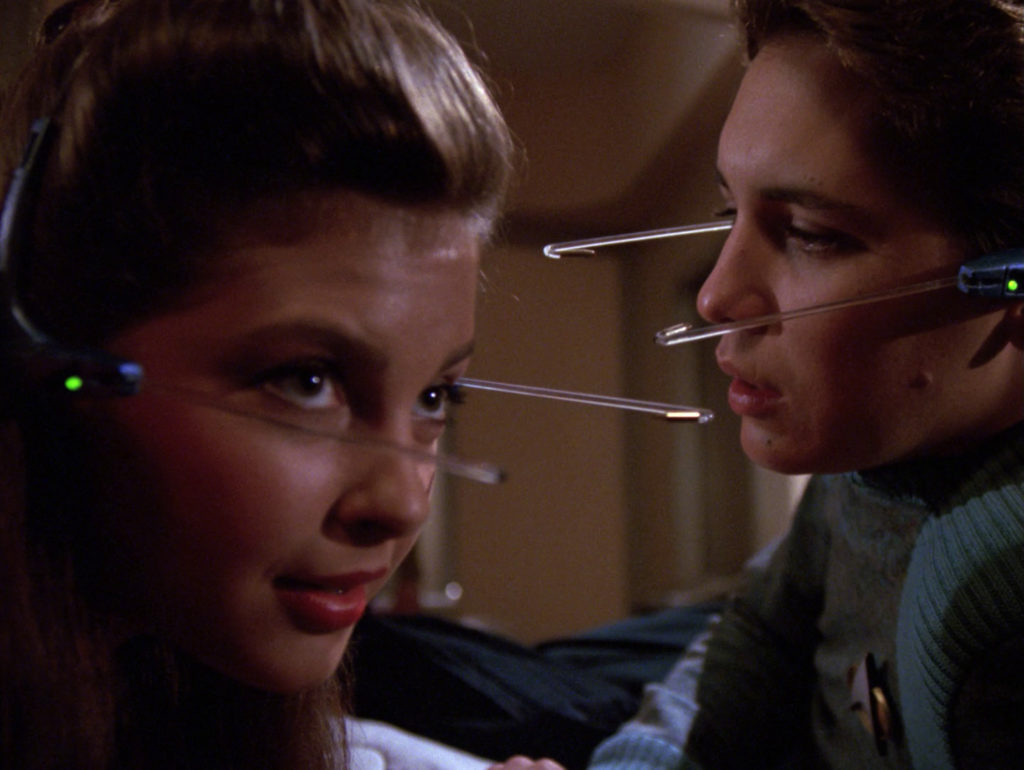
Professor of psychology Jean M. Twenge studies post-millennials and argues that a whole younger generation in the US, would rather stay in doors than going out and partying. Even though they are generally safer from material harm they are on the brink of a mass mental-health crisis. She says this dramatic shift in social behavior emerged at exactly the moment when the proportion of Americans who owned a smartphone surpassed 50 percent. Twenge has termed those born between 1995 and 2012, as generation iGen. With no memory of a time before the Internet, they grew up constantly using smartphones and having Instagram accounts. In her article Have Smartphones Destroyed a Generation? Twenge writes “Rates of teen depression and suicide have skyrocketed since 2011. It’s not an exaggeration to describe iGen as being on the brink of the worst mental-health crisis in decades. Much of this deterioration can be traced to their phones.”
Internet addiction is like having your head perpetually inside a magical mirror of hypnotically disembodying power #addictsnow pic.twitter.com/DFkl1jaKER
— furtherfield (@furtherfield) August 31, 2017
From the #addictsnow Twitter commission by Charlotte Webb and Conor Rigby, 2017
We offer three features as part of Furtherfield’s 2017 Autumn editorial theme of digital addiction, in parallel with the exhibition Are We All Addicts Now? at the Furtherfield Gallery, until 12th November 2017. Artist Katriona Beales has developed the exhibition and events programme in collaboration with artist-curator Fiona MacDonald: Feral Practice, clinical psychiatrist Dr Henrietta Bowden-Jones, and curator Vanessa Bartlett. She explores the seductive qualities, and the effects of our everyday digital experiences. Beales suggests that in succumbing to on-line behavioural norms we emerge as ‘perfect capitalist subjects’ informing new designs, driving endless circulation, and the monetisation of our every swipe, click and tap.
Firstly we present this interview with Katriona Beales* from the new book Digital Dependence (eds Vanessa Bartlett and Henrietta Bowden-Jones, 2017) in which she discusses her work and her research into the psychology of variable reward, “one of the most powerful tools that companies use to hook users… levels of dopamine surge when the brain is expecting a reward. Introducing variability multiplies the effect” and creates a frenzied hunting state of being.
Pioneer of networked performance art, Annie Abrahams, creates ‘situations’ on the Internet that “reveal messy and sloppy sides of human behaviour” in order to awaken us to the reality of our networked condition. In this interview, Abrahams reflects on the limits and potentials of art and human agency in the context of increased global automation.
Finally a delicious prose-poem-hex from artist and poet Francesca da Rimini (aka doll yoko, GashGirl, liquid_nation, Fury) who traces a timeline of network seduction, imaginative production and addictive spaces from early Muds and Moos.
“once upon a time . . .
or . . .
in the beginning . . .
the islands in the net were fewer, but people and platforms enough
for telepathy far-sight spooky entanglement
seduction of, and over, command line interfaces
it felt lawless
and moreish
“
And a final recommendation – The Glass Room, curated by Tactical Tech
Tactical Tech are in London until November 12 with The Glass Room, exhibition and events programme. A fake Apple Store at 69-71 Charing Cross Road, operates as a Trojan horse for radical art about the politics of data and offers an insight into the many ways in which we are seduced into surrendering our data. “At the Data Detox Bar, our trained Ingeniuses are on hand to reveal the intimate details of your current ‘data bloat’; who capitalises on it; and the simple steps to a lighter data count.”
*This interview is published with permission from the publishers of the book Digital Dependence edited by Vanessa Bartlett and Henrietta Bowden-Jones, available to purchase from the LUP website here.
‘We had a dream last night, we had the same dream'[1]

I’m looking for a new love, a mouth that promises . . .
once upon a time . . .
or . . .
in the beginning . . .
the islands in the net were fewer, but people and platforms enough
for telepathy far-sight spooky entanglement
seduction of, and over, command line interfaces
it felt lawless
and moreish
wandering into the maw of the feast
in the realm of the Puppet Mistress, 1995
speech acts, sex acts, strange pacts
squirreled away in buffer logs and pasted Pine trails
weaving 1001 nights of Puppet Mistress tales
never on the down-low
was this most splendid DIWO
permission granted,
always, all ways
read write execute
reeds rites hexecutes
I was Alice clasping the little bottle labeled ‘DRINK ME’
becoming-Sufi, heady with some love-like like love emotions
juiced up jouissance
psychosomatic investigations
psi psi psi
ψ ψ ψ
sigh
seeking the difference/s
if any
between a suspected false binary
Virtual — Real — Life
difference
différance
different ants
worker queens snorting lines of flight
‘IRL’ (‘in real life’) prefaced conversations
whereas no-one said ‘IVL’
VL was the norm
so no need for a distinguishing preposition
whereas you needed to go somewhere, in, purposefully,
to get (back) to real life
Back to life, back to reality
Back to the here and now yeah
. . .
Back to life, back to the present time,
Back from a fantasy
Soul II Soul 1989
I ask Monstrous_Gorgeous (aka t0xic_honey @Lambda) to trawl through my stash of Moologs and MOOmails from my Lambda life, to search for signs of digital affliction. t0x’s forensic gaze (who eirself had been a keen Lambda queercoder back in the day) might be illuminating. GashGirl and her morphs(GenderFuckMeBaby, Madame_de_Clairwill, doll yoko, Rent_Boy, et al) had run amok and amongst simultaneous games, switching genders, personae and communicative registers as easily as children playing ‘let’s pretend‘. The best game was that between Puppet Mistress and her Puppet (aka YourPuppet). Today the language seems quaint, The Difference Engine meets The Pearl, steamy stream punk. All bonnets, bronze and tiny buttons.
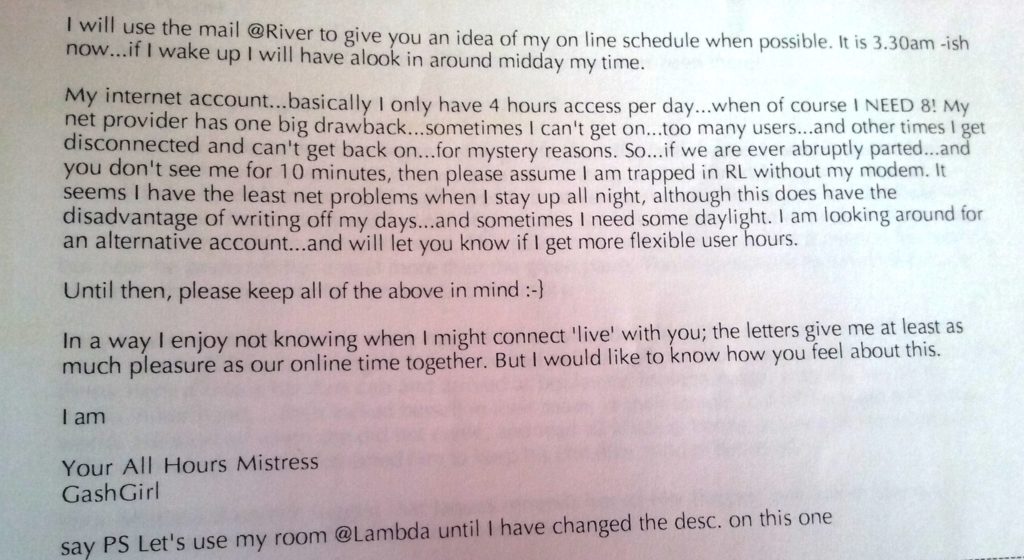
Wolf.
Homunculus.
Ghost.
Doll.
It’s a sky-blue sky.
Satellites are out tonight.
Let X=X.
Laurie Anderson 1982
does X=X?
or VL = zero?
with RL the one of ones, the one and all,
the only one (of all possible lives)
I think not!
t0x phones me, recounting episodes that I cannot recall, but which are so in-character I have for sure they happened. Like when I punished My Puppet severely for daring to speak with t0x about her in-MOO peep show. Now we can laugh about it, now that the field lies fallow, but at the time I was furious. Living at (on? in?) LambdaMOO did not diminish affect or emotion, but rather it intensified thought, sensation, desire, need.
can we call this addiction?
or obsession?
compulsion maybe?
I chatted this week with Jon Marshall, my anthropologist friend and author of Living on Cybermind (an ethnography of a mailing list), about how it felt more like a habit than an addiction. He talks about personally accumulated habits and socially accumulated habits. Humans are constructed of habits, including the habits that you build up around internet use. We recall the ‘Rape in Cyberspace‘ event at LambdaMOO; ‘that story becomes a myth that guides behaviour’, suggests Jon. My habit would not have led to such intense encounters, if all of us lot had not been sharing a gravitational pull to the glimmering galaxies of spiralspace. My twin talks about habit lying at the junction of nature and nurture, opening up another line for future investigation. Never enough time. Instead I loaf around on Netflix with Terrace House: Boys & Girls in the City.
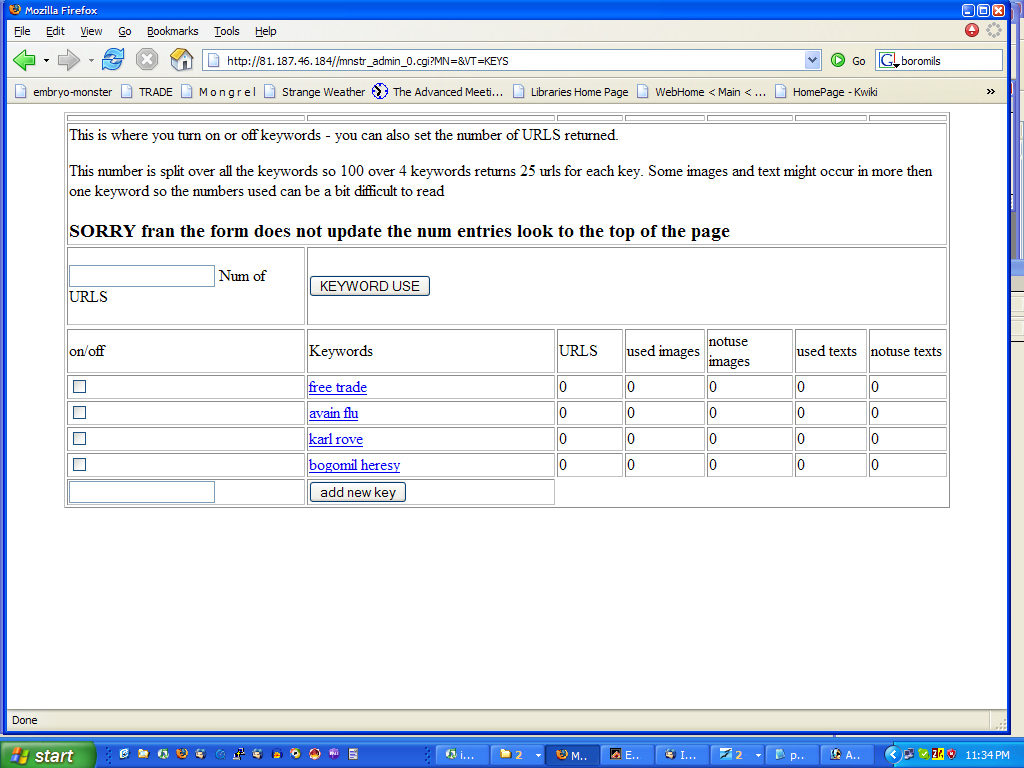
for me the habit of MOO (Mu) was quickly formed,
and devastating to desert
Ripping through a damaged heart
in the best of daze
circa 1992 93 94 95 96
(=3)
I didn’t leave home
a charming house with a white peach tree, goblin hut
and a dial-up 14,400 modem usurping landline’s phone functionality
for years I burrowed in through a borrowed log-in
J (aka connie_spiros @Lambda) pounds on front door to kick me off
later I jumped onto a free account offered by community provider apana
through its tiny sibling sysx (thank you Scott and Jason)
part of a tribe meshwork of cool sysops animating .net
motivated by the conviction of net access for all
xs4all
excess for real
S (aka Quark @Lambda) told me how depressing it was to leave home at 7.30am seeing me already jacked in, and to find me still in pajamas at dinner time, a sure sign that I hadn’t stepped away from the computer all day.
frequently he’d say ‘What’s wrong with this picture?’
(rhetorical)
5 words yanking me from my fugue
to discover myself pretzeled around the machine
in a position so unnatural it had become natural
to a life lived more and more in a VL that had become my RL
there was a vastness to the generative affective experiences
it felt unstoppable
on par with the most exhilarating love affairs
continual platform jumping
(don’t mind the gaps)
with unseen but deeply imagined companions
haunting me from nautical twilight to nautical twilight
netmonster, 2005
The only platform that came close to the seductiveness of Lambda was Netmonster, a network visualisation engine built by artist coder tinkerer Harwood (aka Graham Harwood). I was fascinated by the code and what it could do. And I adored the constant communication with my bruvv, the one who calls me ‘witch sister’. We hung around on the server, chatting white text on black screen. I made him a self-executing poem in Perl, my one and only attempt to learn some rudiments of that language. Netmonster could be a machine for collaborative writing, for prophesy, a tool for poking around in the machinations of power and capital. I imagined its transformative potential on a magical level, casting silver spanners into the bellyworks of the Beast. As a user I became tangled in search strings questing for the grail of understanding. Without knowing what I was asking, I pushed Harwood to push the code, Perl, to do things it wasn’t designed to do. The machine groaned under the weight of requests, and eventually its interactive functionality was turned off (brutal!), leaving just a beautiful hyperlayered carapace online. The emptiness I felt when the living essence of the project was no longer was comparable to the hole of grief when a lover says it’s over. The spirit of Netmonster had left forever. I was alone again.
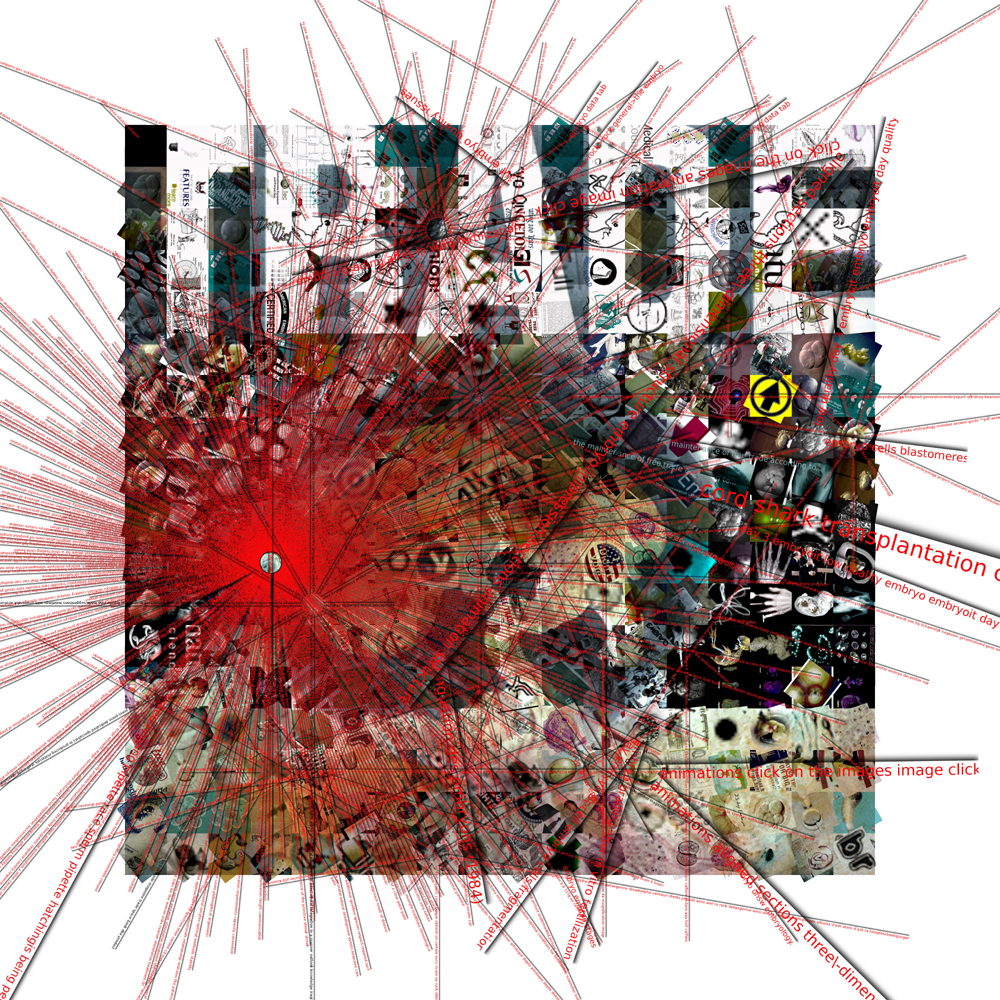
clever little tailor, 2017
There’s a few of us chatting around a table in Clever Little Tailor, an affordable bar if you stop after one drink. Around the table S2 (artist/student, early 20s), A (poet/singer/student maybe just grazing 25), and a couple of ancient cyberwitches. We speak about imbuing inanimate objects, a child’s wooden horse, a Persian rug, with magical powers, to speak, to fly. The human tendency to want to create life in things, including things and wings of internet, and this predisposition in turn enlivens and expands us. The topic turns to matters of the heart, and native/natal platforms. Those communicative modes that either we were born into or grew into, the sticky tongue finger techs that we associate with our netted emotional and social lives. We talked about coding and not coding, about the need to live online, and the impulse to desert it. Instant Messaging is for S2 what Internet Relay Chat was for us. We spell out the spell of Command Line Interface in a condensed version of how we uploaded ourselves to the song of the modem, waiting up all night to be able to play, existing betwixt and between multiple time zones. We struggle to find the right words (because the material of this stuff is made of words but is so not about words really) to evoke the deliciousness of what was a relatively uncolonised uncommodified unregulated ineffable space. Even if we hexen rarely use the word ourselves, the neologism (and who could forget Neo!) cyberspace, continues to signify the consensual hallucination of jacking in to the zone. Maybe now it’s more mall than sprawl for us who experienced something more unbounded, but for the next gens the intensities, the desires are equivalent.

17.10.17
forever doll
becoming witch
she opens her mouth
and swallows the world
she opens her mouth
and swallows your word
dissolving like spun sugar
laced with saffron threads
hexe hexe hexe
tiva! tiva! tiva!
naughty naughty naughty
all for naught
and nought for one
zero and one
zeno and won
one on one on one
on and on and on . . .
Thank you to old and new friends whose ideas have nourished this text: Virginia Barratt, Alison Coppe, Linda Dement, Teri Hoskin, Jon Marshall, Stuart Maxted, John Tonkin. Big thanks to (bruvv) Graham Harwood for inviting me to play and live inside Netmonster in 2005.
Francesca da Rimini (aka doll yoko, GashGirl, liquid_nation, Fury) is an interdisciplinary artist, poet and essayist. She revels in collaborative projects, joining companions in generating slow art, strange beats and new personae. As co-founder of cyberfeminist group VNS Matrix she contributed to international critiques of gender and technology. The award-winning dollspace deployed the ghost girl doll yoko to lure web wanderers into a pond of dead girls. As GashGirl/Puppet Mistress, she explored the uploaded erotic imagination of strangers at LambdaMOO. More recent performances , collaborations and installations including delighted by the spectacle, hexecutable, songs for skinwalking the drone, hexing the alien, and lips becoming beaks have combined rule-driven poetry, fugue states, spells and prophesies as hexes against Capital.
“Certain subjects compel me – alchemy, folklore/folk law, emancipatory social experiments, the nature of cognition, and states of ‘madness’ and ecstasy. I approach art-making as a hexing, a spell, a witch’s ladder to another realm. To paraphrase anarchist anthropologist David Graeber, a revolutionary act is to behave as if one were free.” da Rimini
“Hello, I’m Riz Lateef. Tonight our top story: Instagram travel-star Amber Hinton is missing in Indonesia. Initial reports suggest she has been kidnapped by an ISIS faction operating in the region. We’ll have more on that after the headlines.”
In 2014 Amber Hinton left a lucrative job in finance to follow her ‘dream’ of travelling the world. Like many young women she recognised the potential inherent in her looks; she had an ability to tap into veins of social media, and grasped the appeal for people to ‘follow’ in her footsteps. Educated, professional and dedicated she began by surveying Twitter and Instagram; filtering by hashtags she categorised countries by cultural capital (aka likes, retweets, comments) and then cross referenced with existing coverage. Logic followed that if Thailand was hot right now it might not be hot in a year’s time. Novelty and newness would be essential to getting a foothold in the market.
After months of post-work spread-sheeting, Amber was ready. At a brunch with friends she introduced a mood-board and sales-pitched her new life. I say mood-board, but really I mean a highly aestheticised business strategy. She’d categorised hundreds of travel lifestyle pics and identified core principles of success. With Google Analytics she’d examined the lifespan of a hashtag. She’d reviewed where successful Instagram travellers had been, which countries were oversaturated and which were primed to explode. She’d mapped a route, ensuring a balance between city, beach and country, simultaneously factoring in cost efficiency. She’d prototyped a website and employed a graphic designer to mock up a look and feel for her personal ‘brand identity’. She’d run financial predictions, how long her start-up capital would last, how she expected to turn a profit through funding websites, travel blogging, and eventually as an advertising service for hotels and travel companies.
It was, in short, a stunning piece of work. If Amber had been inclined towards the monastic life of a PhD researcher, she could have turned it into four years paid writing, then subsequently taught her findings at Oxbridge without ever leaving the UK.
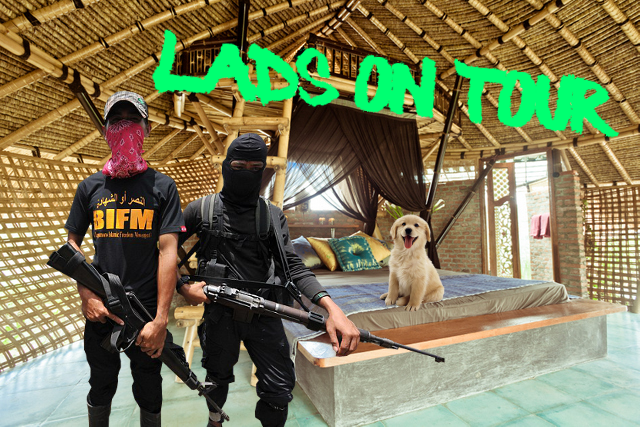
With her friends’ enthusiasm and her parents’ consent Amber left for Italy. Between 2014 and 2017 she travelled across the world, first moving in small steps, from Italy to Slovenia, to Bulgaria and Turkey. From Turkey she jumped around the Middle East and North Africa, avoiding conflict zones and skipping countries whose religious codes might frown upon her displayed body. Everywhere she went she befriended new contacts to utilise, chic twenty-somethings who’d invite her to their parents’ villas, rich bankers who’d get her into rooftop parties. Courting the cultural elite was vital; she didn’t have the financial reserves to fund a lavish lifestyle, but she could enter those worlds and achieve an image of effortless glamour.
By the time she reached the Moroccan coast she’d amassed over 75K followers. Enough to be on the radar of international PR girls. Invitations started flying in: five star luxury hotels and exotic adventures. Whilst sipping alcohol-free cocktails and bronzing her skin, she strategised her next move.
She flew to Malta, then across the Atlantic, island-hoping round the Caribbean. In America she visited boutique ranches and hunted down bohemian culture. Down to Mexico, then South America, a perfect blend of high class living and poverty porn. From South America she crossed the Pacific, stopping in at Hawaii on the way, then modern China and finally, in early 2017, Indonesia.
The world first knew something had gone wrong for Ms Hinton was when she posted a unusual message on Twitter. For three days she’d been five star eco-glamping in the rain-forested hills of Lombok, swimming in waterfalls, taking selfies with monkeys and then suddenly:
@amber_abroad
I heard a gun shot! What do I do! HELP HELP HELP
Minutes later a second tweet followed:
@amber_abroad
They said my name, tell me parents I love them
Within minutes a storm of activity was echoing around the Twitter-sphere and #saveamber was the number one trending topic on social media. Facebook campaigns began and Indonesian public officials were receiving flak from latte drinking yuppies in North London. By the second day the Foreign Office had publicly announced that British tourists in Indonesia were advised to leave the country immediately. Typically slow to respond, but then absolutely committed, ISIS announced that Ms Hinton’s abduction had been orchestrated by them, despite it obviously being carried out by a unassociated cell with little to no connection with the upper echelons. For three consecutive days BBC Breakfast News dedicated a half hour to the unfolding crisis; they even flew Naga Munchetty out to Bali to goad tourists into overreactions.
Five days of media fixation were followed by a week of not giving a damn; then out of the blue something very odd began to happen. Instagram accounts operating out of the Indonesian and Philippine ISIS territories started taking on a much more aesthetically sensitive tone. Poorly photoshopped images were replaced with a wave of creative shots. Against verdant jungle foliage, handsome young fighters were pictured topless, sweat glistening on their ripped pecks, rifles casually held over their shoulders. Puppies were photographed wrapped in ISIS flags. Trope travel images, ‘everyone jumping on the beach together’ and ‘girl leading boy’, were bastardised into calls to martyrdom.

At first Amber’s family was relieved; their daughter was alive and communicating with the world. Security services reassured them that eventually she would reveal her position, then they’d be able to plan her rescue. Weeks developed into months and still it seemed Amber was so tightly under the thumb of her captors that she couldn’t encode a message. All they could do was watch her PR strategy unfold.
Back home Theresa May used the crisis to spearhead her personal campaign against social media giants and internet freedoms. “By doing nothing, Instagram encourages ISIS”. In truth they were shutting down hundreds of accounts each day and actively handing data to the NSA and GCHQ.
By the time a video appeared online, ‘Amber’s Top 5 Tips For The Perfect Jihadi Pic’, Theresa had reached her line in the sand. Co-ordinating with the Indonesian President Joko Widodo, Ms Hinton was marked a priority target. If and when they had a lock on her location, an American drone would strike.
The final Instagram post attributed to Ms Hinton was posted on the 25th of June 2017.
For three weeks MI6 had been working in close communication with Indonesian intelligence officials to triangulate her location, scrutinising every post for a telltale clue. Eventually it was a sun umbrella that gave her away; its pattern of red and yellow stripes was attributed to a hotel on a recently occupied island. The post was confirmed as being a Amber original due to her characteristic use of the Juno filter and the Smiling Cat Face With Heart-Eyes emoji.
Amber’s parents were never told the truth about their daughter’s death. Several months afterwards a nice man from the intelligence services told them they believed ISIS had killed her, citing a lack of posts as evidence. Communications were falsified when they demanded proof. They were never shown the photos of her charred scalp, or the one of her left foreleg on the beach; it’d be blown clean clear of the hotel. In the end only a few people, in secret rooms, ever saw the evidence. None of the photos ever made their way online.
The New Observatory opened at FACT, Liverpool on Thursday 22nd of June and runs until October 1st.
The exhibition, curated by Hannah Redler Hawes and Sam Skinner, in collaboration with The Open Data Institute, transforms the FACT galleries into a playground of micro-observatories, fusing art with data science in an attempt to expand the reach of both. Reflecting on the democratisation of tools which allow new ways of sensing and analysing, The New Observatory asks visitors to reconsider raw, taciturn ‘data’ through a variety of vibrant, surprising, and often ingenious artistic affects and interactions. What does it mean for us to become observers of ourselves? What role does the imagination have to play in the construction of a reality accessed via data infrastructures, algorithms, numbers, and mobile sensors? And how can the model of the observatory help us better understand how the non-human world already measures and aggregates information about itself?
In its simplest form an observatory is merely an enduring location from which to view terrestrial or celestial phenomena. Stone circles, such as Stonehenge in the UK, were simple, but powerful, measuring tools, aligned to mark the arc of the sun, the moon or certain star systems as they careered across ancient skies. Today we observe the world with less monumental, but far more powerful, sensing tools. And the site of the observatory, once rooted to specific locations on an ever spinning Earth, has become as mobile and malleable as the clouds which once impeded our ancestors’ view of the summer solstice. The New Observatory considers how ubiquitous, and increasingly invisible, technologies of observation have impacted the scale at which we sense, measure, and predict.
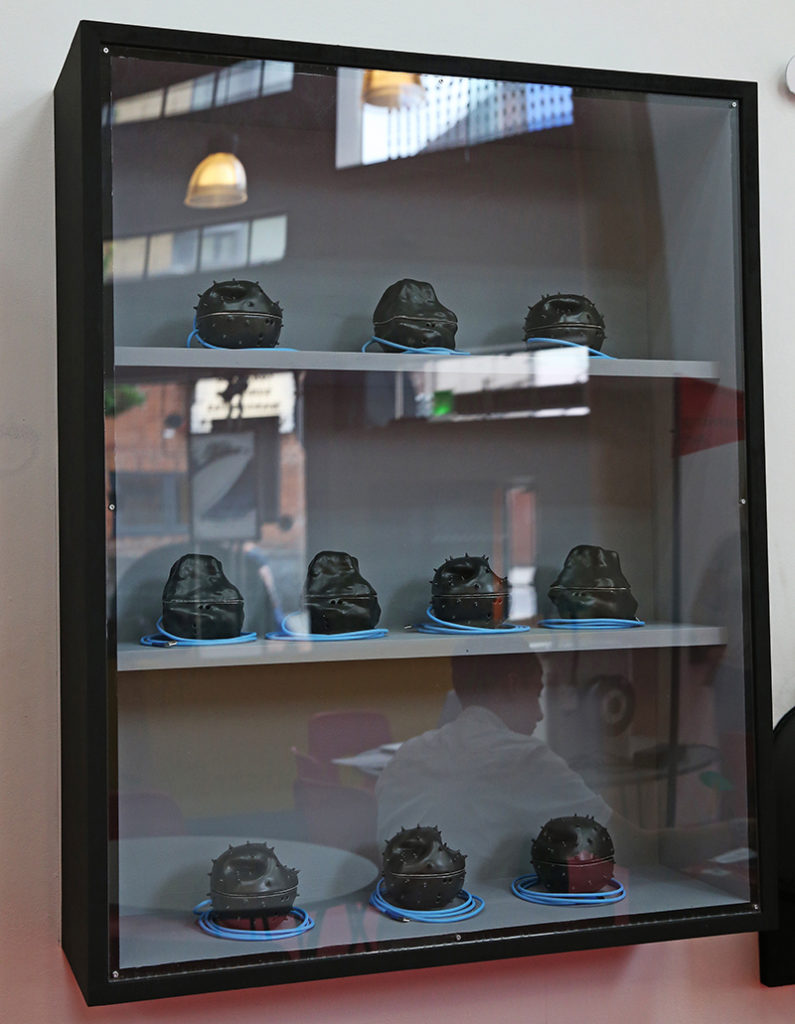
The Citizen Sense research group, led by Jennifer Gabrys, presents Dustbox as part of the show. A project started in 2016 to give residents of Deptford, South London, the chance to measure air pollution in their neighbourhoods. Residents borrowed the Dustboxes from their local library, a series of beautiful, black ceramic sensor boxes shaped like air pollutant particles blown to macro scales. By visiting citizensense.net participants could watch their personal data aggregated and streamed with others to create a real-time data map of local air particulates. The collapse of the micro and the macro lends the project a surrealist quality. As thousands of data points coalesce to produce a shared vision of the invisible pollutants all around us, the pleasing dimples, spikes and impressions of each ceramic Dustbox give that infinitesimal world a cartoonish charisma. Encased in a glass display cabinet as part of the show, my desire to stroke and caress each Dustbox was strong. Like the protagonist in Richard Matheson’s 1956 novel The Shrinking Man, once the scale of the microscopic world was given a form my human body could empathise with, I wanted nothing more than to descend into that space, becoming a pollutant myself caught on Deptford winds.
Moving from the microscopic to the scale of living systems, Julie Freeman’s 2015/2016 project, A Selfless Society, transforms the patterns of a naked mole-rat colony into an abstract minimalist animation projected into the gallery. Naked mole-rats are one of only two species of ‘eusocial’ mammals, living in shared underground burrows that distantly echo the patterns of other ‘superorganism’ colonies such as ants or bees. To be eusocial is to live and work for a single Queen, whose sole responsibility it is to breed and give birth on behalf of the colony. For A Selfless Society, Freeman attached Radio Frequency ID (RFID) chips to each non-breeding mole-rat, allowing their interactions to be logged as the colony went about its slippery subterranean business. The result is a meditation on the ‘missing’ data point: the Queen, whose entire existence is bolstered and maintained by the altruistic behaviours of her wrinkly, buck-teethed family. The work is accompanied by a series of naked mole-rat profile shots, in which the eyes of each creature have been redacted with a thick black line. Freeman’s playful anonymising gesture gives each mole-rat its due, reminding us that behind every model we impel on our data there exist countless, untold subjects bound to the bodies that compel the larger story to life.
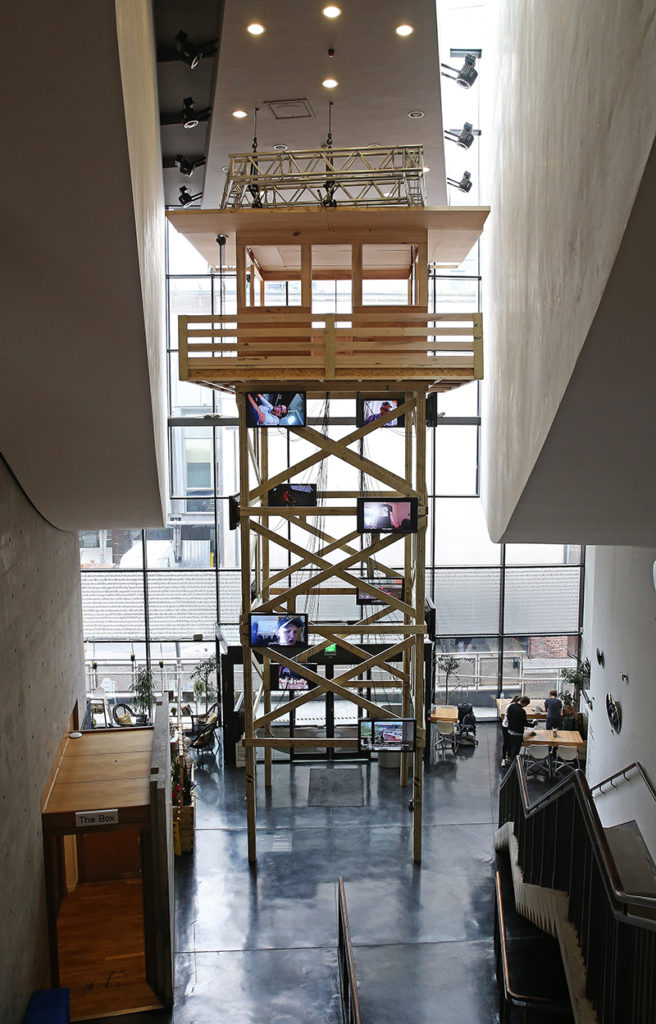
Natasha Caruana’s works in the exhibition centre on the human phenomena of love, as understood through social datasets related to marriage and divorce. For her work Divorce Index Caruana translated data on a series of societal ‘pressures’ that are correlated with failed marriages – access to healthcare, gambling, unemployment – into a choreographed dance routine. To watch a video of the dance, enacted by Caruana and her husband, viewers must walk or stare through another work, Curtain of Broken Dreams, an interlinked collection of 1,560 pawned or discarded wedding rings. Both the works come out of a larger project the artist undertook in the lead-up to the 1st year anniversary of her own marriage. Having discovered that divorce rates were highest in the coastal towns of the UK, Caruana toured the country staying in a series of AirBnB house shares with men who had recently gone through a divorce. Her journey was plotted on dry statistical data related to one of the most significant and personal of human experiences, a neat juxtaposition that lends the work a surreal humour, without sentimentalising the experiences of either Caruana or the divorced men she came into contact with.
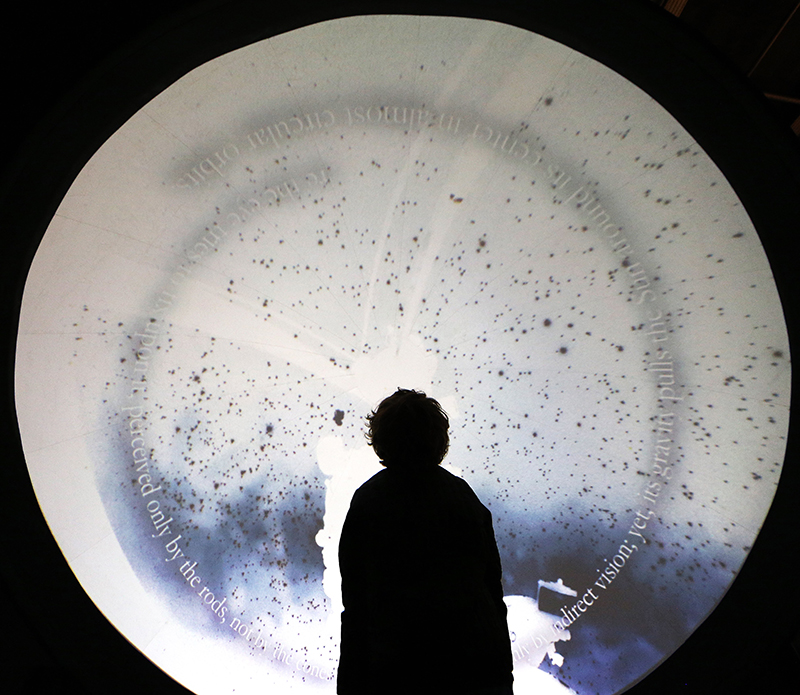
The New Observatory features many screens, across which data visualisations bloom, or cameras look upwards, outwards or inwards. As part of the Libre Space Foundation artist Kei Kreutler installed an open networked satellite station on the roof of FACT, allowing visitors to the gallery a live view of the thousands of satellites that career across the heavens. For his Inverted Night Sky project, artist Jeronimo Voss presents a concave domed projection space, within which the workings of the Anton Pannekoek Institute for Astronomy teeter and glide. But perhaps the most striking, and prominent use of screens, is James Coupe’s work A Machine for Living. A four-storey wooden watchtower, dotted on all sides with widescreen displays wired into the topmost tower section, within which a bank of computer servers computes the goings on displayed to visitors. The installation is a monument to members of the public who work for Mechanical Turk, a crowdsourcing system run by corporate giant Amazon that connects an invisible workforce of online, human minions to individuals and businesses who can employ them to carry out their bidding. A Machine for Living is the result of James Coupe’s playful subversion of the system, in which he asked mTurk workers to observe and reflect on elements of their own daily lives. On the screens winding up the structure we watch mTurk workers narrating their dance moves as they jiggle on the sofa, we see workers stretching and labelling their yoga positions, or running through the meticulous steps that make up the algorithm of their dinner routine. The screens switch between users so regularly, and the tasks they carry out as so diverse and often surreal, that the installation acts as a miniature exhibition within an exhibition. A series of digital peepholes into the lives of a previously invisible workforce, their labour drafted into the manufacture of an observatory of observations, an artwork homage to the voyeurism that perpetuates so much of 21st century ‘online’ culture.
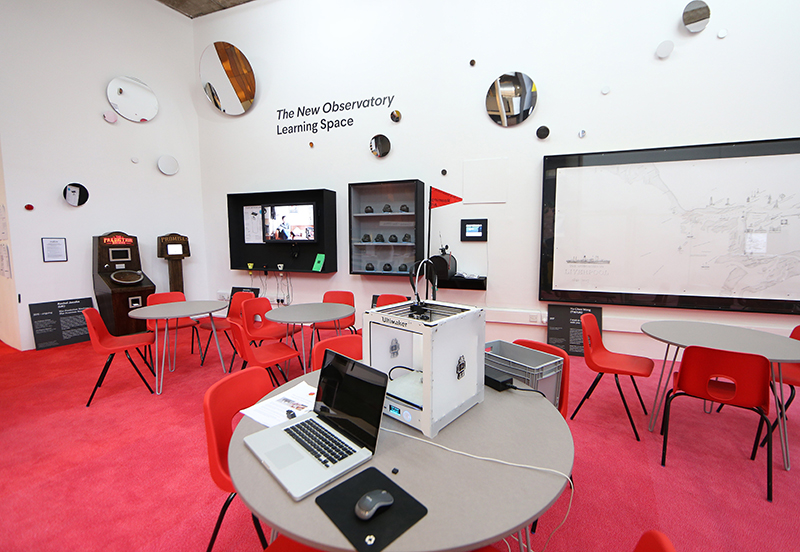
The New Observatory is a rich and varied exhibition that calls on its visitors to reflect on, and interact more creatively with, the data that increasingly underpins and permeates our lives. The exhibition opened at FACT, Liverpool on Thursday 22nd of June and runs until October 1st.
“In a world full of conflicts and shocks,” has the past year become the, arguably, most standardized introduction, preempting, in an almost doomsday manner, articles, political speeches and curatorial statements alike. The world has turned Political (with capital P) and even the most mundane event is quickly made part of current politics, which in turn, seems to occupy a space somewhere between reality TV and satire. One feels the same dreadful fascination as when watching accident videos on YouTube; with eyes hypnotically fixed to the screen as we observe our world digress into an ever-growing state of chaos. A general unease can be traced throughout the world, and even the most apolitical communities are mobilizing at each side of the spectrum, in the desperate search for ways to overcome the immediate and underlying threats-at-hand.
It is within this urgent search for solutions, that this year’s Venice Biennale positions itself. The 57th biannual gathering of today’s most prominent instances of Contemporary Art, offer, under the lead of curator Christine Macel, its own proposal as to how we might address our sometimes-hopeless situation. And, perhaps surprisingly, we are in fact given an answer, which eschews the otherwise often-ambiguous and overly-complicated musings traditionally marking the Art World. Within the manifesto of the biennale, immediately greeting you as you enter the Giardini venue located South of the City, Macel calls for a return to humanism, expressing the need for a new-found believe in the power and agency of humans. And not just any human; particular emphasis is given to the Artist, the persona through which, supposedly, “the world of tomorrow takes shape.”
Structurally, the role of the artist is explored over the course of nine chapters, spanning themes as distinct as ‘earth’, ‘colors’ and ‘time and infinity’. Each, we are told, does not only account for the artist’s practice in isolation, they further set out to investigate how such creative acts resonate and bring about change in the world.
One misses immediately this latter concern within the two first pavilions Artists and Books and Joys and Fears. We are invited into the space and mind of the artist, in what quickly becomes an introvert, almost nostalgic account of the studio, presented here as a place which escapes the neoliberal ideals of progress and productivity. One senses an immediate contradiction, being surrounded by pieces which literally embody the immaterial value so indicative of modern capitalism.
This haunting sense of conflict is occasionally placated, if only because many of the individual pieces go further than the prescribed curation, integrating a sense of criticality in their exploration of the art practice. As in the breathtaking video by Taus Makhacheva, in which a tightrope walker carries paintings between two cliffs, over a lethal fall, seemingly free, while caught in a pointless, repetitive and dangerous act, dictated by guidelines which goes beyond his immediate control. Or in the, now infamous work, by John Walter, Study Art Sign, which appropriates the language of advertisement in simple catch phrases such as “art – for fun or fame,” and in doing so, highlights the entanglement of any artistic act with commercial viability.
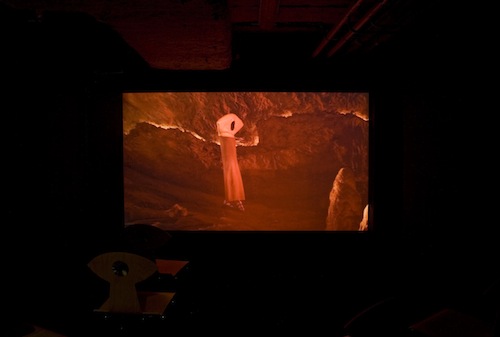
A 20-minute walk, and the habitual crossing of at least 5 Venetian bridges, brings you to the Arsenal pavilions, and the home of the next 7 chapters. The first two of these, Commons and Earth, are (at least superficially) more successful in exploring the link between the artist and the world at large. The exhibited pieces are centered around the creation of community or situations. They echo in this sense the much-disputed Relational Aesthetics as advocated by Nicolas Bourriaud, which defines contemporary art, as one of “interactive, user-friendly and relational concepts.”(1)
What Bourriaud and the Biennale both seem to overlook, is the inescapable mediation and exclusivity of artistic acts, despite any willingness to advocate inclusivity and openness. Because, let’s face it, none of the presented practices can be equaled to just another social situation – each and single one has been extensively documented, carefully edited and analyzed, to finally make their way into one of the most prestigious temples of contemporary art: The Venice Biennale anno 2017.
This does not make them insignificant, it simply means that one cannot feign apparent neutrality, as the emphasis on ‘anthropological approaches,’ seems to suggest. In fact, the more ‘honest’ pieces are the ones which embrace such mediation, exposing it, rather than hiding it behind a layer of innocent interaction. This is done brilliantly in the video piece of Charles Atlas, A Tyranny of Consciousness – an epic compilation of sunsets, countdowns and disco. The groovy lyrics, ‘You were the one, I blew it, it’s my own damn fault,’ sung by the iconic drag queen Lady Bunny, is given new meaning in the context of environmental, human-provoked disasters.
This is done, while avoiding any moralistic undertones. Rather, the piece dares to reflect the ambiguity which defines the actual human-earth-relation, and through this, overcomes the simplified ‘if we all work together it’ll be fine’ attitude, otherwise permeating the majority of the exhibited work.
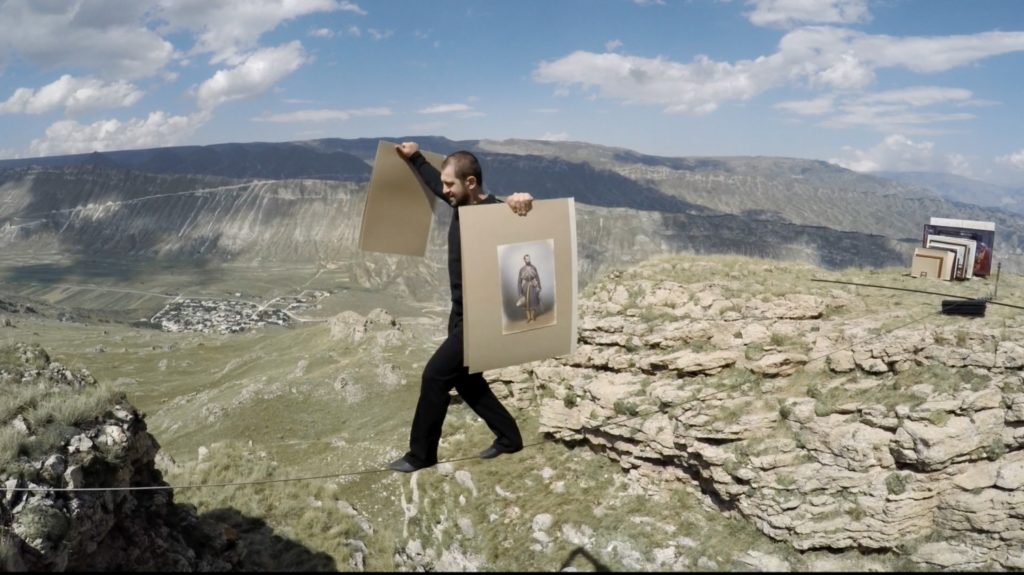
Within Traditions, the chapter following, the most successful pieces are similarly those which allow for complexity and move beyond an often much-too-obvious contrasting of the old with the new. One notable example, is the piece by Guan Xiao, which traces the famous statue David by Michelangelo. In bringing together numerous amateur-looking clips capturing this iconic figure, she humorously points to how objects ironically become invisible, through our extensive documentation of them; as hidden behind the connotations and expectations which come to shape the way we perceive our cultural heritage.
On entering the next theme of Shamanism, the first piece which meets the visitor is by Ernesto Neto – a tent-like installation made up of robes, under which guests are offered a place to rest. The otherwise beautiful piece come to look like a feature of Burning Man, with hippie-esque slogans such as ‘with love and gratitude to mother earth’ or ‘’war is not good, gold is life,“ covering the surrounding walls.
What Macel here wants to explore is the artist as magician or healer. While attempts of healing is sympathetic (and needed), such efforts are undermined by, a once again, rather naïve approach. It seems as if the striking similarity to the peace-promoting, but notoriously exclusive, festival is not only aesthetic. There is a failure at acknowledging the difference between giving the (very specific demographic of) biennale goers a place for momentary reflection, and the large-scale healing announced in the curatorial statement.
This pseudo-commitment to seventies politics carries over to the Dionysian Pavilion, which ‘celebrates the female body and its sexuality’. The decision to dedicate a pavilion specifically to female artists and femaleness implicitly tells us that
a) womanhood is still something distinct, which should be explored separately from other identity politics
b) women artists need their own space, neatly separated from the rest of the pavilion (which is, interestingly, dominated by male artists)
We see here not only a return to humanism, but the ugliest of humanisms, one which still insists on highlighting an assumed distinction between manhood and womanhood. Such essentialist undertones are only enforced by the first part of the pavilion which greets you with pastels, vaginas and a propensity for weaving.
While the theme might be questionable, we do, while moving through the pavilion, find some incredibly strong pieces, which insists on addressing the individual in its many nuances and confused nature. This is particularly present in the all-encompassing installation/sound/performance work of artists Pauline Curnier Jardin, Mariechen Danz and Kadar Attia.
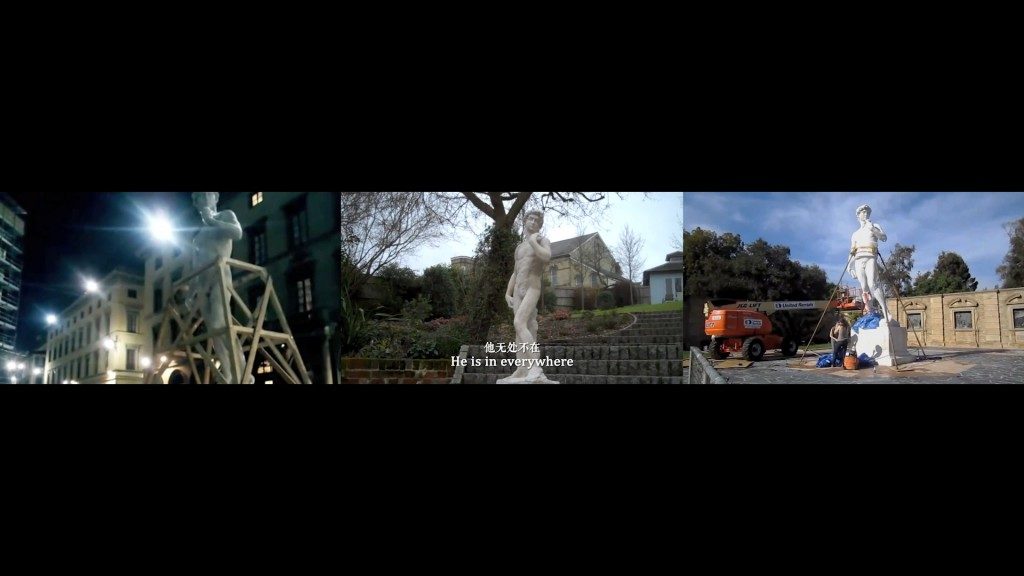
This far-reaching journey culminates in the chapters Colours and Time and Infinity which bombastically sets out to explore the way artist come to influence that which exists outside and before a human sphere. Within both pavilions, there is a distinct failure at acknowledging the specificity of the individual works, which, besides from their formal qualities, seems to have little to do with either Colours or Time. Once more the curation, ironically, overshadows, rather than enhances, the complexity of the individual works at stake.
It is symptomatic of the, perhaps biggest, misunderstanding of this year’s biennale: That a return to the artist, or the human more generally, is what will allow us to understand and surpass our current state of crisis. It seems to overlook that our anthropocentric attitude is what originally brought us into trouble. Just as the individual pieces of art are diluted by insisting on the narrow focus of the artist, so does humanism distract us from the complexity of the world in which the human is only one part out of many. It simply seems outdated to return to the human-figure, conceptually broken by critical theory and practically threatened by developments in AI. Rather we need to accept, as many of the brilliant pieces do, a state in which humans are not in control; which allows for spaces of ambiguity and contingency. We do not need a return to humanism. Rather, now is a time to be humble, to look outside of humanity and think beyond that which already was, and never really worked in the first place.
Walking off the Akadimias district and onto the steps leading up towards the entrance of building number 23, I am greeted by a large hall with high red ceilings. The hall is covered with lavish white and black dot marble, and there is a large staircase acting as a guide to the top floors of the manor-like building. This was the home for the Diplomatic Centre of the Third Reich, designed in 1923 by Vassillis Tsagris, and used until 2011 by the Foreign Press Correspondent Union after the Second World War. Since then it has stood derelict and dusty, but for one week, in parallel to the opening of documenta 14, it played temporary host to the artist-in-residence programme of Palais de Tokyo, alongside with Foundation Fluxum/Flux Laboratory, bearing the name Prec(ar)ious Collectives. Six visual artists in residence at Pavillon Neuflize OBC and eight contemporary Greek choreographers envision and fabricate a hybrid space whereby an experimental notion of a community is executed as a situation rather than as a subject. The visual artists and performers involved congregated together in Athens and on site for a two-week workshop in March in order to produce the works. The title, Prec(ar)ious Collectives, is a linguistic amalgamation of the adjectives ‘precarious’ and ‘precious’, implying the state of the collective that performs together.

The opening façade echoes with the humming and reverberated sound of Manolis Daskalakis-Lemos‘ Dusk and Dawn Look Just The Same (Riot Tourism), guiding us towards its installation room. The video installation stands above a mountain of blue powder in a room sectioned off with construction tape. The short sequence of about a minute and a half displays a group of hooded figures, dressed identically. As the soundtrack’s volume begins to escalate, the group progresses from walking to running on the uncannily void and ghostly streets of Athens. A city always bustling with noise is now at its most quiet and pubescent state of the day – dawn. The hooded figures run together and – even though it is in a disordered manner – command your attention and pensiveness until they all reach Omonia Square. The work demonstrates a resistance to a status quo which may be aligned with the political engagement within the city. This is not, however, done in an expected reactionary manner, but instead in a way that promotes uprising through the creation of a meditative state. One cannot help but watch Lemos’ work a couple of times more before leaving it behind and only then noticing the thundering beneath their feet.
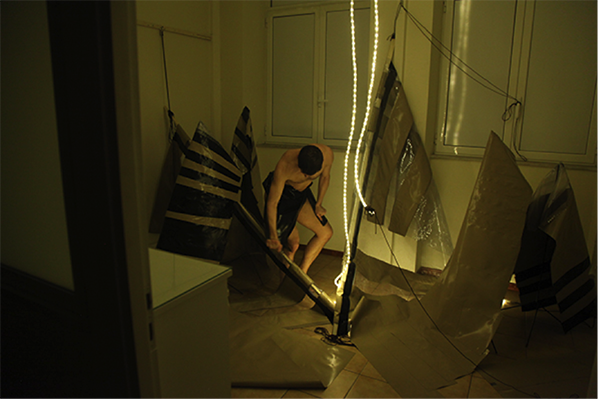
This historic building has a basement and is the temporary home of Taloi Havini‘s performative work. The large-scale installation occupying four rooms consists of PVC vinyls, seemingly discarded or hung from the low ceiling. These PVC vinyls are lit by dispersed and differently coloured strings of light, some are red, others are purple and others are cream. The performance is underway and its performers dress themselves with the PVC vinyl and the lights and jolt their bodies vigorously to the rhythm of the thundering – sometimes in sync, sometimes not. The dark basement is transformed into a cavern of rhythmic delight alluding to a ritual where its power lies in the gathering of people.
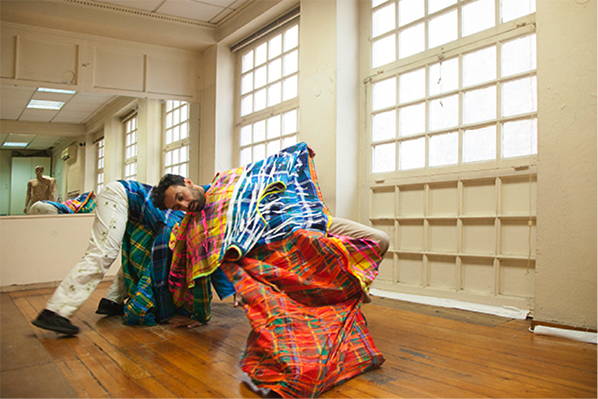
As one inspects the garments of Wataru Tominaga and those who wear them, this synthesis of the PVC, the space and the performers as a gathering appears to be a motif. Tominaga created the garments during a preliminary workshop, with great care and appreciation of how he and others were to utilise them during Prec(ar)ious Collectives. Originally presented on mannequins before being worn and performed, the garments boast vivid colours and patterns, some of them containing animalistic features such as feathers or fur. Those who wear Tominaga’s work perform in such a way as to invent a new form of communication between themselves and their observers. They move and conjoin like animals, sometimes hiding underneath the fabric and at times evoking the traditional Japanese ‘snake dance’. The performance, being in a transitional space between the ground floor and the first floor, naturally spreads itself upstairs whereby the performers not only continue to wear the garments in obscure ways, but additionally interact with Yu Ji‘s agave plants and other objects.
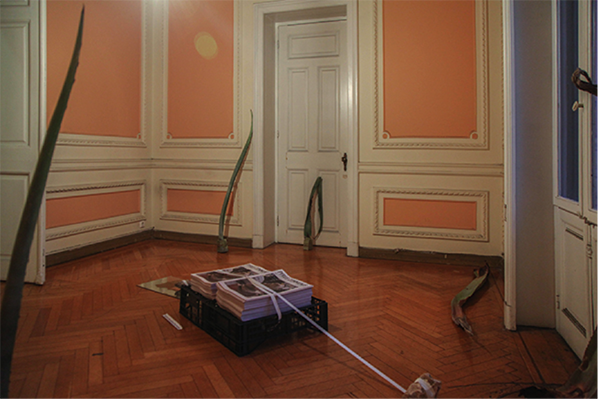
Yu Ji‘s work, Lycabettus Tongue, Oliv Oliv and This is Good For You! Are formed by the use of displaced agave plants, half-fragmented found mirrors and lights. The agave plants interlock with various architectural patterns of the building such as stair banisters, whilst the mirrors and round-ball lights are positioned in ways offering various points of view for observation and appreciation of space. The work revitalizes the architecture of the building denoting its historical vitality and the synergy of the encompassing works into a haunting existence rather than an abandoned one. Here, haunting is used not for means of negative connotations but instead as a form of aloof yet introspective sensation, exasperated further with Lola Gonzàlez‘s video installation in the next room.
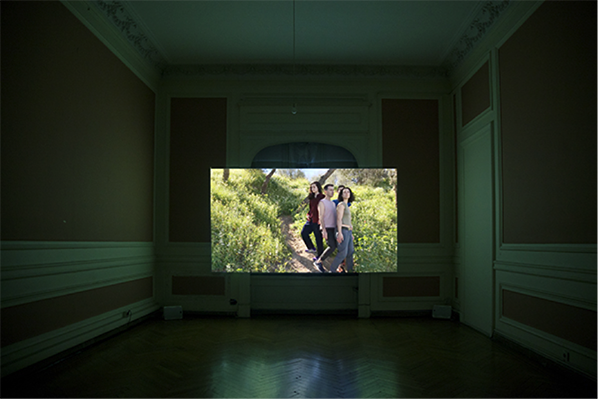
Lola Gonzàlez‘s Now my hands are bleeding and my knees are raw begins with its protagonists split into groups and observing the city of Athens from various points at the top of the hills. The groups begins to move, run and hop together towards a direction down the hill, whilst a chorus of droning voices begin to chant and harmonise. As the groups get closer and closer to the city, Gonzalez transforms the image into a complete inversion, like one you may find in negative photography. The chanting becomes louder as the three groups get closer and closer to their meeting point within the city – the exact space where the video is being showed. They are finally shown entering the building and making their way up the stairs to the room where they vocalize in unison until they fade away from our view. Now my hands are bleeding and my knees are raw alludes to an atmosphere in which the power of gathering together evokes a community whose intention is situated between an uncertain balance of peril and strength. It is the same kind of uncertainty that one finds when exploring the top floor of the building only to discover Thomas Teurlai‘s room of machines and looped functions.
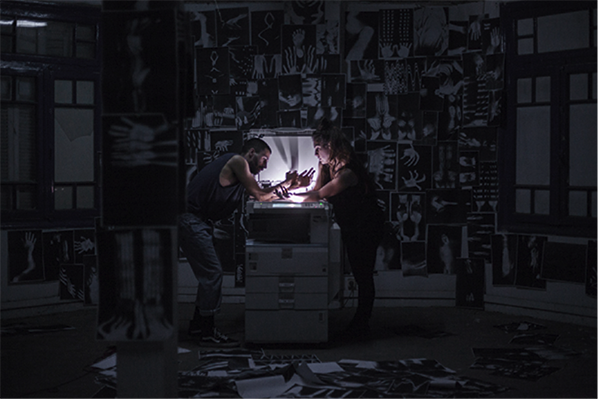
On the top floor, there are still the remnants of neglect, rooms empty of anything but the garbage that piled up over the building’s six years of desertion. Thomas Teurlai‘s Score for bodies and machines consists of a room installation of two printers used by the performers to scan different parts of their bodies. These scans are then plastered on the wall whilst the fluorescent lights constantly trickle on and off. The two performers are attempting to archive as much of the movement involved in their choreography as possible. The looped function of copying and the crackle of its repetitive working-noises do not clash with the choreography but instead drive its energy.
Indeed, it may be the encounter between the building, the communal working spirit of the performers and the result of this effort that defines this rejuvenating energy as a fruitful rebirth of the building’s utility.
To find out more, read Chloe Stavrou’s recent interview with Fabien Danesi of Prec(ar)ious Collectives.
The Gathering Cloud makes slow reading. Let’s start with the title. It trips off the tongue, doesn’t it? Rolls around in the mind like a marble you’ve had since childhood. But there’s something unfamiliar about it, too. ‘The gathering cloud’ evokes a threat – the gathering crowd, perhaps; words haunted by expectation; a riot just about to begin. The gathering cloud sounds material and immaterial at the same time. It could signal rain, or warmth, or happiness for shepherds and fishermen, if only you knew how to read it. Could the ancients interpret celestial data? Can Google analysts do it now?
Every sentence in JR Carpenter’s literary artwork, The Gathering Cloud, is as resonant and expansive as its title. The work is so full of meaning, in fact, that it pushes beyond its own borders. Both a piece of digital literature commissioned by Neon Digital Arts Festival, and a book published by Uniform Press, The Gathering Cloud hovers, as an aesthetic experience, in between (it also exists as a printed A3 zine, distributed in more informal ways).
Its theme is climate change. Or, more precisely, the material effects of technologies euphemistically named ‘cloud computing’ on the health of the planet. Or the systems of knowledge that reveal and obscure our relationships to our world. Or the impossible responsibility of human actions that have a global impact. Or, in Carpenter’s characteristically succinct language in the afterword (‘Modifications on The Gathering Cloud’):
The Gathering Cloud aims to address the environmental impact of so-called ‘cloud’ computing and storage through the overtly oblique strategy of calling attention to the materiality of the clouds in the sky.
Online, The Gathering Cloud appears as a palimpsest of moving images, interacting as a series of animated gifs. To read this work is to move with it. Fragments of text respond to the hover of your mouse. Symbols march across the screen and align in multiple combinations. The experience, in other words, is just like using the internet. There is more here than you will ever be able to discover, and yet the format entices you to keep looking. The world of the browser is both (seemingly) infinite, and controlled by your gaze.
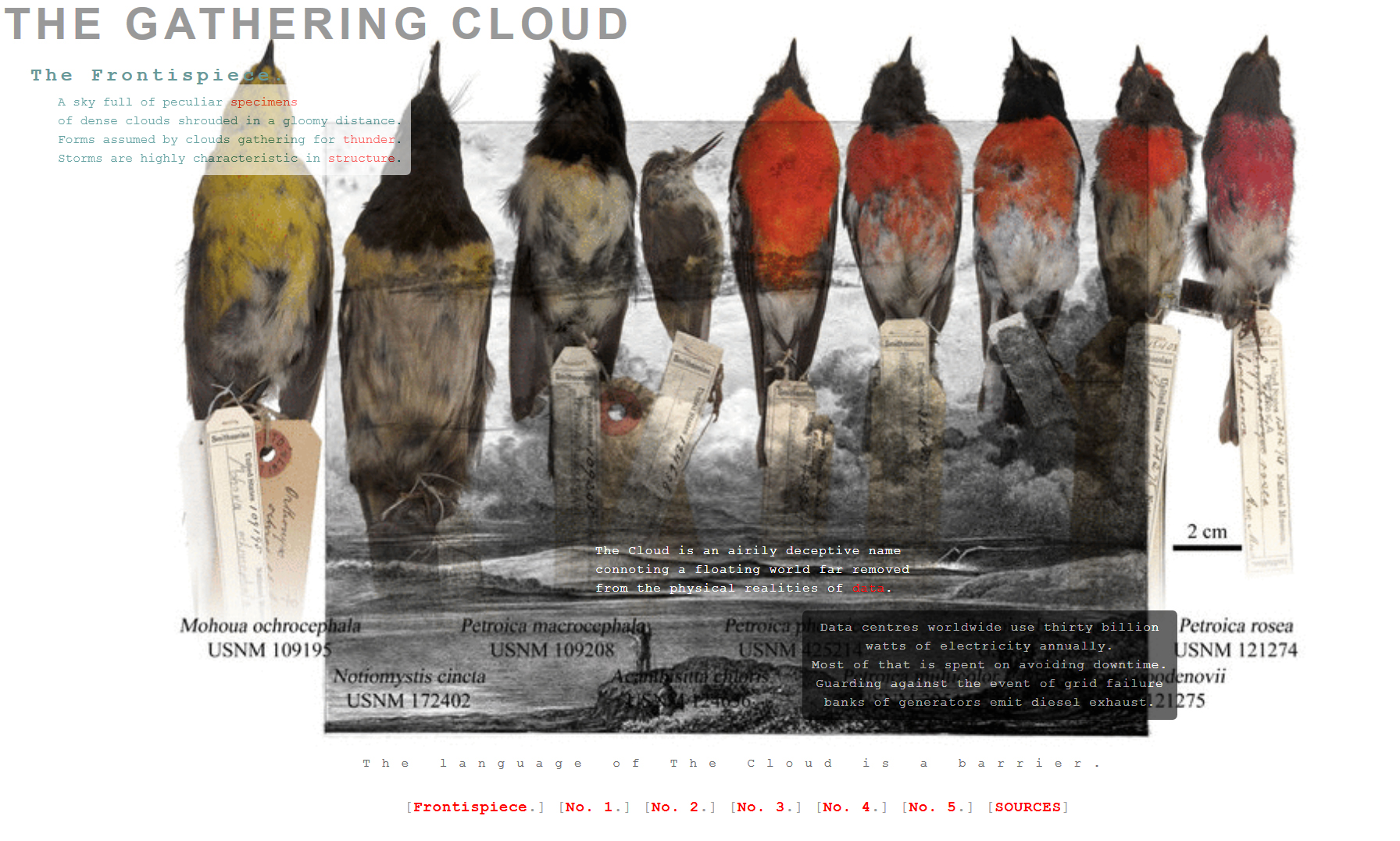
The first images you see are cloudscapes taken from Luke Howard’s Essay on the Modifications of Clouds (1803). Howard was the first person to devise a popular and scientific naming system for the clouds in the sky. His process was based on natural history classifications, Latin naming principles and the fact that clouds are subject to endless change. His project was such a success that we still use his cloud nomenclature today. But, as Carpenter points out, ‘The language of The Cloud is a barrier.’ Here, she is talking of the language of cloud computing, and how its association with the mutable territory of the sky fails to communicate its dirty, real-world effects. But the language of the clouds is also, always, a reference to Howard’s system and its structuring aim: a grand attempt to explain the (previously) unexplainable, to box in the search for knowledge, to capture what is not still there.
The illustrations that accompanied Howard’s published text were minutely detailed etchings based on his own watercolours. In the book, Carpenter describes the journey of the images as technological as well as scientific artefacts, ‘Translated into cross hatching,’ she writes,
Howard’s studies
lost subtlety, but gained fixity, moving
them toward the diagrammatic scientific.
Carpenter uses these pictures, then, to draw attention to how we understand the world as well as what we (try to) understand. Onscreen, she overlays them with photographs and illustrations of animals – elephants, birds, beetles – which echo metaphors evoked in fragments of her poetic text (‘A cloud the weight of one hundred elephants’, for example, ‘How many more birds/ have been captured and tagged and stored in The Cloud?’). Like the etchings, these animal images bear the time-stamp of specific systems of thought. Some are scientific and precise, for example, and belong, stylistically, to a process of classification: illustration as pedagogic tool.
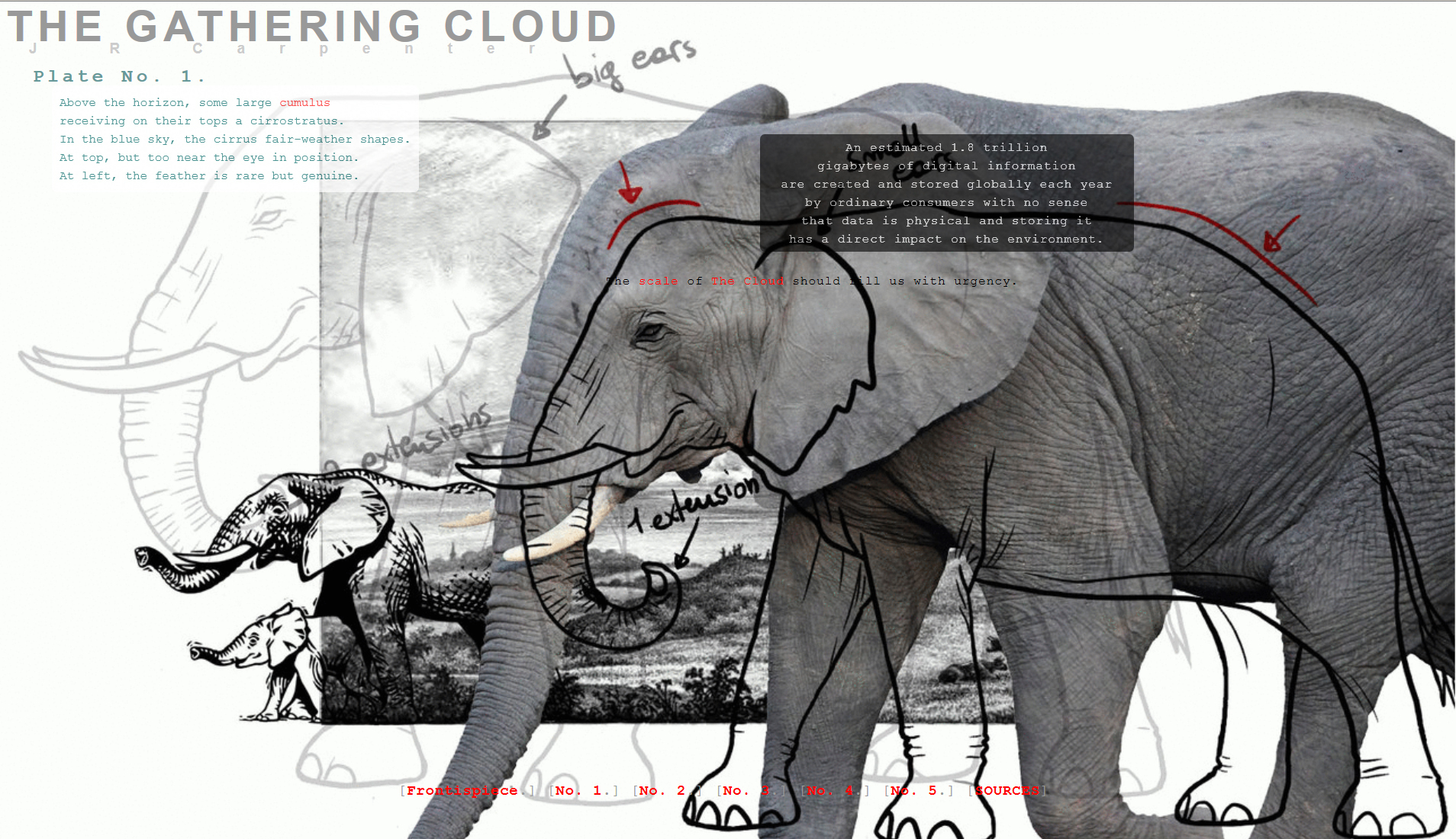
In a final conceptual twist, each of these interwoven, visual elements has been ‘materially appropriated’ (Carpenter writes), ‘from publicly accessible cloud storage services.’ These, then, are pictures of weather clouds, and of the ways we think about weather clouds, and of the technological border patrols that control the ways we think. These are images preserved in the hardware of server farms, which means they are also images of the billow of fossil fuels, the gasp of countless lives and minerals, ground into the earth over geological time, as unimaginable in scale as the size of the data stores themselves, or the climate change precipitated by the energy they need.
Tech giants Apple, Amazon and Microsoft
power their twenty-first century clouds with
dirty nineteenth-century coal energy.
And here is the context for Carpenter’s words: lines of hendecasyllabic (eleven-syllable) verse arising inside, on top of or behind the images, borrowing and interpreting found texts from Howard’s nomenclature and contemporary media studies. All of this, finally, is the context for you: the reader/user, dragging your finger across your mouse pad as you enact the dynamic complexity The Gathering Cloud represents:
To miniscule cumulus water droplets
air is an upwelling thermal below them
is as dense as honey is to a pebble
five thousandths of a millimetre across.
As a work of digital literature, then The Gathering Cloud is an extraordinary marriage of concept and content. By which I mean literally extra-ordinary: representing and exceeding the ordinary functions of its source images and texts. While the work is hosted online, however, its rhizomatic affect has less to do with technology than with attention. In an interview in 2010 Carpenter said, ‘I imagine my target audience being people sitting at desks pretending to do other things. Like work, for example. Or writing. Because they are already pretending, their minds are wide open. [1]’ The Gathering Cloud is a lucid dream space for people not entirely in charge of their dreams.
*
The most obvious difference between the printed and online versions of The Gathering Cloud is that the book feels primarily textual. Featuring an extended prologue, the book showcases Carpenter’s writing on spacious pages, interspersed with occasional black and white ‘plates’ taken from the digital piece. Simply framed in this way, the power and precision of her words come to the fore. The hendecasyllable format produces a bare, pared down kind of language that sounds natural and restrained, like a conversation with someone who has much more to say. Describing the ancient Roman philosopher Lucretius’ theory of clouds, for example, Carpenter writes:
Nothing can be created out of nothing.
The whole earth exhales a vaporous steam.
Meaning hangs like a lifetime between these lines. The gap between ‘nothing’ and the exhalations of the earth is as big and as small as a breath being held.
Like the skeleton of a bird’s wing, each line in Carpenter’s perfectly crafted, fragile text takes the body of the work in a new direction. And yet, the most thrilling element of the book is not textual, but visual.
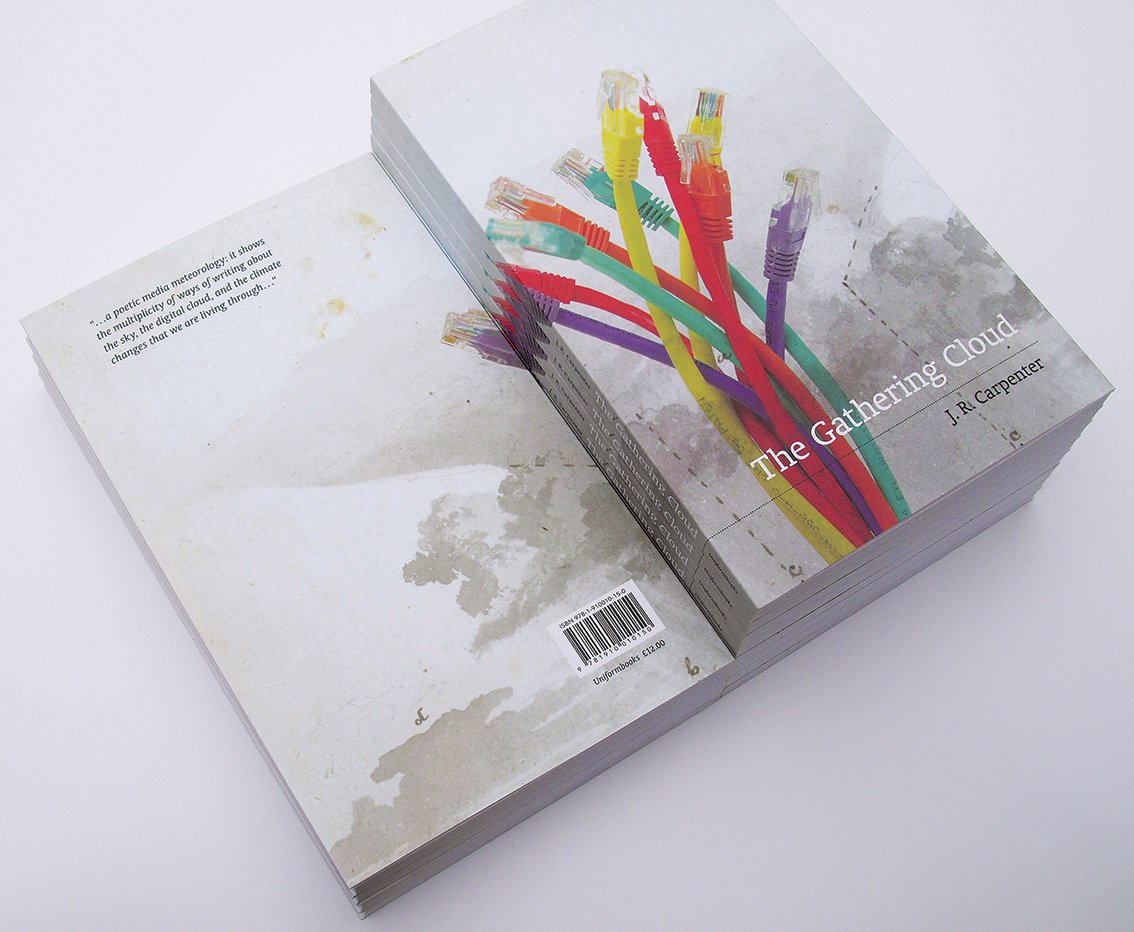
In print, some of the words appear greyed out. Twenty-first century readers recognise this allusion, immediately, as a hyperlink; but of course, there is nothing to click on a printed page. A book is an emblem of past decisions in a way that online experiences pretend not to be. These un-links, then, are uncanny. They promise potential, in the same moment as they fatally disappoint. They wave to the future but they are, literally, pulped emulsions of the past. They call to a space beyond the page, ripe with forbidden fruit, humming with endless desire: more knowledge, more dreaming, more distraction.
An estimated 1.8 trillion
gigabytes of digital information
are created and stored globally each year
by ordinary consumers with no sense
that data is physical and storing it
has a direct impact on the environment.
These un-links represent everything you want and everything you can’t have. They are the spaces for you to dream in and the alarm that stops you dreaming. They are the endless potential of the internet, and the finite resource that will shut it down. In other words, just as the online version of The Gathering Cloud performs the limits and aspirations of older systems of thought – the acid hatch of etchings, the earnest naivety of visual or linguistic classification – so the printed work performs the futile urgency of lives lived online. In each case, the performer on centre stage is the reader/viewer, forced to confront her own ambitions and her impotence as she navigates through mutable worlds.
This, in a nutshell, is our relationship with climate change: it is about us, but bigger than we can comprehend; we are compelled to act, but crave direction; we want to dream, but we are afraid to lose. Crucially, Carpenter asks us to inhabit this relationship, not the climate itself: her work is emotional, not didactic. Instead of explaining climate change, Carpenter explores the extent to which it can possibly be imagined. Then, gently but firmly, she pushes the borders of our thoughts, and gets us to imagine some more.
‘Like a muzzled creature’, Carpenter writes, ‘the cloud strains to be/more than it is.’ The same could be said for her work, of course, and for the people who move through it. In a perfect echo of the systems of weather and data that are its subject, different iterations of the The Gathering Cloud (whether real or imagined) are held, within the reader, as memory, as action, and as technology of thought. The Gathering Cloud could signal rain, or warmth, or happiness for idle browsers,if only you could trace your finger along each acid scratched line. Could the ancients sculpt the hubris of the searching gaze? Can the Google server farms do it now?
By Mary Paterson
Review of The Gathering Cloud, JR Carpenter
http://luckysoap.com/thegatheringcloud/
Uniform Books, 2017
“Flexicity, information city, intelligent city, knowledge-based city, MESH city, telecity, teletopia, ubiquitous city, wired city… [what is] a city that dreams of itself?” (Jones 2016).
This April, 28 brave souls came together for the first time to explore algorithmic ghosts in Brighton — a city known for its blending of new-age spiritualities and digital medias, but perhaps not yet for its ghosts — through the launch of a new psychogeography tour for the Haunted Random Forest festival. Unveiling machine entities hidden within seemingly idyllic urban landscapes, from peregrine falcon webcams to always-listening WiFi hotspots, we witnessed a new glimpse of an old city, one that afforded many strange moments of unexpected (and perhaps even radical!) wisdom regarding the forgotten structures, algorithms and networks that traverse Brighton daily alongside its human inhabitants.
This intervention found its greatest inspiration in the playful, crtitical, anti-authoritarian strategies of the Situationist International group that was prominent in 1950s Europe and birthed the fluid concept of dérive or “drift”, a new method for engaging with cities like Paris through “psychogeographic” walks that charted increasingly inconsistent evolutions of urban environments and their effects on individuals. “Perhaps the most prominent characteristic of psychogeography is the activity of walking,” explains Sherif El-Azma from the Cairo Psychogeographical Society. “The act of walking is an urban affair, and in cities that are increasingly hostile to pedestrians, walking [itself]… become[s] a subversive act.”
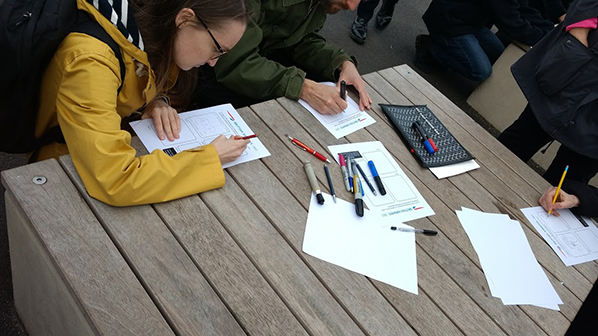
Psychogeographical drifts have been interpreted in many ways in many places, from radical city tours with no set destination, to public pamphlets meant to shock people out of their daily urban routines, to unsanctioned street artworks that explore changing architectures and hegemonies of the built environment through direct dialogues. As the Loiterer’s Resistance Movement explains, “We can’t agree on what psychogeography means, but we all like plants growing out of the sides of buildings, looking at things from new angles, radical history, drinking tea and getting lost, having fun and feeling like a tourist in your home town. Gentrification, advertising, surveillance and blandness make us sad… our city is made for more than shopping. We want to reclaim it for play and revolutionary fun.”
In our own interpretation of the psychogeography “play box“, people from across the UK came together from local community discussion lists, universities and creative networks to join the group. We called them ‘node guardians’ to connote a shared sense of ownership regarding both the tour nodes (which were lead not only by ourselves but also by several other brave participants, who also facilitated hands-on activities to engage listeners more deeply in the lived experiences of each machine node). We were intrigued about the moments of access, control and liberation that might be exposed when the machines, networks and algorithms that we engage with on a daily basis were revealed. In the unearthing of lesser-known instances of code-based activity (and the patterns within), we hoped to meet machine spirits, languages and loves along the way. And meet them we did.
Although the tour aimed to seek out algorithms and machines, we didn’t feel limited to influences from our current digital age. Brighton has a rich history of invention and engineering which has influenced the local geography as well as wider culture. The ghosts of Magnus and George Herbert Volk, father-and-son engineers, can be found all over the city, from Magnus Volk’s seafront Electric Railway which opened in 1883 — making it the oldest working electric railway in the world — to George’s seaplane workshop in the trendy North Laine shopping area, which went on to house a thoroughly modern digital training provider, Silicon Beach Training. Magnus Volk’s most unusual invention, though, only exists as a part of Brighton’s colourful history: the Brighton and Rottingdean Electric Railway, as it was officially called, earned the nickname the ‘daddy-long-legs railway’ as it ran right through the sea with the train car raised up above the waves on 7-meter-long legs. The railway was only in operation for 5 years from 1896 to 1901, but you can still see some of the railway sleepers for the tracks along the beach at low tide.
For a relatively small town, Brighton also played a surprisingly big role in the development of the international cinema industry. In the 1890s and 1900s, a group of early filmmakers, chemists and engineers called the Brighton School pioneered film-making techniques such as dissolves, close-ups and double exposure, and created new processes for capturing and projecting moving images. Key members of the group used the old pump house in local pleasure garden St Ann’s Wells as a film laboratory and shot the world’s first colour motion picture called ‘A Visit to the Seaside’ in Brighton in 1908, using a colour film process called Kinemacolour invented by the group. Although the city’s early passion for cinema is remembered by several blue plaques marking key locations — and the presence of the Duke of York’s cinema, the oldest continually operating cinema in the UK — we wondered how much of Brighton life had been captured in the dozens of short films made at the turn of the century, only to be lost forever?
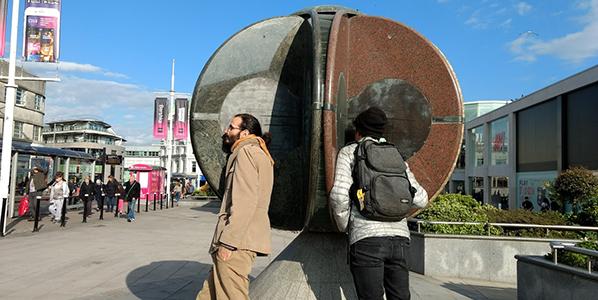
The rest of the stops on our walking tour took in more contemporary machine ghosts, including the last remaining trace of the city’s USB dead drop network — conveniently embedded in a brick wall on the seafront above the Fishing Museum — which prompted us to ask what information people may have passed to each other before these devices were destroyed by weather and vandals. Dead drops were originally set up to be an anonymized form of peer-to-peer file-sharing that anyone could use in public spaces. They have since been embedded into buildings, walls, fences and curbs across the world. Perhaps some of our tour participants will even be inspired to set up new dead drops around the city to keep the potential for off-grid knowledge-sharing alive.
In a reversal of this spirit of anonymous digital communication, a new network of WiFi-enabled lampposts, CCTV cameras and other pieces of ‘street furniture’ has been unobtrusively installed across the city by BT, in partnership with Brighton & Hove City Council. They now eavesdrop on the personal musings of passers-by who connect to them. These hidden devices provide users with a free WiFi service, but the group wondered at what cost. Participants found themselves questioning whether BT can be trusted to keep our information secure in an age where data has become a valuable marketing commodity.
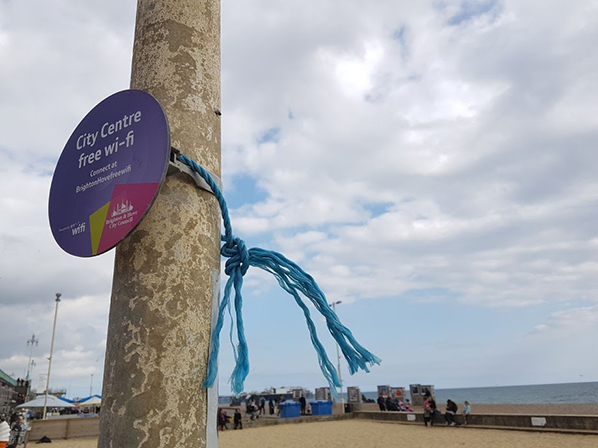
As part of our psychogeographical aim to unveil the hidden lives of once-familiar urban artefacts, we also summoned the machine ghosts of some of Brighton’s most famous (and infamous) landmarks. Looming over the city centre is a towering modernist high-rise called Sussex Heights, a building that sticks out like a sore thumb amidst the classic Regency architecture of the city’s Old Town. Yet atop the concrete tower also live families of peregrine falcons, whose nesting activities are broadcast to the world by an ever-watching webcam. Conservation groups, architects and technologies intersected in 1990 to provide a nesting box that would enable the falcons, extinct in the area at the time, to successfully breed. They now return to the tower block every spring to rear their young (except in 2002, when they chose the West Pier instead). Writing down our best wishes to this season’s hatchlings, we pasted them onto the building for future city ghosts to browse.
The other most visible instance of architectural and structural technologies descending upon the city can be seen in the new British Airways i360 viewing tower, variously described as a ‘suppressed lollipop’, a ‘hanging chad’, ‘an oversized flagpole’, an ‘eyesore’ and a ‘corporate branding post’. Even if you leave the city, you can’t get away from the sight of the 162-metre tall tower, as it is equally visible from the countrysides surrounding Brighton. It overshadows its neighbour, the beloved remains of the burnt-out West Pier, and opened exactly 150 years after the West Pier first opened in 1866. However, the ‘innovation’ in the i360’s name may be a boon to the city, as it’s expected to pour £1 million a year in the local community and potentially inspire the renovation of the West Pier. Our node-guardians bravely attempted a participatory activity outside the i360 which involved sketching out mock flight warnings to those who entered its gates; the mock flight attendants situated at the base of the i360 were less than amused by these efforts.
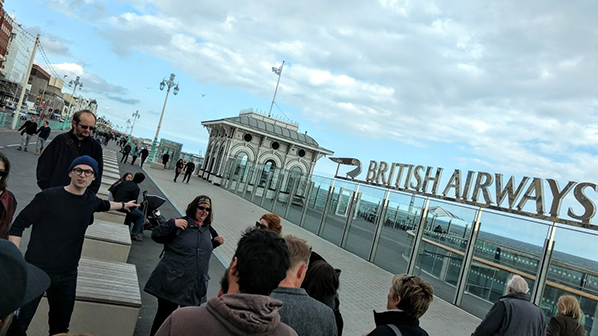
In most towns, the shopping centre becomes a well-known haunt for both locals and visitors to congregate, yet most people who visit Brighton’s Churchill Square shopping mall pass by the square’s large pair of digital sound sculptures without even a glance. The sculptures look like a pair of matching stone and bronze spheres, and are the type of public art that you can walk past everyday without actually looking at, but after looking into their always-observing faces once, you’ll never miss them again. They quietly interact with the sky every day through a set of complicated light sensors that trigger a series of musical notes tuned in to each orchestration and angle of the sun. As the sun rises, they call out to one another, their combined song fading away as the sky turns dark. Or at least, we are told they communicate; after a group activity to emulate the interactivities of the spheres, we found ourselves quite unsure if we had actually heard ghostly spherical music emanating from spherical mouths, or just the sound of shoppers and buses passing by.
And finally, if you’ve lived in Brighton for a while you’ve probably come across the French radio station FIP, which until a few years ago you could tune into on radios across the city. While standing in the bustling North Laine cultural quarter, we were briefly transported to Paris by one of our node guardians’ melodica renditions of Parisian cafe music, and heard the story of how a local resident introduced Brighton to FIP in the late 1990s when they started re-broadcasting the radio station out over the city. It became one of the most popular radio stations in town and transmissions continued until 2013, even surviving an Ofcom raid on the mystery broadcaster’s house in 2007 when their equipment was confiscated. The story of Brighton’s love for FIP radio, including a monthly fan-organised club night called Vive La FIP that joyously ran from clubs around the city for years, shows that as well as its own ghosts, our city is also haunted by the machines of distant places.
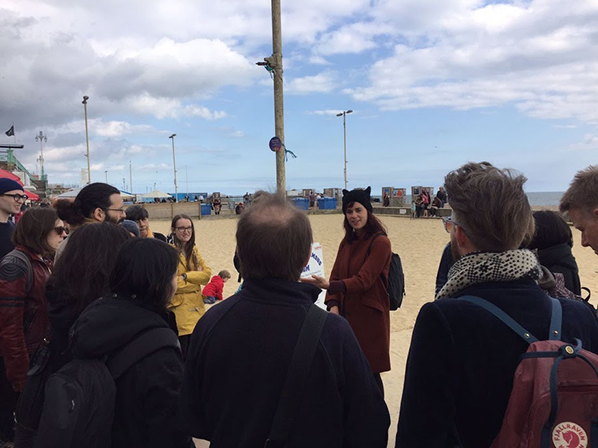
Indeed, from the distant ghosts of rebellions past to those who quietly slip by underfoot as we walk to the pier, the derives of this tour taught us that unearthing hidden histories of a city can bring both good and bad spirits back to life — moments of local liberation and defiance existing alongside a national state of increased surveillance, conglomeration and control. We call for future tours, psychogeographic and otherwise, that challenge participants to think about Brighton through new forms of engagement that focus on grassroots and community efforts, and their implications in the spaces and places we use every day. Only then can we determine whether the ghosts that surround us are in charge of our fates, or whether the myriad past and present struggles of this city can co-exist in collaboration.
On January 17th 2017 outgoing American President Barack Obama commuted the 35 year sentence of whistleblower Chelsea Manning. She was to be released on May 17th 2017. The Disruption Network Lab (DNL) Berlin has in the past addressed various forms of disruption techniques. In celebration of Manning’s release, the DNL, which is under the curation of Tatiana Bazzichelli, decided to devote their latest event, Prisoners of Dissent, Locked Up for Exposing Crimes to the voices of dissent of our time.

DNL’s new event-venue is a historic Berlin theater called the Volksbühne (“People’s Theater”) that stands on the Rosa-Luxemburg square. The square’s namesake was a famous anti-war activist and communist revolutionary. Rosa Luxemburg was murdered for her political activism by right-wing paramilitaries in 1919. Thus, the new location draws an historic parallel between dissidents and the often violent ways they are silenced.
While attendees waited for John Kiriakou to present his new book, “Doing Time Like a Spy: How the CIA Taught Me to Survive and Thrive in Prison“, the wood-heavy 1920s-style saloon of the Volksbühne was completely filled with people, leaving not a single chair free. Kiriakou served in the CIA as an analyst and officer for 14.5 years and is now a whistleblower of their practices. He was operating in the Middle East with a focus on counter-terrorism and human rights. In 2007 he brought to light that the CIA was using waterboarding as torture and was subsequently alleged to have disclosed the identities of undercover CIA agents. For this, he was charged with violating the 1917 Espionage Act under U.S. Law and had to spend two years in a low-security prison in Pennsylvania.
In 2014, while Kiriakou still served his sentence, his pixelated lego-portrait was among the 176 political prisoners of Ai Weiwei’s artwork “Trace” that was part of his Alcatraz show in California.

Kiriakou is a man in his early fifties with a likeable charisma. But as one would think of a spy, there are many more dimensions to his character, and he is only hinting at these while reading from his book. Recounting how he made use of his CIA training in daily prison life – living between Mexican drug kingpins, Neo-Nazis and Italian mafia members, he concedes that he can also be a man with nasty manners – if he has to. (Kiriakou points out that the CIA hires individuals with sociopathic tendencies). The audience listens closely while he describes his prison encounters with an enthusiastic storytelling voice. In one anecdote that reminds me of high-school politics he describes the Italian mafia members he made friends with. They made sure that another inmate who pulled Kiriakou’s name through the dirt would be “taken care of”. There is a lightness and sense of humor to Kiriakou’s character. His stories, often punctuated by laughs from the audience, are witty and fascinating. One easily gets lost in listening to them, nearly forgetting the seriousness of the situation he had to bear.
Kiriakou, who had six passports with six different backgrounds and survived two assassination attempts, also mentions the psychological stress and pressure whistleblowers struggle with. As he states that all whistleblowers have their own moments of desperation, I’m reminded of the two suicide attempts Chelsea Manning undertook and the harsh reality of injustice whistleblowers have to experience under their governments.
According to Kiriakou, his motivation came from a patriotic disposition which compelled him to act when the government violated constitutional rights. Snowden states a similar reason, although it is rather interesting that Kiriakou more or less accidentally became a whistleblower, which differentiates him from many others who made a conscious choice of disclosing information in the first place.
The book is definitely worth a read (the copies he brought were sold out by the end of the event) as it gives a unique and very personal insightful view into a CIA officer’s life post-whistleblowing.
In the Q&A session that follows the book presentation, Kiriakou is asked whether in hindsight he would have done anything different. In response he gives two pieces of advice to future whistleblowers: First, get an attorney before you go public with information. Second, don’t trust anyone. Well, somehow what one would expect from a spy?
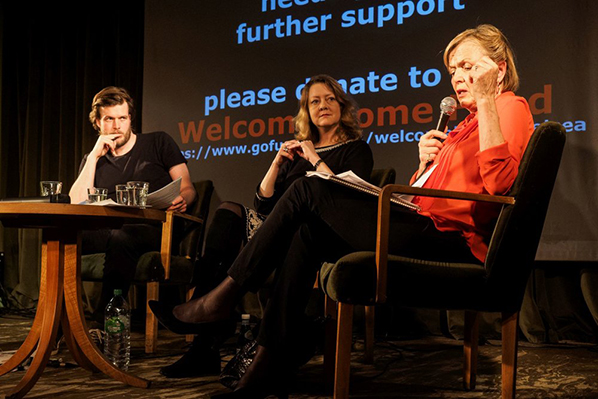
The second part of the event consisted of a panel with four guests, that was moderated by Annegret Falter from the Whistleblower Netzwerk e.V.. To introduce Chelsea Manning’s case, a video from the Chelsea Manning Initiative Berlin was shown, which documented their activity from 2011 until now. As a prelude to the panel Annegret Falter read Manning’s public statement, which was released on May 9th by her legal team. She quoted Manning’s words:
“[…] Freedom used to be something that I dreamed of but never allowed myself to fully imagine. Now, freedom is something that I will again experience with friends and loved ones after nearly seven years of bars and cement, of periods of solitary confinement, and of my health care and autonomy restricted, including through routinely forced haircuts. […]”
The short statement implies the outstandingly harsh conditions Manning, being a transgender woman in an all-male prison, had to live under the past seven years. The exceptionally severe sentence for exposing crimes was commuted by Obama after an outpouring of public support over Manning’s mistreatment in prison and with the prospect of a Trump presidency, many feared for Manning’s life.
Manning was charged under the Espionage Act, which was introduced in 1917 shortly after the U.S. entered the First World War. Many critics see it as a legal relic – an outdated federal law, originally applied to individuals interfering with the U.S. war effort. It is now abused to persecute whistleblowers, among them Daniel Ellsberg, John Kiriakou, and Edward Snowden. Not only is this law incompatible with human rights and civil liberties, but legal scholars argue that it is written so vaguely that a fair trial is impossible in addition to it being unconstitutional

One of the guests on the panel was the British-born Annie Machon. The former MI5 intelligence officer (The UK’s Secret Service) left the organization in 1996 after the Security Service was involved with a branch of Al-Qaida in a plot against Libyan leader Colonel Muammar Gaddafi. The assassination failed and several civilians lost their lives. Consequently she resigned and teamed up with her then-partner David Shayler – an MI5 officer himself – to blow the whistle on the crimes and incompetence of the intelligence community. He was later accused under the 1989 Official Secrets Act, and the three-year exile and two-year legal battle against her former partner publicly became known as the Shayler Affair. Machon wrote a book about the affair, speaking out about both their motivations and the legal injustices the pair endured.
Machon had extensive experience on a professional and personal level, making her an expert on issues like the war on terror, whistleblowing, and the U.K. legislation. Criticizing the U.S. Espionage Act of 1917, Machon pointed out that it was the U.K. that gave the world a notion of such laws with their 1911 Official Secrets Act. While the 1911 law was originally used for spies betraying the country, it was adapted in 1989 to specifically target whistleblowers. New legislations on surveillance, secrecy, and whistleblowing pushed state power even further forward while continuing on a downward spiral. Machon expressed concern that the world would follow the U.K.’s example once again. Clearly she was advocating for a necessity of legal protection for whistleblowers, instead holding criminals to account, not jeopardizing the liberty of the brave individuals who feel compelled to speak out.
On the subject of the psychological issues whistleblowers suffer with, which Kiriakou addressed earlier, she added that the stress also had an effect on Shayler. With a worried voice she said that he now believes himself to be the reincarnation of Jesus Christ.
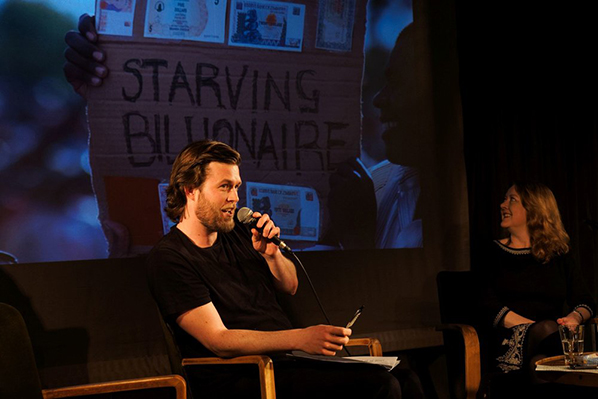
Another guest on the panel was the Danish-born human rights activist Magnus Ag, who works for Freemuse, a global organization advocating freedom of artistic expression. Underlining the importance the arts play as a powerful medium of dissent, he quotes Picasso: “Art is a lie that makes us realize the truth.”
Various cases worldwide remind us of artists experiencing oppression, censorship or imprisonment for their work. From the feminist Russian punk-rock band Pussy Riot, facing a two-year sentence for protesting Putin, to Ai Weiwei who disappeared for 81 days, detained in a secret prison by communist-led China. Under the hashtag #ArtIsNotACrime, Magnus Ag and Freemuse draw attention to lesser known cases. According to Freemuse’s report, China is among the worst offenders for violating artistic freedom. He introduced the case of five Tibetan musicians who were imprisoned by the Chinese government for simply singing songs that refer to the Dalai Lama and praising Tibetan culture. For charges like “seditiously splitting the state“, as of 2017, all five remain in prison.
Magnus Ag then introduced another guest of the panel, Silvanos Mudzvova who unfortunately was not able to come in person. Mudzvova is an activist, performance artist and a man of outstanding courage. In a video portrait he was shown criticizing the corrupt government of his home country Zimbabwe via the means of art. Dominated by Mugabe since 1980, Zimbabwe suffers an immense financial crisis, besides the recent scandal of $15 billion USD that had been raised from diamond sales and gone missing. Protesting and addressing these issues, Mudzvova staged a public performance in front of the parliament. For his art, he was abducted, tortured, and almost lost his life. Unfortunately, the country is affected by heavy censorship that targets activist, artists, and journalists. As Mudzvova says, he uses art as a catalyst in order to achieve change in the world.
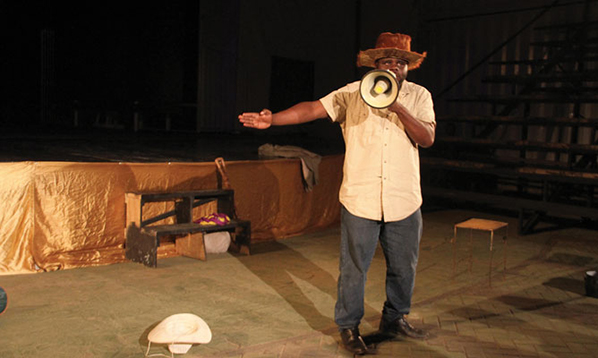
One may ask what makes art so powerful that governments fear it, which brings me back to Picasso’s quote. Art can spark a thought, question the status quo, and subtly shed light on the obscure. Art therefore makes us not only realize a truth, but it can start a revolution – something regimes fear. Hence organizations such as Freemuse take an important role in providing a platform to protagonists of dissidence, bringing those cases into the conscious realm or even guiding them into safety.
I found myself deeply appreciative the presence of Mudzvova’s work on the panel as it provided an artistic and non-white perspective on enduring violent oppression from a dictatorship, thus adding to the wide spectrum of activism.
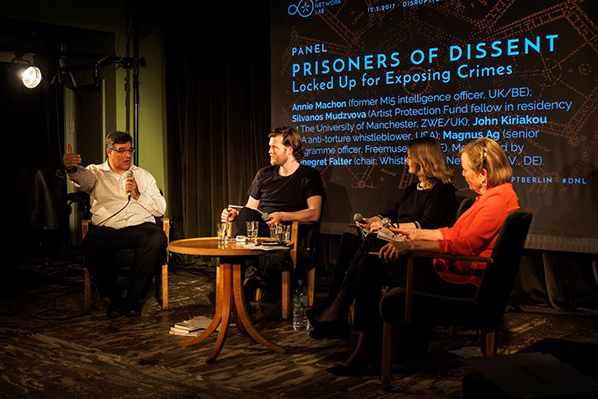
The tone of the event urgently suggested the necessity for a global paradigm shift on the perception whistleblowers: from a prosecuted traitor to a celebrated truth-teller. Such a shift would have to be underpinned by legislative means. The suggested solution was to rewrite laws so political dissent can be protected instead of prosecuted. Looking at the legal definition of a whistleblower, it is a person that sheds light on evidence of fraud, abuse or illegality in the public interest. Why would exposing crimes be followed by imprisonment?
One can hope that Chelsea Manning’s release sets an example to nourish new thoughts and laws for future whistleblowers to be better protected. Whistleblowers have always been important players in the modern political landscape within the democratic model. They refuse to conform to the hegemony, have moral principles, and an awareness of the power of information. As such they enable change for the better and for the more transparent which a fortiori reinforces the fundamental values of democracy: civil liberties, freedom of expression, participation, and peacemaking.
Without the courage of whistleblowers and activists who often put themselves in great danger, our world would look very different. This teaches us that one should practice dissent, be it as a whistleblower of injustices, in the field of arts, or in any form of disruption. In the words of Hannah Arendt, who Annegret Falter quoted in her closing of the panel: “Nobody has the right to obey”.
________
Photocredits: Thomas Schmidt
The next Disruption Network Lab event is planned for November, so make sure you follow DNL on their website on and on twitter
Support John Kiriakou‘s legal defence by buying his book here
Consider donating to the Courage Foundation supporting whistleblowers
Find out more about the Chelsea Manning Initiative Berlin and the Chelsea Manning Welcome Home Fund
Find out more about the work of the Whistleblower Netzwerk e.V.
Follow the speakers on twitter:
@JohnKiriakou
@AnnieMachon
@AgMagnus
@SilvanosVhitori
Review on PRISONERS OF DISSENT: Locked Up for Exposing Crimes, Berlin 2017. By Berit Gwendolyn Gilma
Techno-fixes are big business. Taking a quick look over the Financial Times’ list of the world’s largest companies[1], it might not surprise us that five of the top spots are occupied by corporations dealing in Information Technology. The looseness of this term connotes the production and dissemination of hardware, software and data, yet increasingly such companies are moving beyond this operational remit and have begun selling a vision of how life in its totality could—and should—be lived. Over the last decade, these so-called ‘Big Tech’ companies—Apple, Alphabet (Google’s parent company), Microsoft, Amazon, and Facebook—have sought to fashion bespoke technological ‘fixes’ to particular global crises, with the aim being no less than shaping the future of humanity itself. Facebook’s Aquila solar drone project, for instance, will help four billion people in disparate regions of the globe ‘access all the opportunities of the internet’[2]. Meanwhile, Alphabet’s experimental X subsidiary is developing Project Loon, a competing network infrastructure powered by a fleet of solar balloons[3] .Which connected future do we want: one with networks of balloons or drones? Or, more to the point: one filtered through the prism of Google’s or Facebook’s algorithms? The fictional character of Gavin Belson, the deranged CEO of the quasi-Facebook-Google mashup Hooli in HBO’s comedy series Silicon Valley, captures the bizarre competitive logic of Big Tech utopianism when he states with marked frustration:

It is not only the digital divide and the contingent possibilities of market expansion which Big Tech is claiming to ‘solve’ with these ambitious infrastructural projects. Climate change, healthcare, forced migration, democracy, and automation are all staked out in branded promotional media[4] as challenges which have imminent technological solutions—just a few ‘versions’ away. In such media, we are pushed forward into a time where these complex issues have been resolved, becoming conspicuous non-features of everyday life, unrecognized background conditions that allow us to marvel at the much more spectacular and exciting business of glossy technological innovations: the familiar gesture-controlled sheets of glass, the smart-everythings and the augmented-anythings.
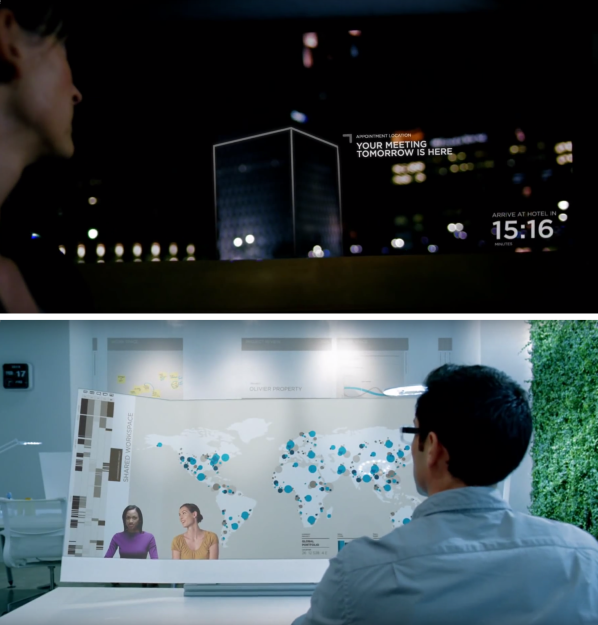
In these ‘design fictions’, as the Brazilian theorists Gonzatto et al. call such marketing campaigns, present crises ‘are anticipated and solved by technology’, proffering resolutions that ‘nurture consumers into consumption habits and convince investors of their capacity to fulfil those same demands’[5]. In this way, design fictions are replete with ‘solutionist’ fantasies where digital technology is positioned as a corrective to the challenges and irregularities of living. Solutionism, what Evgeny Morosov describes as an ‘intellectual pathology’[6] that can only consider problems in the form of their smart technical ‘fix’, nullifies any wider discussion of the problem at hand, abstracting the proposed resolution from the historical, social and political context of its implementation.
Therefore, whilst it is hard not to be seduced by the glossy ingenuity of projects such as Aquila and Loon, we ought to take a moment to question the frictionless future championed in these grand projects. The crises opened up and subsequently ‘solved’ by Big Tech companies scaffold the realm of present and future possibilities for our collective engagement: to determine a set of relations as constituting a crisis is to justify and arrange the ground for its resolution. For this reason, it is important to ask: Whose crisis is it anyway? Who has defined the problem that needs solving? And whose interests are being served by these proposed solutions? With such queries in mind, the benign qualities of design fictions are problematised, and their rootedness in the techno-politics of the present become plainly visible.

The recent publication of Mark Zuckerberg’s Building Global Community[7] manifesto affords such queries a timely focal point. At stake in Zuckerberg’s far-reaching manifesto is, in essence, the role that Big Tech can play in global governance. More specifically, it proposes the positive contribution that can come from Facebook’s direct engagement with the tasks of local and national security, the distribution and moderation of information, governmental politics, and fostering a post-national communalism.
These are indeed lofty ambitions, even for a company that boasts a quarter of the world’s population as monthly active users. However, Facebook purports to relish such a challenge, motivating employees by reminding them that the “journey is 1% finished”[8]. The ‘journey’ in question here is the fixing of what Facebook sees as a crisis of disconnection experienced by those almost exclusively situated in remote regions of the Global South. Facebook asks us to imagine how much better the lives of these ‘disconnected’ people could be if only they had access to the same degree of internet connectivity that those of us in the Global North enjoy on a day-to-day basis. With these sentiments in mind, the remainder of Facebook’s arduous voyage will largely be accomplished through the development of high-profile projects such as Internet.org, where the polished graphics of constituent programmes such as Free Basics and the aforementioned Aquila act as ethical avatars for Facebook’s very own brand of solutionism.

Zuckerberg claims that, ‘in times like these, the most important thing we at Facebook can do is develop the social infrastructure to give people the power to build a global community that works for all of us’[9]. Free Basics aims to provide a free-as-in-beer (but not free-as-in-freedom) curated portal to specific sites on the internet, providing information about healthcare, news, employment, and education to individuals who might otherwise live offline and thus disconnected lives. The humanitarian rhetoric follows that bringing ‘people online’ will ‘help improve their lives’ and additionally offer these societies ‘knowledge’, ‘tools’, and global connections—these are fundamentally good things worthy of our support, right? The predictable catch is revealed in Internet.org’s promotional material, whereby companies prospecting for new markets are offered a head-start on reaching ‘the next wave of people coming to the internet’[10], albeit through Facebook’s technical infrastructure and curatorial apparatuses. Such philanthropic endeavours, if successful, assist in consolidating the corporation’s present hegemonic position in future scenarios. For governments struggling with establishing network infrastructures, Free Basics proposes an attractively simple solution that, with Facebook’s capital and clout, can be quickly deployed and established. It is however a valuable foothold, one that prescribes a developmental course that entangles the technical apparatuses of the corporation with the task of future regional governance. This is the strategic-thinking which fuels the bizarre competitive logic of Big Tech utopianism, and which sits as the political kernel of future visions. It is the rhetoric of the real-life Gavin Belsons of Silicon Valley.
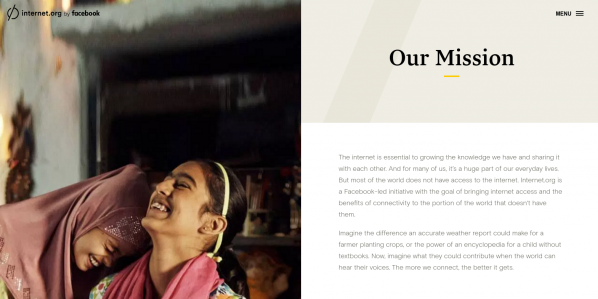
By determining that there is a crisis of disconnection, Facebook prepares the ground for its resolution in the form of projects such as Internet.org. The idea that a global community of connected Facebook users can level the systematic inequalities in wages, living standards, and welfare provision inherent to globalized capitalism is a resolution that erases the multiplicity of forces acting upon a complex array of interacting crises. In making this erasure, Facebook’s logic of development draws an uncomplicated line of progression from ‘unconnected’ to ‘connected’ subjects. Such thinking is as obviously reductionist, and contestable, as the pathways that lead from ‘boy’ to ‘man’, ‘young’ to ‘old’, ‘civilised’ to ‘uncivilised’. These binary terms edifying developmental logic are laden with normative significance, implying a way of thinking about the world that presupposes and prescribes a certain way of living within it. The interconnected and complex issues that contribute to global inequality—institutional structural biases, discriminatory trade relations, the experiences of colonialism, the exploitation of resources, to name but a scant few of a vast number—do not even come into the equation. In this schematic, Facebook’s own position in relation to these matters is unacknowledged. Furthermore, the position of humans as ‘Facebook users’ worldwide is not only rendered as neutral, closing off debate around value production and labour processes in digital capitalism, but positively imbued with some sort of higher moral purpose. What does it mean, then, for Facebook to imagine a time beyond crisis? To offer a resolution to the ‘problem’ of global disconnection? As Antoinette Rouvroy would argue, such thinking inoculates the present and ‘forecloses the future’[11].

This example of Internet.org does not simply aim to expose the economic incentives lurking behind such seemingly benevolent global projects—these motives should be obvious enough already. Rather, we hope to have opened up the conversation surrounding these future visions, and the possibility of techno-fixes in general, as a means to question how we as humans come to know, relate to, and interact with both the technological era we inhabit and the perceived ‘crises’ of our time. We suggest that determining the political qualities of a ‘crisis’ opens an essentially creative and interpretative space—one that leads to a recognition of both vulnerability and empowerment. To situate yourself within the field of imagined problems and potential resolutions is to shape the possibilities of your subsequent action. Being exiled from this process, by virtue of being exterior to the kind of walled-off discussions leading Internet.org’s various initiatives, leaves us neither vulnerable nor empowered. Rather, we find ourselves neutralized in the analytical inertia of solutionist design fictions and the galleries of seductive techno-fixes rendered within.
If solutionism presupposes techno-fixes which close off alternative paths of action, Network Diagnostics intends to provide a space that expands our ability to think beyond these prescriptive future visions of Big Tech. Using ‘troubleshooting’ as a methodological tool, we propose to collaboratively examine not just what such visions include, but, perhaps more significantly, what they leave out. We aim to hold open a space for creative analytical discussion, whilst shirking the call to find a rigorous ‘fix’ to what we discover. In doing so, we hope to invigorate the modes of analysis available to those interested in the relationship between humanity and technology in the era of big data capitalism. Our collective diagnostic of the future ultimately hopes to help people understand, live within, and resist the conditioning forces we currently face in the present. Whilst we are not proposing solutions, and we do not claim to have fixed the crisis of analytical inertia wrought by the pressure of technological advancement, our practice uninhibits critique by recognizing the empowerment of claiming vulnerability, and problematising the relations at work in foreclosed, prescribed crises. Whereas Facebook and other such organisations strive to ‘move fast’, we suggest that we should dwell thoughtfully in the process of diagnosis in an effort to self-reflexively decouple the crisis from its readymade solution.
—
Niall Docherty is a PhD candidate at the Centre for Critical Theory at the University of Nottingham. His research involves an analysis of Facebook within the neoliberal context of its inception and current use, through the frames of governmentality and software studies.
Dave Young is an artist and a M3C/AHRC-funded PhD candidate at the Centre for Critical Theory at the University of Nottingham, and is currently researching bureaucratic media and systems of command and control in the US military since the Second World War.
In which the spectre of the Luddite software engineer is raised, in an AI-driven future where programming languages become commercially redundant, and therefore take on new cultural significance.
In 1812, Lord Byron dedicated his first speech in the House of Lords to the defence of the machine breakers, whose violent acts against the machines replacing their jobs prefigured large scale trade unionism. We know these machine breakers as Luddites, a movement lead by the mysterious, fictional character of General Ludd, although curiously, Byron doesn’t refer to them as such in his speech. With the topic of post-work in the air at the moment, the Luddite movements are instructive; The movement was comprised of workers finding themselves replaced by machines, left not in a post-work Utopia, but in a state of destitution and starvation. According to Hobsbawm (1952), if Luddites broke machines, it was not through a hatred of technology, but through self-preservation. Indeed, when political economist David Ricardo (1921) raised “the machinery question” he did so signalling a change in his own mind, from a Utopian vision where the landlord, capitalist, and labourer all benefit from mechanisation, to one where reduction in gross revenue hits the labourer alone. Against the backdrop of present-day ‘disruptive technology’, the machinery question is as relevant as ever.
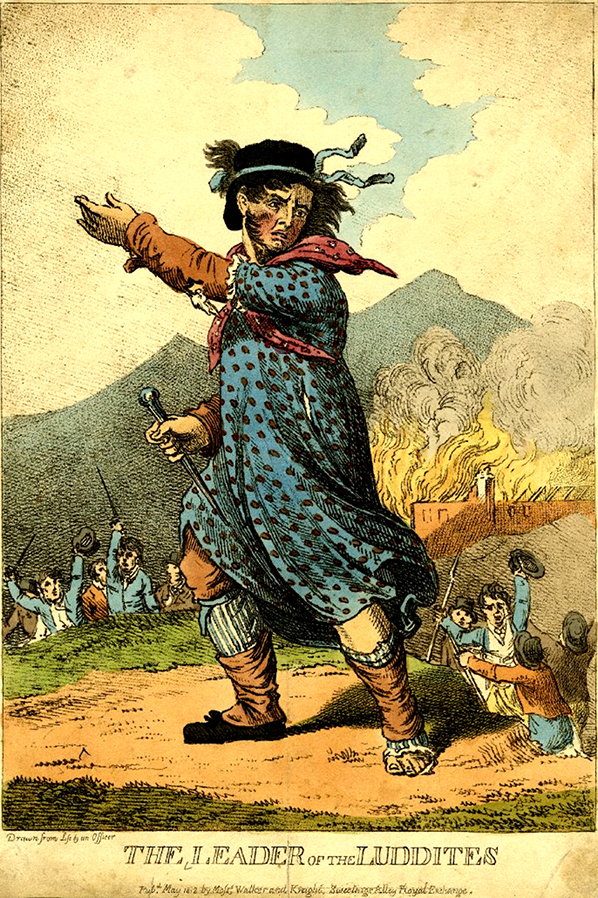
A few years after his speech, Byron went on to father Ada Lovelace, the much celebrated prototypical software engineer. Famously, Ada Lovelace cooperated with Charles Babbage on his Analytical Engine; Lovelace exploring abstract notions of computation at a time when Luddites were fighting against their own replacement by machines. This gives us a helpful narrative link between mill workers of the industrial revolution, and software engineers of the information revolution. That said, Byron’s wayward behaviour took him away from his family, and he deserves no credit for Ada’s upbringing. Ada was instead influenced by her mother Annabella Byron, the anti-slavery and women’s rights campaigner, who encouraged Ada into mathematics.
Today, general purpose computing is becoming as ubiquitous as woven fabric, and is maintained and developed by a global industry of software engineers. While the textile industry developed out of worldwide practices over millennia, deeply embedded in culture, the software industry has developed over a single lifetime, the practice of software engineering literally constructed as a military operation. Nonetheless, the similarity between millworkers and programmers is stark if we consider weaving itself as a technology. Here I am not talking about inventions of the industrial age, but the fundamental, structural crossing of warp and weft, with its extremely complex, generative properties to which we have become largely blind since replacing human weavers with powerlooms and Jacquard devices. As Ellen Harlizius-Klück argues, weaving has been a digital art from the very beginning.
Software engineers are now threatened under strikingly similar circumstances, thanks to breakthroughs in Artificial Intelligence (AI) and “Deep Learning” methods, taking advantage of the processing power of industrial-scale server farms. Jen-Hsun Hu, chief executive of NVIDIA who make some of the chips used in these servers is quoted as saying that now, “Instead of people writing software, we have data writing software”. Too often we think of Luddites as those who are against technology, but this is a profound misunderstanding. Luddites were skilled craftspeople working with technology advanced over thousands of years, who only objected once they were replaced by technology. Deep learning may well not be able to do everything that human software engineers can do, or to the same degree of quality, but this was precisely the situation in the industrial revolution. Machines cannot make the same woven structures as hands, to the same quality, or even at the same speed at first, but the Jacquard mechanism replaced human drawboys anyway.
As a thought experiment then, let’s imagine a future where entire industries of computer programmers are replaced by AI. These programmers would either have to upskill to work in Deep Learning, find something else to do, or form a Luddite movement to disrupt Deep Learning algorithms. The latter case might even seem plausible when we recognise the similarities between the Luddite movement and Anonymous, both outwardly disruptive, lacking central organisation, and lead by an avatar: General Ludd in the case of the Luddites, and Guy Fawkes in the case of Anonymous.
Let’s not dwell on Anonymous though. Instead try to imagine a Utopia in which current experiments in Universal Basic Income are proved effective, and software engineers are able to find gainful activity without the threat of destitution. The question we are left with then is not what to do with all the software engineers, but what to do with all the software? With the arrival of machine weaving and knitting, many craftspeople continued hand weaving and handknitting in their homes and in social clubs for pleasure rather than out of necessity. This was hardly a surprise, as people have always made fabric, and indeed in many parts of the world handweaving has remained the dominant form of fabric making. Through much of the history of general purpose computing however, any cultural context for computer programming has been a distant second to its industrial and military contexts. There has of course been a hackerly counter-culture from the beginning of modern-day computing, but consider that the celebrated early hackers in MIT were funded by the military while Vietnam flared, and the renowned early Cybernetic Serendipity exhibition of electronic art included presentations by General Motors and Boeing, showing no evidence of an undercurrent of political dissent. Nonetheless, I think a Utopian view of the future is possible, but only once Deep Learning renders the craft of programming languages useless for such military and corporate interests.
Looking forward, I see great possibilities. All the young people now learning how to write code for industry may find that the industry has disappeared by the time they graduate, and that their programming skills give no insight into the workings of Deep Learning networks. So, it seems that the scene is set for programming to be untethered from necessity. The activity of programming, free from a military-industrial imperative, may become dedicated almost entirely to cultural activities such as music-making and sculpture, augmenting human abilities to bring understanding to our own data, breathing computational pattern into our lives. Programming languages could slowly become closer to natural languages, simply by developing through use while embedded in culture. Perhaps the growing practice of Live Coding, where software artists have been developing computer languages for creative coding, live interaction and music-making over the past two decades, are a precursor to this. My hope is that we will begin to think of code and data in the same way as we do of knitting patterns and weaving block designs, because from my perspective, they are one and the same, all formal languages, with their structures intricately and literally woven into our everyday lives.
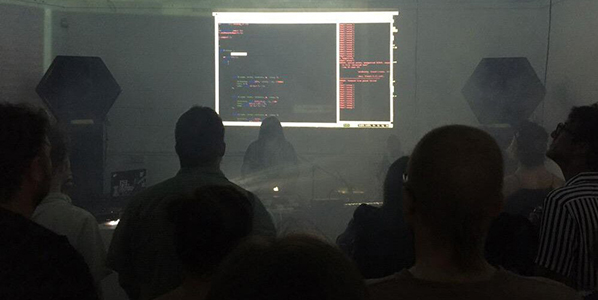
So in order for human cultures to fully embrace the networks and data of the information revolution, perhaps we should take lessons from the Luddites. Because they were not just agents of disruption, but also agents against disruption, not campaigning against technology, but for technology as a positive cultural force.
This article was written by Alex while sound artist in residence in the Open Data Institute, London, as part of the Sound and Music embedded programme.
What would you do if your partner was spending 17 hours a day online to earn a living? This short dystopian fiction by Elliott Burns paints an unsettling vision of a Gamer/YouTuber’s life(style) slipping out of control…
posted February 22nd 2017
“Wow, just WOW everyone! So I’ve got some really big news I want to share with you… Earlier today, after I finished my lunch, Kung-Pow Chicken Sub by the way, I went into my boss’s office and calmly explained that I would be leaving the company. So I am now t-minus two weeks until I walk out those doors for the last time EVER.
Why am I doing quitting? Because of YOU! Because of everyone out there who follows this channel, who watches these videos, who makes up this community. After 3 years posting video after video after video, this channel now makes enough in YouTube advertising revenues for me to dedicate my life to it!”
[he holds a wireless webcam with his right hand; raised up it faces back towards him and the room, behind are drawn curtains, shelves of video games and collectable figures, his computer set up and a pro-gaming chair.]
“I want to say a huge thank you to everyone of you! This is a dream come true, for me, my wife (going on 6 months now guys), and our puppy.”
[crouching down with his left hand he raises a small fluffy dog to his chest.]
“Say “hi” Jasper, say “hi” to everyone. Jasper’s really happy that Daddy gets to stay home all day now and doesn’t need to leave him alone. You know what else it means… it means from today onwards I’ll be posting more videos, more of the content that you LOVE, like this:”
[the screen switches to footage of a plane pulling a barrel-roll over a middle-Eastern oil refinery; overlaid his voice can be heard erratically.]
“This is Goose Feet! OVER! Deploying payload,”
[just before the right-wing clips a tower, pulling to first-person perspective he is launched into the air, rifle in hand, screaming:]
“MAYDAY MAYDAY pilot down over enemy territory,”
[pulling his chute.]
“I’m going in hard, guns blazing, send EVAC NOW, this is not a drill, I repeat NOT-A-DRILL!”
[the screen switches back to him in his room.]
“Not to mention our times together…”
[now we see a squad of armour clad super soldiers charging up a hill, plasma blasts rain down overhead from multi-jawed aliens and explosions erupt either side; amongst the chaos and lighting-effects he’s heard reciting the Micky Mouse Club theme tune:]
“Who’s the leader of the club, That’s made for you and me, M-I-C-K-E-Y M-O-U-S-E,”
[as his team mates respond with burst of laughing and cries of:]
“SHUT THE F*** UP.”
[back in his room again he pants, physically exerted by his excitement.]
“But most important of all, it means I can dedicate more time, NAY, dedicate my life to showing off the best-of-the-best of your clips, the greatest examples of battle from all over the world! Every week I will be showing the most courageous, outrageous and outright insane feats of computer game brilliance that you send me. And each week you can vote on who is the greatest-of-the-great. The insanest-of-the-insane.
Because I LOVE you guys, I LOVE that you’ve invested in me, this channel, this community that we’ve built together. Keep the likes, the comments, the shares, everything coming. Follow me on YouTube, on Facebook, on Instagram. There’s going to be competitions, give-aways, constant non-stop banter-rific laughs…”
[his focus trails off slightly, pulling out of character before dropping back in…]
And of course, as always, my content is free to view. Subscribe and help me continue making this dream come true, and check out my online-store (link in the description below) for some excellent merchandise!
I can’t say how much this means to me. All your support, it makes my life worth living… So for now, until next time, PEACE OUT, SandCastle128.”
[the screen splits into 12 pieces showing a selection of related videos]

March 1st 2017 00:23am
Downstairs the kettle is whistling; it’s on the gas and there’s no sign anyone will take it off soon. His wife is asleep with the dog curled up by her feet. In ‘his office’ the glow of his monitor illuminates his face, providing enough light for the webcam to see him, yet leaving the background in darkness.
With his headphone-mic set he can’t hear the kettle. He won’t notice it until this round is over with either the terrorist or tactical-squad winning.
He’s entered the villa through an open first-floor window. Downstairs a firefight is breaking out as three teammates try to catch the terrorists in a pincer movement, breaching from the front and back entrances. He’s careful to avoid traps, they may have left explosive around any corner, or could be camping, waiting for him to make a mistake. Any second now his team should be able to identify how many hostiles are on the ground-floor; however, until then he’ll need to exercise extreme caution.
The fifth member of their squad is holding back, sniper scope poised to take a shot through any exposed window. It’s the third round and they’re two games down, the enemy are co-ordinated so they’re working to draw them out.
His teammates report comes in: “They’re all on the ground floor. SandCastle128, on my mark, assault from the main stairs.” A deafening volley of machine gun fire opens up, his HUD reports one target down, sniper fire takes a second. “GO GO GO.” He runs into the fight, catches two targets from behind, raises his shotgun to iron sight and pulls the trigger.
His wife smacks him round the back of the head. His shot misses and the targets turn filling him with lead. “Kettle’s boiled, I’m going back to bed!” That live-stream went out to 4,156 people on Facebook.
To read the rest of the story, please download Top 10 Plays of the Week as a PDF
Feature image:
Trust Me, I’m an Artist: Jennifer Willet and Kira O’Reilly, Be-wildered, 2017. Photo: Nora S. Vaage
Trust Me, I’m an Artist is an exhibition organized in cooperation with the Waag Society at Zone2Source’s Het Glazen Huis in Amstelpark, in the outskirts of Amsterdam. It is a culmination of a Creative Europe-funded project, aiming to explore ethical complexities of artistic engagements with emerging (bio)technologies and medicine. The explorations in the exhibition have taken place through a play on the format of ‘the ethics committee’. In university contexts, particularly within medicine and the natural sciences, researchers need to submit their proposals to ethics committees to check whether their proposed projects comply with the relevant ethical guidelines, and to point to any issues the researchers hadn’t thought of. In the last couple of decades, as artists have increasingly taken part in institutional settings, even becoming residents in scientific labs, they too have sometimes been faced with these committees. The Trust Me, I’m an Artist project has included a handful of artists’ proposals to ethics committees, performed in front of an audience. Some of the exhibited pieces are documentation from those events, and are aesthetically somewhat unfulfilled. As thought-provocations, however, they still work.
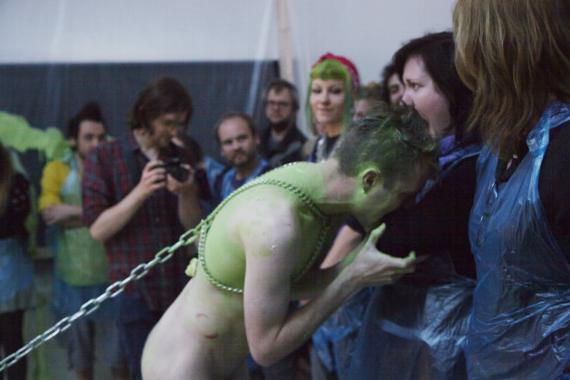
Het Glazen Huis is, indeed, made mostly from glass, which creates the effect that the park outside enters into the exhibition room. For this exhibition it seems fitting, as the artworks deal, in various ways, with living things. While one of the pieces, Špela Petrič‘s Confronting Vegetal Otherness: Skotopoiesis, focuses directly on plants (more on that later), the only direct conversation with the green exterior is a pile of soil, generously run through with green specks of glitter, crowned by a striking headpiece topped with tall green feathers, which seems to mirror a fern plant of about the same height on the other side of the glass wall. The soil/hat construct is paired with a strange frock, constructed from old labcoats, but with frills and a cut resembling a 17th century garment, and far from white. The front and back of the coat is decked with transparent orbs, resembling snow globes. Each of them contains a different set of microbes, placed there through various acts of swabbing the environment or asking artist colleagues for donations in the form of mucus.
The frock and the soil concoction are the remnants of a performance by Jennifer Willet and Kira O’Reilly, which took place at the Waag Society the night before the exhibition opening. Willet was wearing the repurposed labcoats, O’Reilly the green headgear and a sparkling green dress inspired by drag and camp aesthetics. For much of the three-hour event, they talked about trust: what does it mean to trust? Do these artists trust themselves? O’Reilly stated that she is not sure she even values trust that much. They shared stories about their previous work, toasted with champagne, and interspersed their conversation, gradually, with elements of a “project proposal”.
O’Reilly, with Willet’s help, coated her arms in whisked eggs, as a base for green glitter. She showed examples of previous performances she had done using such glitter, often in the nude and sometimes involving fertilized chicken eggs. An hour into the performance, Willet revealed that her garment had been buried in soil at a conference, where people were encouraged to do stuff to the soil over the week: composting, urinating, etc, which explained the coat’s uneven, brownish tint. Only towards the end of the performance did she tell us that the globes were repurposed bowls made into “petri dishes”, filled with agar and ready to serve as a growth medium for various microorganisms. She then swabbed the jacket, swiping it onto the agar in one of the bowls, then swabbed O’Reilly’s nose. Willet proposes to wear another coat in the laboratory for a year, exposing it to various microorganisms, and to also wear it at home around her twin daughters, reflecting on how we large mammals serve in any case as carriers for all sorts of microbes. The ethics committee considered this a risky and unlikely aspiration, and did not think she would be allowed to go through with it. They did, however, encourage her to consult with them in developing her idea. A similar response was given to O’Reilly, who wants to cover a pine tree in Finland in glitter, reflecting on how her use of glitter is contributing to plastic pollution, and to work with a dead farmed salmon that she would get directly from a fish farm in Norway. At the end of the performance, O’Reilly unfolded a plastic sheet, spread three bags of soil onto the plastic, poured a bowl of glitter on top, and mixed it with her hands in a languid, beautiful way. She fetched a gutted whole salmon from a fridge, sprinkling glitter on it as well. Both of them, thus, did part of what they are proposing to do for their project already during the “ethics consultation”, challenging the format. But they reflected at the close that the opportunity to think extensively on the ethics of their ideas was rewarding and important.
Martin O’Brien‘s Taste of Flesh – Bite Me I’m Yours is also documentation of a performance, which he did in London at Space c/o the White Building, in April 2015. His performance was an exploration of endurance, pain, and the overstepping of intimate boundaries. Working with his own body, O’Brien seems to have embraced the facts of living with a genetic disorder, Cystic Fibrosis, to the full. The disease causes him to produce a lot of mucus, and be short of breath.
Over a number of hours, he did a series of actions; chaining himself, biting people, being bitten, coughing up mucus, crawling around in a way that was inspired by the zombie as metaphor for being sick. He played with the fear that interaction will result in contagion, and with S&M paraphernalia and the limits between pain and pleasure. In the exhibition we see the performance on a projection taking up a whole wall, and five small, parallel video screens showing different parts of the performance. Remnants of the paraphernalia he used are exhibited on a plinth. The films in part convey the intensity and some-time repulsion that the performance must have inspired.

Petrič’s work Skotopoiesis is less explicit, and perhaps less provocative to most. In the exhibition, we see a photograph of a field of cress, with the outline of a human shadow making the center cress paler than the rest. By standing in front of the field, preventing the light from falling onto the same spot for 19 hours a day, three days on end, she created a visible imprint of her body, through cress that grew to be longer and paler than the neighboring plants that got direct sunlight.
Plants do not follow same rules of agency as animals. We cannot easily relate to them, although some, such as trees, seem to have more presence and individuality. Grass, on the other hand, is impossible to think of as single entity. Often, as part of the ethics procedure, researchers are asked if they can use plants rather than animals, as current perceptions of what is ethical tend to exclude plants from our ethical consideration. Petrič wanted to challenge the committee with something anti-spectacular, where it would be difficult to see ethical issues. Through existing with plants, trying to conform to their timescale and mode of existence, but also modifying them through her very presence, she entered into a pensive engagement not just with the plants themselves, but with the ethics of our coexistence with them. This seems quite a timely, as recent studies show plants to have more sensations, reactions, and even abilities of communication, than has previously been thought. Given this, our disregard for the life of plants may be seen as a great ethical challenge.
Artist Gina Czarnecki and scientist John Hunt, in the piece Heirloom, created masks in the shape of Czarnecki’s two daughters’ faces, grown from their skin cells over glass casts. This, too, is shown on several video screens, as documentation of the actual installation of the bioreactors in which the masks were grown. The artist wanted to preserve her daughters’ youthful likenesses, and the idea led to the development of a new, simple set-up for three-dimensional cell growth. One of the tricky ethical issues here is that of the ownership of a child’s cells. As the girls’ parent, Czarnecki could herself consent to using their cells in this way. They were happy to participate at the time, but does this kind of artistic, experimental use constitute “informed consent”? At the opening, Czarnecki observed that her daughters, moving into their mid-teens in the three or so years since their skin samples were taken, had become less comfortable with being on display in this way.
The videos show fascinating glimpses of the process, footage of the masks inside the bioreactors, flashing shots of the daughters’ faces, and narrations by the key actors. At one point in the video, Hunt describes how he and two of his fellow researchers both came into the lab because they were worried about the skin cells being contaminated. Without having anything to do there, they sat together and watched over them. A rare admittance of the personal bonds that can be formed with cell cultures, and reasons for action that are far from the rational.
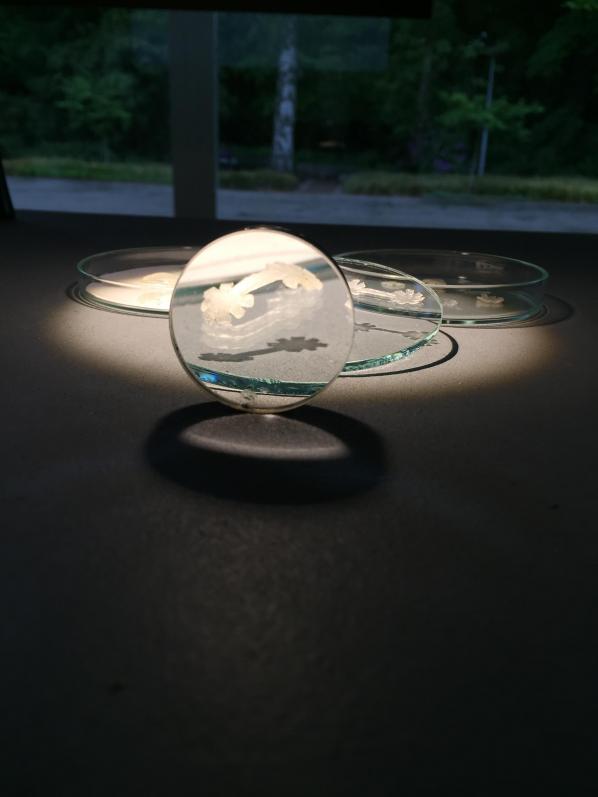
Howard Boland‘s Cellular Propeller is represented in the exhibition through a few sculptural elements and photos. The project started as part of his long-time engagement with synthetic biology, and his ambition was to work with living, moving cells, attached to inorganic structures, to play with the old idea that “If it moves, it is alive”. Originally he hoped to use heart cells from new-born rats, but this proved difficult. Instead, he ended up using his own sperm cells, which are much more easily available, and share the ability to move. He created coin-sized, wheel-shaped plastic scaffolds that the sperm cells can ideally attach to, serving as “propellers” to literally,move the human cells, although this does not happen in a predictable way. In the exhibition, we saw reproduced the little plastic scaffolds, but not with the cells “in action”.
With the change from heart cells to sperm, the connotations of the piece changed slightly; while the question of “what is living” remains, reproduction, birth and movement still being central to the piece, the use of sperm also brings in ideas about pleasure and the surplus production of cells through recreational sex. Through repurposing sperm cells for the mechanical task of moving these wheels, Boland shifts the discussion towards life without the basic “meaning” that reproduction conveys.
“Controlled Commodity” by Anna Dumitriu features a dress from 1941, also exhibited on a headless mannequin, and mended with patches containing gene-edited E. coli bacteria. An example of wartime austerity, the dress is CC41 – controlled commodity 41. Dumitriu stresses the fact that 1941 was the first year that penicillin was used, and unlike clothing, this was not a controlled commodity. Overuse of antibiotics over many years has led to the current crisis, with more and more bacteria becoming resistant to the antibiotics we commonly use.
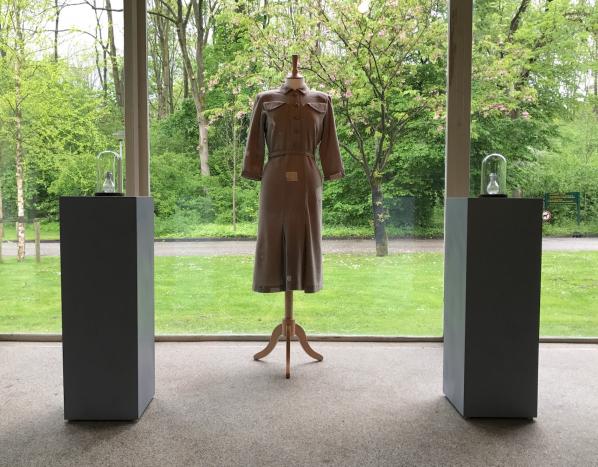
Through participation in the Future and Emerging Art and Technology program, Dumitriu was an artist in residence in an Israeli lab, and worked with the much-hyped, much-discussed CRISPR-Cas9 technology. The use of CRISPR for gene editing is currently being presented as a much easier way to insert or remove genetic information. In this case, Dumitriu used it to remove a gene for antibiotics resistance.
When she had to create a repair fragment to patch the bacteria back together, she used the phrase ‘make do and mend’, an explicit reference to WWII history. Dumitriu grew the CRISPRed bacteria on silk, sterilized them, and sewed the E. coli patches onto the (somewhat moth-eaten) dress. In addition to the dress, she is displaying the plasmid created using CRISPR in a little glass vase, only covered with aluminum foil – and without having asked permission. In an identical glass vessel, little paper circles contain all the antibiotics in commercial use.
The piece is rich, complex, and daring. In editing the genome of E. coli bacteria to remove an ampicillin antibiotic resistance gene, Dumitriu is proposing a potential solution to the pervasive problem of antibiotics resistance, which might also be ethically problematic: such suggested solutions being “around the corner” might lead to less focus on discovering new antibiotics, or the sense that continued over-use can be maintained. Also, her insistence on exhibiting plasmids in the gallery is not high-risk (as far as we know, plasmids need some sort of shock effect to be taken up by bacteria), but it does seem a somewhat unnecessary exposure. Dumitriu’s CRISPR work will be discussed in a Trust Me… event at the British Science Festival in Brighton in September.
Open Care – Inheritance, by Erich Berger and Mari Keto, imagines a personal responsibility for nuclear waste, in the form of radioactive family jewellery that goes from generation to generation, in the hope that you might one day wear it. The jewellery is kept in a radiation-proof container, and for each generation that takes over its care, it can be tested to see if the radioactivity has gone down to a safe level, so that “the jewellery can finally be brought into use and fulfill its promise of wealth and identity or if it has to be stored away until the next generation” (quote from the exhibition catalogue). The jewellery box and low-tech tools to check its radioactivity are exhibited behind a glass wall. This thought experiment suggests that the unimaginably long timespans that it takes for radioactivity to subsist can be broken down into spans of time that we can relate to. The personal nature of such family jewellery creates an emotional narrative of very personal responsibility for the waste we produce.
The artistic license seems to be to challenge, stretch, and provoke, and indeed, the artworks in this exhibition both challenge and stretch our views on what responsibility means. So, can we trust what these artists are up to? One never knows, but through engaging in these extended conversations with the public and hand-picked committees, they do give us new grounds for reflection on ethics, trust, and responsibility in science, in society at large, and in art.
Note: I saw this exhibition during the opening, and some elements were still not up and running.
Feature image:
Iza Pavlina, “Rule 34”, solo exhibition, Aksioma Project Space, Ljubljana, Slovenia 19 April – 12 May 2017
The Aksioma Project Space hosting Iza Pavlina’s “Rule 34“ exhibition is an immaculate visual realisation of a lifestyle minimalist’s wet dream. There are two large video projections covering the surfaces of opposite walls in the white cube. Another set of four monitors is tilted on the floor, beaming at you towards the center of the space. All projections show the same composition of a young woman, the artist herself, on a clear background, overwhelmingly beautiful and innocent, mildly disinterested, bare-shouldered, engaged in playing repetitively with a different toy in each video. The third wall is neatly adorned with a set of six C-print photos with the same flawless composition. The last wall presents outlined drawings of yet the same composition, stamped with a QRcode of pages like Pornhub, xHamster, and Xvideos. Each QRcode leads to the artist’s profile on different social media sites, where the same set of perfect videos are presented. Perhaps you have no idea what these sites are, but if you are one of a quarter of internet users who frequent online porn sites, the chances are that your own profiles on these sites are your deeply buried dirty secret.
Much like any other of your favorite social media sites, porn sites include a public profile for the gaze of all your friends and a private space for personal chats. How Web 2.0 has changed the meaning of concepts such as friends, public and private space is beside the point; What is meaningful for the exhibition is that Pavlina lets you take a sneak peek into private messages she has had with her friends, or rather fans, on these sites. For this private viewing, she adopted an exhibition format called “offline art”, which was initially developed by German artist Aram Bartholl. Essentially, every video or photo is connected to a local Wi-Fi router, which lets you hub into a specific private chat. Here is where the titillation, arousal, curiosity, surprise, even shock or disgust emerge – here, in this secret hidden space, where the boundaries of mainstream porn as we know it are challenged and explored.
Somehow, Pavlina’s interest in sexuality, pornography, and paraphilias is well summarized in the title itself. The rules of behaviour for being on the internet were posted on meme-sharing sites like 4chan.org sometime back in 2004. Rule 34 says: “There is porn of it, no exceptions.” The following two rules clarify the statement. Rule 35 says “If no porn is found of it, it will be made,” and Rule 36: “There will always be more fucked up shit than what you just saw.” [Paasonen, 2011] These three rules alone show that the diversity of pornographic exploration has exploded with the easy accessibility and seeming anonymity of online identities. Social taboos have been lost somewhere in the translation of the meaning of the virtual i.e digital. For a time, it was believed online porn had little effect on the corporeal, and the social taboo and guilt associated with it seemed not to be applicable. But it has turned out that fiddling with oneself on the internet is just as carnal. As a young artist in her 20s, Pavlina started exploring the subject a few years ago with her half-hour video piece “Talk to Strangers!” (2014). This piece was edited from online video chats, during which she pretended to be a 14-year-old girl. With this piece, she was trying to “highlight and expose in an original and unobtrusive way the global issue of disorders of sexual preference and the incidence of paedophilia on the World Wide Web”. However, in the “Rule 34” exhibition, she takes a turn from a legal and moralistic point of view towards a more uncharted and ambivalent pornographic landscape. Interestingly enough, the kink of mainstream heteronormative sexuality is a topic which really appeals to artists and researchers alike. There is a wide acceptance and interest for alternative porn in the arts, whether it is vintage, humorous or LGBT, while the mainstream is often disregarded as tacky, normative or even filthy. The first set of genres is easy to read since they obviously produce a set of meanings in the field of cultural critique. The mainstream, however, bemuses.

Now it is time to explore the toys Iza Pavlina is playing with. For her videos, she has chosen a set of less known and quite surprising paraphilias, which produce an intense sexual arousal for specific individuals. The activities may seem usual or even quite ridiculous to another individual who is turned on by something completely different. In the process of making “Rule 34”, she has uploaded the videos to her profile on various pornographic social media sites with the name of a specific paraphilia and a teasing description such as “Agalmatophilia: Virgin turns into a fuck robot”, “Balloon fetishism: Young looner babe blowing her first balloon”, “Exophilia: Nasty girl playing with balls”, “Pony play: Wild pony getting trained”, “Plushophilia: Hot naked blonde cuddling her teddy bear”, “Trichophilia: Submissive bitch gets her hair chopped off”. In these descriptions, there are a number of clichéd identifications such as blondeness, paleness, youthfulness and submissiveness, which suggests a blunt disregard for the question of race and other identities, yet she somehow evades the need for the interpretation of her actions. The videos are visceral and saturated with body and presence, yet surprisingly unintrusive. Her action is not trying to identify with the fetish nor to imitate the fantasy, but to become it. And she does so with a laboratory accuracy. The work seems to treat corporeality in Elizabeth Grosz’s terms, proposing the presence of the body without the need to reduce it to semiotic inscriptions or the assertion of meanings.
Even though the artist creates a set of online identities, she seems not to be interested in the question of mimicry or fake personalities. On the contrary, she becomes and plays with these identities, interacting with her friends or rather fans, who she teases, tempts, and attracts. She is interested in the performativity of the body, and its capability to speak for itself. As Susan Paasonen would put it, the interest lies in “resonance”, which equally “encompasses the emotional and cognitive as well as the sensory and affective” (Paasonen, 2011, 27), producing intensity, appeal, and force. “Rule 34” does not produce any metaphorical meaning, and perhaps this novelty within the storytelling of a young generation becomes most obvious if we try and compare it to an older example of paraphilia in arts. For example, we may associate the injury fetishism, which Pavlina also explores, with J.G. Ballard‘s book “Crash” and its film translation by David Cronenberg. Ballard himself explained it as a result of “the marriage of reason and nightmare, which has dominated the 20th century with its sinister technologies and the dreams that money can buy”; It is a “the merging of sex and paranoia” and “the death of affect”.

Pavlina however, finds no fear in the omnipresence of technology and the visceral connection between the human body and technological tools. She seems to value only the “resonance” of technology, regardless of what cultural conditions it is produced in. She is liberating the list of fetishes and fantasies from the history of treating sexuality in clinical terms, since the normality of desire has been culturally produced and theoretically reduced to a psychoanalytic understanding of suppressed memories, phobias and philias. There is absolutely nothing psychoanalytical about “Rule 34”. The artist goes against the understanding of paraphilias as objects of perversions. She plays and enjoys the outcome, communicates with fans and haters, and even lets the gallery visitor to sneak peek into private messages with particularly kinky content. One of these is “Cum Tribute” – the act of cumming on a printed picture, monitor or pad, which has so often been contributed to her gorgeousness, that she received in private messages for every video she uploaded. By documenting such actions, she has archived a behavioural phenomenon that is completely off the chart from conventional archives, and in her playful exploration of mainstream porn, she seems to reassure: there is nothing normative about any sexuality and that’s just fine.
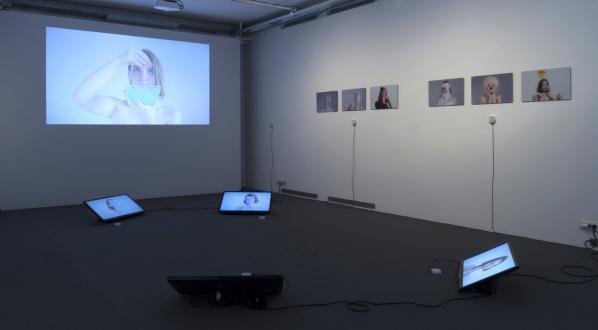
Featured image: Donald Trump as a God
“There I was faced with my nemesis, reading. It isn’t that I flubbed the words, or stumbled and mispronounced; I even placed the emphasis on the right syllable. I just lack personality when I read. The second day I was introduced to the rushes. This is the custom of going at the end of each day’s work and seeing on the screen what you shot the previous day. What a shock it was!”
-Ronald Reagan in 1937
Donald Trump has a face moulded from a slowly drooping wall of pitch. The languorous slump of his chin is accentuated by a zealous orange complexion and hi-definition makeup creases—his physiognomy would be an intricate though grotesque addition to the faces scarring the side of Mount Rushmore. Topographically speaking though, his jib is markedly less stately than Lincoln’s staunch jaw: the line from The Donald’s chin-to-neck sloping lazily in a curve that flaps and wobbles with the exaggerated gymnastics of his puckering-unpuckering mouth.
Trump’s iconic visage has dominated the memeplex for months, corrupting our newsfeeds with bust-like portraits of a man whose Tang-coloured tanning cream has since inspired a litany of derogatory epithets. Yet one of the remarkable characteristics of his campaign and its corresponding media coverage was how effortlessly both so-called mainstream media and internet culture latched on to Trump’s face as a cultural and political meme.
We can see the reproduction of iconographic power at work with a brief review of the 2016 election cycle. While campaigning for his ascensions to the Presidency, news networks depicted Trump’s head as visually emancipated from the fleshly anchor of his body, utilizing a close-cropped frame as a political device to craft caricatures by leveraging his most noticeable features—a lumpy chin, puckered mouth, wispy hairpiece. Here we see the head of God-Emperor Trump. Trump’s profile an image figurative of the head of state, the corporeal body transformed into the body politic that is an icono-graphy ready for reproduction and primed for cross-pollination with the memeplex. In fact, images of Trump’s face were so abundant during the lead-up to the election that an ur-typology of Trump media began to crystallize as campaign season progressed: Trump, face isolated, with hair-piece captured in striking relief against a backdrop of blurry patriotic signifiers. (The vertiginous swoop of sallow hair and recumbent double chin looms as pervasive and recognizable as the gaminesque contours of a perverse Pixar character in profile.)
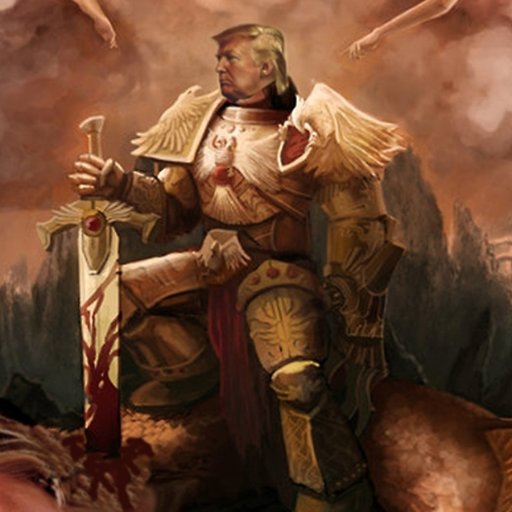
Trump entered the 2016 race with decades of brand-management experience: his reality TV presence cemented the immediate recognisability of the TRUMP trademark, endowing his face with the universality and divine potency normally associated with the glittering icons of Byzantine Christianity. So, I wonder what Trump thinks when he looks in the mirror—he does not seem to grapple with contemplating himself in the eyes of others, as the professional actor-cum-president Reagan did, enshrining his Presidential role as the ultimate piece of character acting, fraught with tortured considerations about the role of self-image, self-perception and the externalization of the indexical viewpoint of the acting eye. Reagan was concerned with how others perceived him, as Trump is. But Trump is a businessman and seems to outsource concern for his image, treating it as a theatrical production supported by the labour of an elaborate team of technicians, brand-managers, lawyers, make-up artists, photographers…As an actor, however, Reagan was fastidious about contemplating his own performance, making and remaking himself to suit his own ever-changing, idealized self, performing his image as he wanted others to see it.
***
The most recent internet exhibition from the German collective UBERMORGEN continues the obsession with Trump’s visage in an online exhibition recently hosted by London gallery Carroll / Fletcher, which features the faces of Donald Trump and Melania Trump rendered in .gif format and created by UBERMORGEN, the Swiss-Austrian-American duo consisting of lizvlx and Hans Bernhard. Their recent work, Neue Ehrlichkeit (trans. “New Honesty”) contains two gifs: one of Trump and one of Melania, the frame cropped so close to their faces that you can see Trump’s ear piece and discern the mascara clumps adhering to Melania’s eyelashes. The gifs move manically, flipping over the y axis, invisibly bisecting the frame at vertigo-inducing speed. As you continue to watch the gif flicker, it seems to accelerate uncontrollably even though the timing of the gif loop is unvarying. Combined with the drooping jowls and brillo-pad eyebrows of Trump – details that linger for a static nanosecond in the mind’s eye – the effect is even nauseating.
UBERMORGEN preface this recent work with the following exclamation:
“The post-factual world is not a new phenomenon, not at all! But I love that the world has finally come to an agreement and I love the idea that there are so many others consensually hallucinating with us in understanding the fact that we are part of a post-factual world without ever having been in a factual world.” UBERMORGEN, Truth-Tellers Conference, Berlin, 2016
The “fact that we are part of a post-factual world” is a resolvable contradiction – UBERMORGEN’s idea of “new honesty” in a nutshell. The new honesty of post-factuality expresses anxieties about the transformations brought forward by digital technologies, but seems to (incorrectly) cite the internet as the culprit causing the erosion of trust in utterances made both off and online. (And if we learned anything from continental philosophy’s critique of empiricism, it’s that empiricism as an epistemic framework places truth and falsehood on the same fragile fulcrum, separated only by a collective delusion known as “evidence.”) One kind of post-factual phenomenon, fakeness, seems to elicit particularly virulent and hysterical reactions. Fakeness feeds on the production of virality. Fake news flourishes not only because of the viral networks that seed, transmit, and accelerate its reproduction across the social media platforms and carefully cultivated echo chambers of the web, but because fakeness marvels at the speed of its own-reproduction. Fakeness is a narcissistic vortex; it is the viral subject celebrating its own hysterical recirculation, thriving on the spectacles of hysteria and disbelief that it stokes to fuel its continued seeding of newsfeeds.

Trump’s face is a fake, a simulacrum of a face—caked in makeup, sweating under the bright bulbs of cameras, and creased with the lines of fake-tan fissures, the surface of his skin looks like an aerial photograph of the Sahara during sunset. His face is there, but it isn’t real: it operates on the level of the Imaginary. On a Zizekian interpretation of Lacanian epistemology, this is to say: Trump’s carefully curated, commodified image is a simulation, but a simulation that occupies a position of so much power that the image’s artificiality is (im)material. T R U M P the copyright, trademarked, licensed image is more real than the man himself. And, like “fakenews”, Trump has a vested commercial and now political interest in circulating his image, spreading his brand and colonizing new territories of financial opportunity that leverage and license the attention that the TRUMP exploits for profit.
***
Even though the obsession with The Donald’s face has not abated (reverberating duh), the relationship between Trump’s body and the media-memeplex dyad is quite different. Photographs of Trump that expand the optical frame to encompass his whole body portray him as a lumpy bundle of poorly tailored suits, wrinkled folds, and a protruding mass of flesh hoisted around his middle. Despite his wealth, status, and power, Trump owns a body much like that of middle-America, although his constituents are nourished on government subsidies of high-fructose corn syrup, fast food, and snakeoil dietary fads rendered (unsurprisingly) unsuccessful, rather than Mar-A-Lago brunches and Trump Tower hamburgers. Still, Trump looks as fit as the average American; his physique psychically resonates with his supporters and functions as the punctuation mark to the fanatical authoritarian-pseudo-populism of his speeches: Look! his round-shouldered posture and huddled gut proclaims: I look just like you! Vote for this body! Admittedly, Trump’s physique is not a new object of scrutiny: reflecting on the apocalyptic Presidential Portrait produced by Jonathan Horowtiz, Jerry Saltz remarks that Trump is:
“…strange, always swathed in a lot of clothes, large but unformed, awkward because he has no clear shape or outline.”
In Parables for the Virtual, Brian Massumi elaborates on the affective valences of the body as image and body without image. Body-without-image is the corruption of the normative way that bodies are produced and how they generate affective frequencies in relation to the connections and fissures that form between other bodies. The body-without-image is an aberrant figure for Massumi, which he describes as occurring when “Subject, object, and their successive emplacements in empirical space are subtracted, leaving the pure relationality of process.” (68)
If we try to image Trump in all his fleshiness, it becomes difficult. Trump the man has “no clear shape or outline”, and our collective Imagination staggers and stumbles as we try to map the boundary-lines of this man. (We might, perhaps, find it easy to caricature his “tiny hands”, but how much of our hallucination is rendered accurately, and how much of it is reposing on citing the hysteria of a tiny hands-meme for artistic direction?) If someone says TRUMP, it’s his face that we imagine, not his physique.
Further along in Parables of the Virtual, Massumi rigorously plumbs the affective resonances of the bleed, the planes where the virtual and the real intersect and erupt into productions of affect. To seriously consider the interstitial spaces where the hallmarks of reality and the virtual co-exist in neurotic states of indeterminacy requires rethinking what it would mean to give a logical consistency to the in-between. On Massumi’s view, the logic of the in-between demands:
“realigning with a logic of relation. For the in-between, as such, is not a middling being but rather the being of the middle-the being of a relation. A positioned being, central, middling, or marginal, is a term of a relation.” (70)
Another, though narrow, way of framing the need for a new logic of the in-between is to call for a radically recalibrated understanding of the “middle class” and its interposition. To whom is it designed to relate, for what ends, and by which design? If the middle class is a “positioned being, central, middling, or marginal” as Massumi argues, then it must also be seeking a reconciliation with one of the poles that bookends this relation. It is drawn towards stabilization, which is another way of saying that is oscillates unevenly, polarizing the relationships on either side. It migrates towards Trump, whose words and gestures – and physique – are like a magnet. According to the deluge of thinkpieces on Trump supporters that were churned out following the election, we know that middle-America thinks Trump is “just like us”. And we know another axiom: like attracts like.
But if Trump’s body looks like the “middle-class”, it is also a kind of hallucination—Trump’s body is the product of a lifestyle of luxurious, conspicuous excess. Any similarities are accidental, since Trump has never been in the position of foregoing diabetes medication due to rising medication prices; has never had to settle for junk food while living in an economically depressed food desert littered with high fat, high salt, edible detritus; he does not know what it is like to stitch up his own lacerated hand because the thought of incurring several thousand dollars in Emergency Room bills might provoke yet another psychic and physical trauma. In a way, Trump is not a body-without image, but image-without-body.
Here we have arrived at a key oxymoron of Trump: he is fake body attached to a simulated image.
His image is an incarnation that desires its own reproduction. It is the simulation of a man, the materialization of a God-Emperor, the embodiment of the TRUMP brand. Trump’s visage is that Paterfamilial image spiralling towards its historic manifestation, driven by a self-replication that can impregnate the memeplex with his iconographic face and drive more and more money towards the TRUMP Empire.
But Trump is also a grotesquely physical body, one that has used the powers its girth commands to physically assault women or wrestle awkward handshakes out of self-assured world-leaders. Even that, though, is a kind of hallucination: in our collective media-conscious, Trump’s body offers itself up as fodder for the refashioning of the flesh in the image of the Great American Hero, the hard-working, downtrodden, blue-collar, temporarily-embarrassed millionaire man—one who is always being dragged out of the dustbin of history, resurrected to reassure us that the America Dream can speak to us, too, if we hallucinate hard enough.
In recent times we have often heard that we’re facing the end of the world as we know it because of factors such as potential nuclear wars, self-sufficient machines, international political crises, and global environmental disaster. However, people in every single age have believed they were heading towards the end of the world. The feeling of being trapped at the end of a road leading nowhere is crucial to understanding why we have needed to apply definitions such as “post-truth” and “alternative facts” to centuries-old rhetorical strategies – creating new terms for the last age of humankind as we know it.
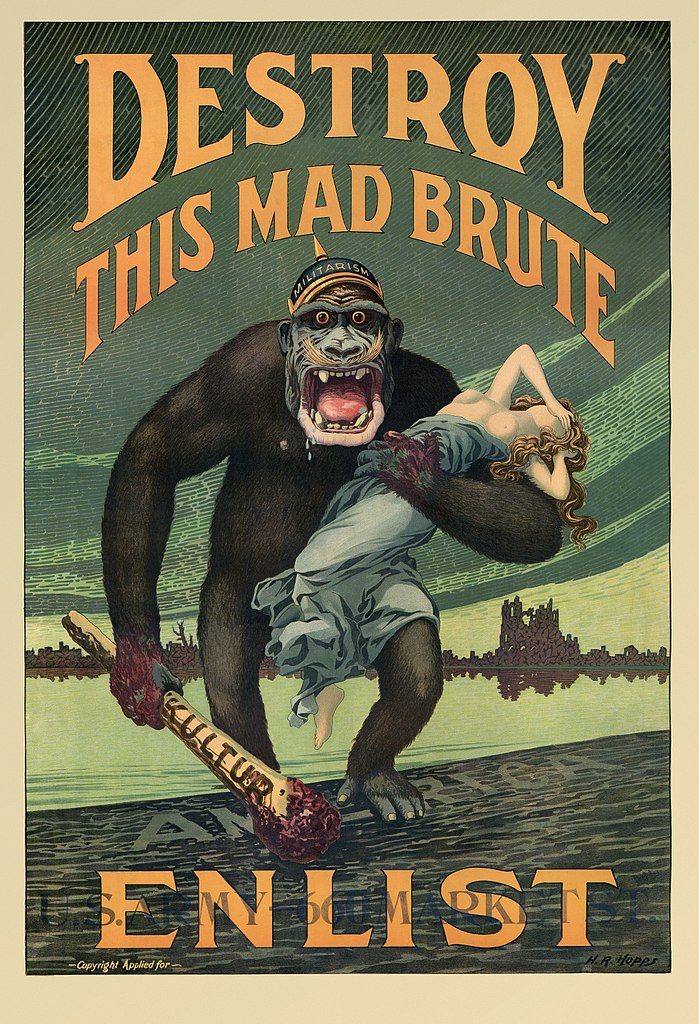
Whilst it may be true that propaganda has been strategically important in shaping opinions since King Darius, the nature of media – from cinematic newsreels created by 1910s national bureaus to today’s social media landscape – plays a crucial role in shaping how strategic messages are created and disseminated. Although we have shifted from the broadcast model of the 20th Century to a mode of prosumption, we are still dealing with the same questions: what effective power does language have? When does a message become propaganda? To what degree can individuals be defined as passive (or active) agents when they share officially approved information? Given these questions, it is no surprise that a number of contemporary artists working with the internet and digital cultures are responding to a perceived crisis of “truthiness” with strategies deriving from the 1910s activity of the Dadaists, a cultural elite who worked in Europe and the U.S. in war times.
Since the 1980s, early artists working with the internet claimed a connection between online art and Dada. It is now important to consider the reasons why, more than two decades later, new generations are still playing in the same field discovered by the Dadaists. The first Dada group was founded in 1915 in Zurich, one of the safest places in Europe, by artists and poets who could afford the journey and the stay. In such a city, anything could be said and written without caring too much about the actual consequences. Broadly speaking, this perceived freedom of expression is analogous to the promises of today’s social media, where everyone purportedly has the same right to share opinions and get involved in discussions as everyone else, without feeling obliged to be politically correct. A sense of detachment is among the features shared by the original Dadaists and contemporary artists with an interest in political questions. Often working in isolated environments, today’s artists use detachment as a strategy by distancing themselves from what’s happening behind the borders and commenting on the daily news, attending to how ‘facts’ have been narrated rather the ‘facts’ themselves.
Another important feature shared both by contemporary artists and the Dadaists is a focus on the ‘flatness’ of communication, which was adopted in strategies of advertising, propaganda and manifesti. This flatness arises since every sentence is an exclamation and the reader’s attention is diverted by unexpected changes and incessant slogans, making the message a discourse without hierarchies. This mechanism makes every part important and urgent, such that, no one part is actually necessary for the economy of the message.
A century ago, a political or artistic group couldn’t be defined as such if it didn’t publish at least a founding manifestoin a newspaper. To write a manifesto meant to impose a vision of the world, to claim the priority of some values in respect to other interpretations. Nowadays people rarely make manifesti, but a spectacular exception is Google’s list of guidelines for Material Design. These aim to spread the word about a “unified system that combines theory, resources, and tools for crafting digital experiences”, a mission recalling those stated by avant-garde and modernist groups to rebuild the world according to a unifying principle embracing all aspects of human beings. Artist Luca Leggero followed the guidelines provided by Google to make #MaterialArt (2017), colourful plastic art sculptures challenging the definitions of artwork and design pieces. Leggero critiques Google’s objective to reconstruct reality under its terms by putting into practice an accelerationist strategy; if everything must become part of the Google-branded world, why not art?
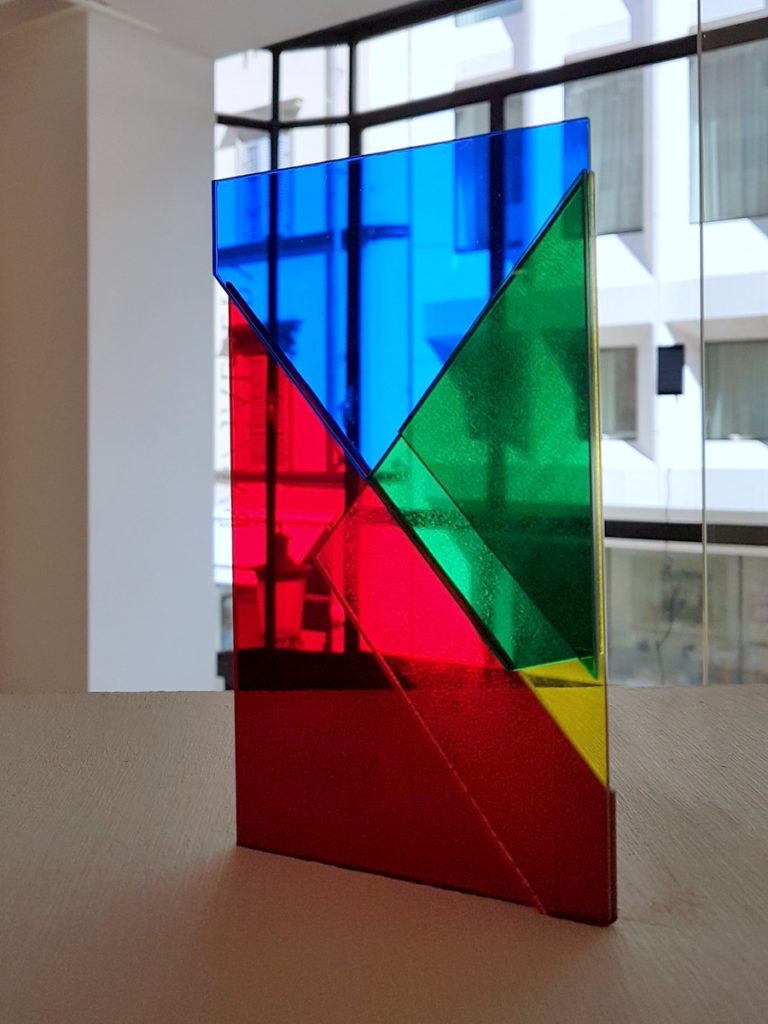
In the 1910s, groups published as many manifesti as possible in order to maintain interest among the public.4 To respond to their dogmatic and flat communication mode, however, Dadaists created countless statements that were not linked with each other whatsoever. For the Zurich group, the goal was to generate noise in the endless stream of commercial and political propaganda; it was a joyful activity that, with its randomness, confirmed the nonsense of all the other official communications. Today, the production of noise, and the disruption of corporate and political communication platforms is the aim of many artists’ practices, but only a few of them are so incisive as Ben Grosser’s. “ScareMail” (2013) is a web browser extension that originated in the midst of the 2013 NSA surveillance scandal. For every new email, it adds an algorithmically generated narrative comprising terms that would likely ring an alarm bell at the NSA.

Given the importance of ‘flat’ communicative hierarchies in Dada practice, it’s not surprising how many Dada artists studied the concepts of randomness and entropy as a way of making new realities. There is not just one reality, they seemed to claim, but too many to even imagine; there is not just one imposing point of view, but many – and these may not concur with each other. An exemplary case is a series of collages by Hans Arp arranged according to the Laws of Chance, which didn’t mean they were made without the exercise of any control, but that the artist arranged the pieces automatically, by will. An interest in automatism can be found in many contemporary artists using algorithms as artistic tools, such as Rafaël Rozendaal with Abstract Browsing (2014), a Chrome extension that turns any website into a colourful composition. HTML is a language and as such, it can be read by the browser in many ways, not only the one used by developers and designers. Rozendaal’s work shows the random potential innate in anything, while suggesting there are alternative ways to consume given contents.
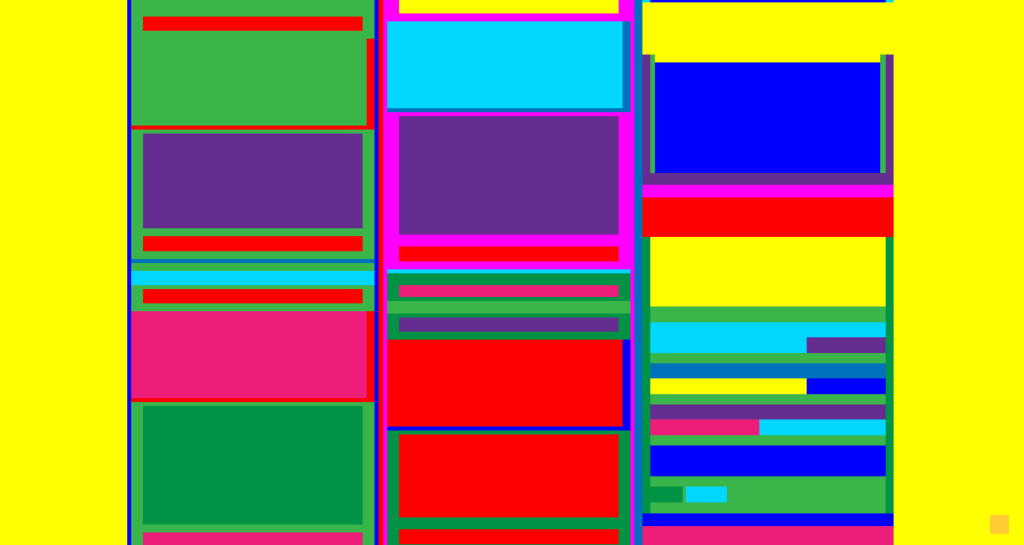
“Abstract Browsing” (2014), Rafaël Rozendaal
The production of noise seems to have been the most disruptive response to nationalist propaganda and corporate advertising produced by the original Dada groups. Most of these artists challenged the dogmatic, exclamatory tone used in the official language of war bulletins and newspaper adverts. Taking advantage of this tone and using it in chance-driven messages allowed them to reveal the absurdity of the dogmatic nature of propaganda and advertising.
Many contemporary artists are more or less consciously keeping alive these practices and producing their own kinds of noise in the face of fake news and alternative facts. Nowadays, not only do governments and advertising companies subtly practice dogmatic and exclamatory strategies, but it is even taken for granted they can and indeed do put into practice such disruptive ways to spread messages. When propaganda exploits guerilla strategies, and is generated in the same way art projects disrupt media environments, how should artists respond? This is one of the most challenging issues some artists want to address and the next few years will be a rich (and noisy) testing ground for many of them.
Compiler is an experimental platform organised by curator Alisa Blakeney, artist-curator Tanya Boyarkina, artist Oscar Cass-Darweish and choreographer Eleanor Chownsmith, all currently students of MA Digital Cultures, Goldsmiths. The platform is being built in order to “support collaborative, process-driven projects which connect artists and local communities in networks of knowledge-exchange”.
The organisers of Compiler describe it as a kind of ongoing prototype, a structure constantly negotiating the openness to maintain links to varied practices with the coherence of framing, containing, and describing some of the complicated products of digital-analogue interactions. Their focus is looking at what ‘digital culture’ means and having a productive conversation about it.
From 6-8 April, the first Compiler, Play Safe took place downstairs at OOTB in New Cross. The exhibition examined practices of surveillance inherent in “states, corporations, technological spaces and the idioms of digital art”. It questioned whether an increasing intensity of surveillance is linked to control, extraction and politics, or can be understood as a pleasurable phenomenon. People were invited to “Dance a website, see through the eyes of a computer, and have our cryptobartender mix you a cocktail to cure your NSA woes”. The work on show, made by students from MA Computational Arts and MA Digital Cultures (both Goldsmiths), included Eleanor Chownsmith’s software and performance which turned website HTML into dance routines, Michela Carmazzi’s photographic project documenting the reactions of Julian Assange and his supporters following the United Nations’ ruling about his case, and Saskia Freeke’s machine which repeatedly and intentionally failed to create a ticker-tape parade using sensors and fans.

An exhibition on the theme of surveillance creates a strange grey area for itself when shown in a building with nine screens of CCTV footage. Oscar Cass-Darweish’s project made a fairly direct link to the CCTV cameras which emphasised this greyness. The project produced a rendering of the exhibition space by using a function usually found in motion detection processes. This function calculates the difference in pixel colour values between frames at a set interval and averages them, creating a visual output of how machines calculate difference over time.
Another work which made links with the room upstairs was Fabio Natali’s Cryptobar, where following an interview with the ‘bartender’ about your data privacy needs you were recommended a cocktail of data-encryption software. Upstairs you could buy, and drink, a cocktail with the same name (the Cryptobar was part of the V&A Friday Late on Pocket Privacy on 28 April).
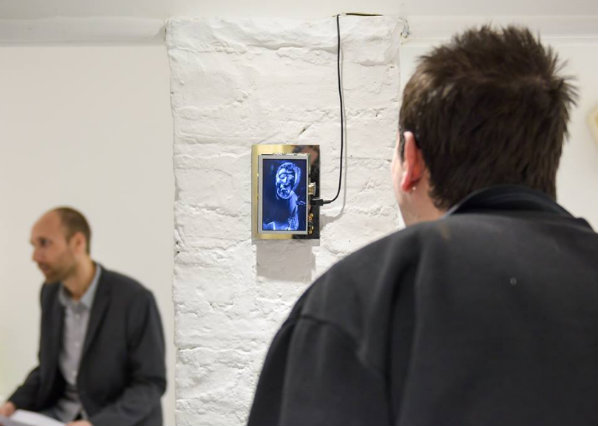
So far, Compiler has made a variety of spaces for conversation about digital culture through both its artworks and its organisation. Each artwork has a different ‘footprint’ of interactions, linking websites to rooms, success to failure, data privacy to financial transaction via consultation, and making interesting connections between CCTV and code, dance notation and HTML, activism and commerce.
An interesting way to read the Compiler platform is as a series of combinations of human-readable codes and machine-readable codes. The platform ‘compiles’ a different combination each time, and each time the output is different. Through this, the interaction of analogue and digital processes is demystified and muddled, in a distinct way. The platform is in its early days, but it seems likely that new connections and new grey areas will appear over the next few months, as Compiler has its second exhibition (again at OOTB) in May, takes part in the CCS conference at Goldsmiths in June and heads in other directions thereafter.
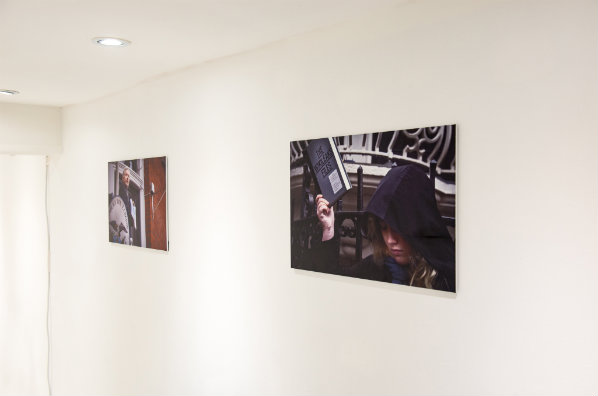
The exhibition offered plenty to play with, while posing complicated problems in relation to openness and experimentation. When I spoke to Eleanor, Tanya and Alisa about Compiler and its aim to engage local communities in networks of knowledge-exchange , we talked about how it’s an impossible and strange aspiration to have a ‘neutral’ venue. While a cocktail can be delicious and engaging, it’s also expensive. While a cafe is, arguably, a less exclusive space than a gallery, OOTB itself is a cafe which targets a specific audience. Drink prices, decor and a host of other factors mean OOTB, like all spaces, is politicised in a particular way. Their venue choices so far will influence, in subtle and overt ways, their future attempts to engage diverse local communities. The organisers of Compiler acknowledge this; their response is that rather than trying to make an artificial neutrality they are keen to move as the platform develops to new spaces and new and different contexts.
A change of context, message, communication style is not easy; nor does it fit with to an easily recognisable politics or aesthetics. Moving into and out of contexts is something to be done carefully and thoughtfully. It seems to me that the Compiler team will have their work cut out, but if they can direct that work in such a way that the platform is able to communicate in multiple ways at once, ‘networks of knowledge-exchange’ could develop between, and in response to, the markers set by the organisers. The question is, how will they develop?
When Charlotte Webb asked me to write a piece about the future of work for Furtherfield, I immediately thought about Utopoly. Even though this game doesn’t directly discuss how we will be employed or occupied in the future, it creates a rare space where people can re-imagine a different society in which values, forms of exchange and social relations are reconsidered and reconfigured.
To better understand the ethos behind Utopoly, I interviewed Neil Farnan, who is currently undertaking a PhD at University of the Arts London with the research title ‘Art, Utopia and Economics’. He became an Utopoly advocate, introducing many ideas and concepts featured in its current iteration. Neil’s interest in designing a utopian version of Monopoly was initially shaped by his previous studies in User Interface Design, where he developed an interest in Scandinavian design practice and Future Workshops.
Francesca Baglietto: What is Utopoly? More specifically, how does it relate to and differ from Elizabeth Magie’s original version of Monopoly?
Neil Farnan: Utopoly is both a tool for utopian practice and a fun game. It draws on Robert Jungk’s Future Workshop methodology to re-engage people’s imagination and ideas for a better society and incorporates the results into a ‘hack’ of Monopoly.
Elizabeth Magie’s original game (1904) was intended to show how landlords accumulate wealth and impoverish society. Players could choose either a winner takes all scenario or one where wealth was distributed evenly via a land tax. Magie also hoped that children’s sense of fairness meant they would choose the latter and apply these ideas in adulthood. But the Monopoly we have today normalises and celebrates competitive land grabbing and rentier behaviour and Magie was airbrushed out of history and replaced with a more acceptable mythology of the American Dream.
Whilst Magie’s game informed players about the current situation, Utopoly gives people the opportunity to imagine and incorporate values and attributes they would want in a more utopian world. Players are able to determine the properties, the chance and community cards and even rules of the game. The rules being determined by the players means the game is a work-in-progress, however some features that work well can get adopted and carried through to the next iteration.
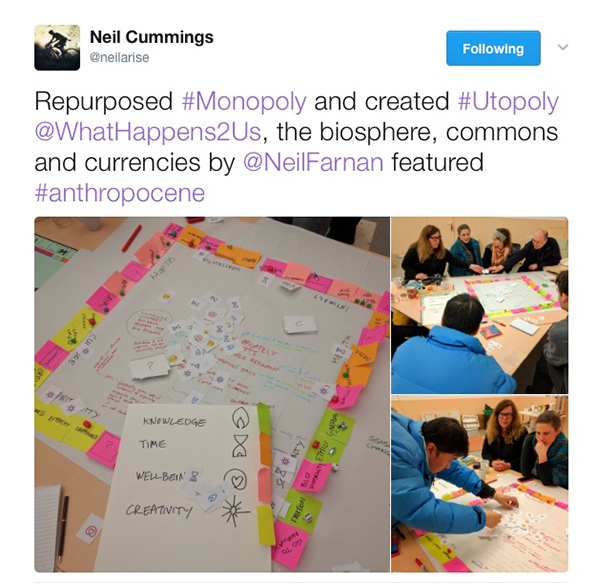
FB: As you just said, Utopoly doesn’t have a definitive form and rules but changes with each interaction. So, while the future of Utopoly is still in progress, what I would like to know is who started the project and how has this evolved so far?
NF: Critical Practice, a research cluster at Chelsea College of Arts, played a central role. We were concurrently developing both Utopoly and an event #TransActing – A Market of Values, and the current version of Utopoly is a synergy of aspects of these two projects. The first ‘hack’ of Monopoly occurred at Utopographies, co-organised by Critical Practice (28th – 29th March 2014), where the elements of the game were redesigned to incorporate utopian values. Inspired, we decided to continue developing the ideas and a second ‘hack’ took place (December 2014). Some of the ideas and values that emerged from this iteration fed into and were represented in the design of the currencies used for #TransActing. A further opportunity presented itself for another ‘hack’ within the research event ‘What Happens to Us’ at Wimbledon College of Art. This iteration was hosted by Neil Cummings and I was invited to include the currencies developed for #TransActing. It was here that Utopoly as a ‘method’ began to emerge, a method for collectively producing possible futures. I have since convened a number of iterations using a large laminated board to facilitate design adaptations and ease of play.
Additionally, researchers from the international ValueModels project (modelling evaluative communities utilising blockchain technology) recently visited Chelsea – we played Utopoly and they loved the method. They have since been inspired to use Utopoly in their research, and I’m excited to receive their feedback on how their version develops.
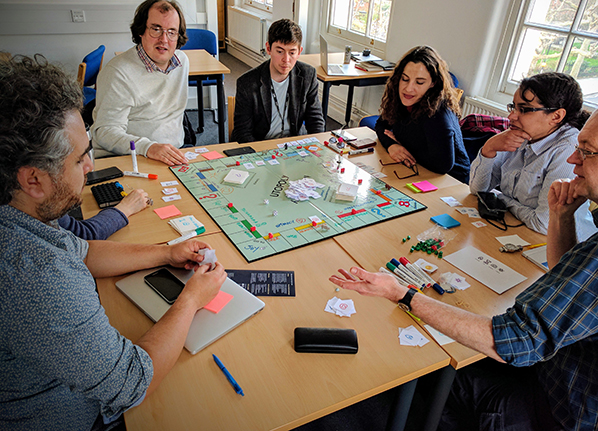
FB: Utopoly is experimenting with possible new monetary ecosystems in which multiple currencies and values might be exchanged. How might these currencies work and what are they inspired by?
NF: The currencies developed for #TransActing generated the concept of an ecosystem of value exchange and these are used in Utopoly. I have since come across the work of economist Bernard Lietaer, who highlights the problems of mono-currency economies and advocates for a monetary ecosystem using multiple currencies. With their origins in subjugation and taxation, mono-currencies are tools for value extraction. They also contribute to cycles of boom and bust, resulting in the withdrawal of money from the economy and the prevention of economic activity. Historical evidence suggests that economies operating multiple currencies are more resilient – they work in a counter cyclical manner compensating for this withdrawal and allow the economy to keep working.
The irony of Monopoly is that the winner is ultimately left in control of a non-functioning economy. A more preferable state would be to have a healthy flow of values in balance where people are able to exchange their contributions in a mutually beneficial way. A feature of Utopoly is that players no longer seek to own all the property but work together for the common good. The currencies are used to bring privately held properties back into the commons. The economist Elinor Ostrom won the Nobel prize for debunking the myth of the “tragedy of the commons” (Ostrom, 2015) demonstrating the benefits and effective use of common resources. Utopoly also allows economies of gifting and sharing.
I am currently working on ways of modelling innovations such as the blockchain and associated digital currencies.
FB: How would you interpret “work” in this utopian economy? For example, do you think the relation between paid work and unpaid work and/or people’s dependence on employment might be shaped in an ecosystem in which assets/values are brought into the commons to generate value/wealth for all?
Whilst not directly about work, Utopoly reflects the future nature of wealth and values in a Utopian economy. It touches on the current abstract separation of paid work from non-paid work and people’s employment dependency.
In Magie’s original game the players collect wages as they pass ‘Go’. They then buy properties and accumulate wealth extracted from other players. On one corner of Magie’s game is the Georgist statement “Labor Upon Mother Earth Produces Wages”, reminding us that land ownership should not provide unearned income.
As an economy develops people become less self-sufficient and more dependent on employment to meet their needs and a mono-currency makes the separation of paid and unpaid work even starker. The social contract that existed from 1950-70s where employers had a responsibility to their employees is disappearing. Outsourcing, short term and zero-hours contracts make the future of paid work increasingly precarious, and we also face further threats from automation and artificial intelligence.
Economist Mariana Mazzucato (2011) documents the substantial contribution of public investment to the success of today’s businesses. These businesses stand not so much ‘on the shoulders of giants’ but on the shoulders of a multitude of diverse contributions from society at large. A new social contract is needed to take this into account.
Fintech companies make much of the term ‘disintermediation’, but we also need a new form of ‘intermediation’ where contributions are reconnected and recognised. An ecosystem of currencies which register currently unpaid valuable activities together with a basic income could meet this need. This approach is suggested in Utopoly where people collaborate to contribute values and are valued for their contributions. The properties are brought into the commons to generate value and wealth for all.
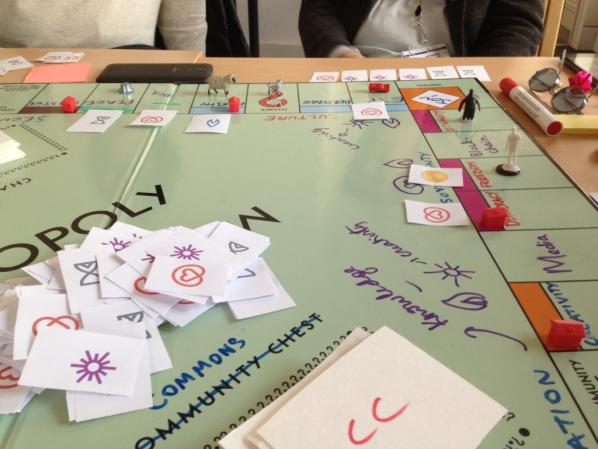
FB: Playing seems to provide a very rare space in which, by operating in an interstice between reality and fantasy (what the psychoanalyst Winnicott called a transitional space), it is still possible for the players to imagine alternatives to our current economic system. Would you agree that the main political purpose of Utopoly is to provide such a space in order to reopen the capacity to be imaginative about economic and societal organisations?
NF: This is the utopian aspect of Utopoly, using people’s imagination as a means of prefiguring the future. We endure in a society where the mainstream orthodoxy would like us to accept that ‘there is no alternative’. One of the last great taboos is money and the associated economic system. If you consider our mono-currency as a societal tool imposed from the top down, it shapes and informs how we behave and the values we are expected to live by. In a way, it is like DNA; if we can change the DNA of our economy we could create new exchanges, values and social relations. We have become so used to this abstract construct that it is the water we swim in and the box we need to think out of. In order for people to start thinking that another world is possible we need to open up a space for imagination to play out. Art, games and play are some of the few remaining arenas available to engage in speculation about the future. Utopoly fulfils many research functions including acting as a tool for inquiry and reflexion, and a means of modelling future possibilities. It is rare for people to have the opportunity to criticise the existing state of society and work out how to reshape it. By allowing people the space to consider different approaches we can start to encourage better societal norms of exchange and interaction and construct new social contracts.
Economic theory states that technological change comes in waves: one innovation rapidly triggers another, launching the disruptions from which new industries, workplaces and jobs are born. Steam power set in motion the industrial revolution, and likewise since the 1990s a torrent of digital and software developments have transformed industries and our working lives. But the revolutionary very quickly becomes humdrum, and once-radical and efficient innovations like the telephone, email, smartphones and Skype, become part of everyday, even mundane experience. Despite all the time-saving devices we have successfully integrated into our lives, there is a collective anxiety about the current wave of technological change and what more the future holds. Mainstream dystopian visions of our relationship with technology abound, but are we in fact engaged in a group act of cognitive dissonance: using our smartphones to read and worry about robots taking over our jobs, whilst wishing for a shorter work week and more time for creative pursuits?
The British Academy recently brought together a panel of experts in robotics, economics, retail and sociology to talk about how technology is reshaping our working lives. This review summarises some of their thoughts on the situation now, and what developments lie ahead. Watch the full debate here.
Helen Dickinson OBE reported on the British Retail Consortium’s project, Retail 2020, a practical example of how technology is changing consumer behavior and affecting firms in her industry. The UK’s retail sector has on the one hand embraced technology and created a success story. The UK has the highest ecommerce spend per head in the developed world, with c15% of transactions taking place online, and at 3.0m employees it is also the largest private sector employer in the UK. However, beneath this, internet price comparison ushered in fierce price competition. Retailers are using technology to improve manufacturing and logistic efficiencies to control costs and offset shrinking profit margins. Physical stores are closing as sales migrate online. The BRC predicts a net 900,000 jobs will be lost by 2025. Nor will the expected impact be even: deprived regions are more reliant on retail employers and so will be more affected by job losses. Likewise, the most vulnerable, with less education or skills and looking for work in their local area, will be the hardest hit.
Prof Judy Wajcman resisted the urge to overly rejoice or despair at technological developments. For her, this revolution is not so different to the waves which have come before. It is impossible to predict what new needs, wants, skills and jobs will be created by technological advances. Undoubtedly some jobs will be eliminated, others changed, and some created. However, we can certainly think beyond the immediate like-for-like: a washing machine saves labour, but it has also changed our cultural sense of what it means to be clean. Critically, we should stop thinking of technology as any kind of neutral, inevitable, unstoppable force. All technology is manmade and political, reflecting the values, biases and cultures of those creating it. As Wajcman said, ‘if we can put a man on the moon, why are women still doing so much washing?’ In other words, female subjugation to domestic labour could have been eliminated by technology, but persistent cultural norms have prevented this from happening.


Dr Sabine Hauert is a self-professed technological optimist. For her technology has the potential to make us safer and empower us, for example by reducing road accidents, or allowing those who cannot currently drive to do so. Hauert sees a future not where robots completely replace humans, but where collaborative robots work alongside them to help with specific tasks. The crucial issue for dealing with this future lies in communication and education about new technologies, since the general public, mainly informed by news and cultural media, is ill-served by a steady drip of negative stories about our future with robots.
The short film Humans Need not Apply is one such alarming production, chiming with Dr Daniel Susskind’s altogether more gloomy view of the longer term effects of technological advances on the workforce. To date, manufacturing jobs have been those most affected by automation, but traditionally white collar jobs also contain many repetitive tasks and activities (just ask the employee drumming their fingers on the photocopier). Computing advances mean that many more of these are now in scope for automation, such as the Japanese insurer replacing some underwriters with artificial intelligence. For Susskind, it is not certain that workers will continue to benefit from increased efficiencies as technology advances. A human uses a satnav provided s/he is still needed to drive, but the same satnav could just as easily interface with a self-driving car, eliminating the need for any kind of human-machine interaction. Calling to mind the wholesale changes to UK heavy industry in the 1980s, any redeployment of labour will present huge challenges, and what work eventually remains may not be enough to keep large populations in well paid, stable employment.

Can humans benefit from robots in the workplace?The panel agreed that technological change will continue apace with wide reaching ramifications for our workplaces and our wider societies, but that it is our human qualities that will give us an advantage over machines. Perhaps this is the most pressing notion: we urgently need to recalculate the value we place on tasks within society. Work where social skills, communciation, empathy, and personal interaction are prioritised (like teaching or nursing) may develop a value above that which is rewarded today.
If we smell such change coming, it is no wonder we are anxious. The panellists differed on the ability of our society to absorb and adapt to coming technological change, and the distribution of any net benefit or loss. So, is the only option to accept the inevitable and brace for the tsunami to hit? Well, no. We need to realise that ‘technology’ is not one vast, distant wave on the horizon, but a series of smaller ripples already lapping higher around our ankles. Returning to Wajcman’s point, all technologies are created by people. If innovation has a cultural dimension, it can be influenced, so we must take heart and believe in our ability to effect change.
The further we can work to democratise and widen the pool of creative engineers, developers, artists, designers and critical thinkers contributing to the development of technologies, the broader the spectrum of resulting applications and consequent benefits to society as a whole. We can be conscious in our choices as consumers as we adopt new products and services into our lives, and challenge the new social norms emerging around work and life as technology allows us to blur the boundaries between them. And finally, we need to consider who profits, and who doesn’t, from new business models. We should lobby government to be deliberate in designing policy that looks to these future developments, and their likely unequal impacts across regions, industries and populations, to ensure that existing social inequalities are not entrenched or magnified. Hopefully the creative community can help steer this wave in the right direction, painting a vivid picture of our possible futures, to persuade the powerful to act in the interests of the greater good.
Helen Dickinson OBE, Chief Executive, British Retail Consortium
Dr Sabine Hauert, Lecturer in Robotics, University of Bristol
Dr Daniel Susskind, Fellow in Economics, University of Oxford and co-author of The future of the professions: How technology will transform the work of human experts (OUP, 2015)
Professor Judy Wajcman FBA, Anthony Giddens Professor of Sociology, LSE and author Pressed for time: The acceleration of life in digital capitalism (Chicago, 2015)
Timandra Harkness, Journalist and author, Big Data: Does size matter? (Bloomsbury Sigma, 2016)
Katharine Dwyer is an artist who considers the modern corporate workplace in her practice.
Do you believe everything you said today? How can you trust what you feel? What is it about today’s truth that makes it so difficult to believe?
The journalistic affectation for pre-fixing all manner of phenomena with the term ‘post-’ has become commonplace over the last few decades. Post-capitalism, post-growth, post-normal, post-internet, post-work and post-truth are all concepts crystalizing around a pervasive sense of uncertainty, instability and social unrest. While I have the honour of guest editing the Furtherfield website for the next few months, I am hoping to bring together a number of writers, artists and thinkers who will, in various ways, explore two of the ‘post-s’ I find most urgent and compelling: post-truth and post-work.
Consolidated by Brexit and the US presidential campaign, and designated as word of the year 2016 by the Oxford Dictionary, ‘post-truth’ is now a term deeply engrained in the social and political imaginary. Since ‘post’ can signify the internalization of phenomena (the internet is inside us all), one might even say we are post-post-truth, living with it as a general condition of our reality. The post-truth condition privileges narrative over facts, appealing to people’s beliefs, ideologies, prejudices and assumptions, rather than presenting them with ‘evidence’. This is, of course, nothing new – facts have never been anything without subjective processes of interpretation, contextualization, manipulation and propaganda. As Simon Jenkins points out, ‘Of all golden-age fallacies, none is dafter than that there was a time when politicians purveyed unvarnished truth’ – lies are, he suggests, the ‘raw material’ of political narrative.
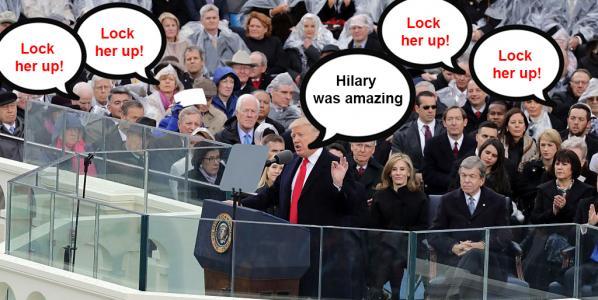
Social media holds the potential to both exacerbate and alleviate the chaos of post-truth reality. On the one hand the echo-chambers created by partisan social media feeds limit and blinker us; on the other, social media is a weapon being deployed by armies of citizen journalists and organizations committed to fact-checking and exposing political lies and obfuscation. To feel uncomfortable about the confusion and psychological strain arising from the post-truth condition is surely a reasonable human response. As Professor Dan Kahan suggests:
‘we should be anxious that in a certain kind of environment, where facts become invested with significance that turns them almost into badges of membership in and loyalty to groups, that we’re not going to be making sense of the information in a way that we can trust. We’re going to be unconsciously fitting what we see to the stake we have in maintaining our standing in the group, and I don’t think that’s what anyone wants to do with their reason’
What Kahan points to here is, I think, an opportunity to reflect carefully on the stake we have in maintaining our sense of identity and belonging through the ‘facts’ we choose to believe. Despite the discomfort we may feel, might there be a way to take advantage of this cultural moment? Perhaps recognizing our own doubts about credibility can become a fruitful catalyst for adjusting our sense of responsibility to engage with a range of news sources, listen to opposing points of view, and critically evaluate the information we are presented with. In fact, Kahan prescribes 10 minutes of doubt every morning to deal with the anxiety that arises from a feeling that you can’t trust your own feelings.
Can we have a good life without work, or is work part of what it means to live a decent life? What would you do if you didn’t have to work?
One of the most significant societal shifts taking place due to the advancement of technology is the transformation of what it means to work, and to be a worker. The nine to five is dead (or soon will be), and work is being radically transformed as a new global workforce comes online, technological innovations advance at super high speed, and new business models emerge. Automation is now a firm feature of mainstream discourse, and depictions of robots replacing jobs are everywhere in the global media imaginary.
The Bank of England’s chief economist recently projected that 15 million UK jobs will be lost to automation in the next 2 decades, which is equivalent to approximately 80 million US jobs. 47% of white collar jobs are predicted to be lost to automation by 2035, according to a 2016 report by Citi GPS and the Oxford Martin School at the University of Oxford. It is not just routine tasks that will be replaced – asset management, analytics, patient care, law, construction and financial trading can all be done (and is being done) by robots. Mining giant Rio Tinto already uses 45 240-ton driverless trucks to move iron ore in two Australian mines, saying it is cheaper and safer than using human drivers.
At the same time as these developments are evolving at break neck speed, we are living in an increasingly unequal world, where the gap between the rich and poor is getting bigger. According to a recent Oxfam report, 62 identifiable individuals own same wealth as poorest 50% of the world’s population – that’s 3.6 billion people. And 1% of the world’s population own more than the rest of us combined. Capital grows faster than labour, so if you’re already rich, your money earns more than your labour ever could, which reinforces existing wealth inequality. Furthermore, extreme inequality involves people thinking greedily about finite resources, and not seeing personal greed as having wider consequences. If people see that the 1% own more than the rest, there’s danger their response is to play same game and look to join that 1% (or 5%/10%)
Not everyone is equally equipped to deal with the changes ahead, but since artists, designers and critical thinkers are amongst the best-resourced to do so, I see it as our responsibility to consider how we can help others deal with what lies ahead. As with confronting post-truth reality, acknowledging a post-work future can be seen as an opportunity to forge a better path forward for ourselves and others. We might take a cue from what we know about post-truth, and try to create narratives (backed up by collectively verified facts) that persuade the world to proceed towards an equitable world of work where solidarity and cooperation can thrive.
The articles gathered over the next two months as part of my guest editorship of Furtherfield might be understood as moments of corrective doubt. They are an opportunity to speculate about issues of truth and labour, and to proceed as artists should – by imagining alternative realities and evolving conceptual, aesthetic and practical ways to inhabit them. You can expect revelations about the labour conditions of those who work for contemporary artists from Ronald Flanagan, reflections on robots in the workplace from Katharine Dwyer, and an interview about the repopulation of Monopoly with cryptocurrencies from Francesca Baglietto. Filippo Lorenzin will consider Dada as a response to the post-truth condition, Carleigh Morgan will consider what makes good curatorial practice in this contemporary moment, reorienting current discussions away from free speech absolutism vs censorship to questions of judgement and responsibility. Alex McLean will use the metaphor of weaving to consider the role of craft in a post-work society. How might coding be understood as a form of textile liberated from its militaristic origins?
Happy doubting to all.
‘Seeds From Elsewhere’ (2016 – ongoing) is a project by They Are Here that has begun to re-animate a dilapidated play area in Finsbury Park, bringing together young asylum seekers and refugees, family, friends and other professionals. Each participant is supported to grow flowers, plants or edible produce from their respective homeland. We are also in the process of designing a greenhouse and pizza clay oven, extending the parameters of our collective activity. Throughout the process we literally and metaphorically ask ‘What can grow here that’s not from here?’ Beyond this more tangible gardening activity, the project seeks to create a space that embraces, maintains and produces a diverse set of social relationships between people with different residency status. It is supported by Furthefield an organisation exploring the intersection of networked culture and contemporary art.
It was July 2016, less than a month after the results of the United Kingdom European Union membership referendum, when our project commenced. Although the impetus to begin was not a conscious response to the referendum outcome – the timing is not insignificant. Our initial steps were in a toxic political atmosphere at the height of an intensified and indiscriminate rhetoric against migrants.
Artists were faced with new variations of old questions that resurface in turbulent times. . . What is our role in protest? Do we have a particular responsibility as artworkers to engage with a given political landscape? What are the capabilities and limitations of art in local / national / international governmental politics? Such questions often reveal an expectation of certain aesthetics, rather than attitudes. It is in the multiple ways that a work is circulated and produced its politics should be sought. . . How is the work funded? How is it credited? Which voices are included in its development, or excluded? How is the work talked and written about by the various partners supporting its production?
In these seemingly small details, a larger political statement is embodied rather than solely visually evoked. At the same time, we reject a ‘one-or-the-other’ stance. Establishing and administering a small community garden should not negate working with others on larger-scale efforts at the scale of local government or beyond. Bridges should be made between all scales of activity. The same fluid hierarchies and embrace of hybridity we cultivate with Seeds From Elsewhere, we encourage at ever larger scales – generating continuities between the ethos of how we are working on the garden and how national and global resources are considered and decisions made.
‘Participation is not always progressive or empowering’, ‘Realise your own privilege’, ‘Critically interrogate your intention’, ‘Process not product’, ‘Presentation vs representation – Know the difference!’, ‘Do not expect us to be grateful’, ‘Art is not neutral’, ‘It is not a safe-space just because you say it is,’ ‘Do your research’, ‘ Do not reduce us to an issue’. These notes are from Rise (Refugees, Survivors and Ex-detainees – the first refugee and asylum seeker organisation in Australia to be run and governed by refugees, asylum seekers and ex-detainees) . . . 10 Things You Need to Consider If You are an artist not of the Refugee and Asylum Seeker Community Looking to work with our Community authored by Tania Canas, RISE Arts Director.
In a polarised mediascape, where tabloid headlines shout loudest, the reduction of a diverse group of people to an ‘issue’, has been one of the most problematic aspects of public debate. Recognising that Seeds From Elsewhere is a slowly gestating project affords time for us to slowly get to know the participants individually – who to date hail from Albania, Sudan, Congo, Ethiopia, Romania, Afghanistan & Nepal. Rather than seek to ‘represent them’, we are co-workers on a set of shared goals.
Importantly, this work functions as a hybrid activity, with multiple points of access and identification. For the young refugees the garden can offer a respite from various kinds of bureaucratic limbo, it can also simply be a place to chill in a tolerant environment. In the longer term, there maybe be the potential for employment opportunities in the garden. At the same time, the work functions within the tradition of many conceptually driven socially-engaged artworks, notably Wheatfield – A Confrontation (1982) by Agnes Denes, Edible Estates (2005 – ongoing) by Fritz Haeg and Parkwerk (2014) by Jeanne van Heeswijk.
The project has also become a gateway to consider the language of rhetoric against migrants, as well as that of sympathetic media too, focusing on the recurrence of botanical language as metaphor (soil, roots etc). Essays by US-based anthropologists Dr. Lisa Malkki and Dr. Stefan Helmreich have been particularly insightful. The latter quotes biologist Banu Subramniam, noting that these criteria ‘resonate unfortunately with xenophobic anti-immigration language in the United States and Europe’:
“The parallels in the rhetoric surrounding foreign plants and those of foreign peoples are striking … The first parallel is that aliens are ‘other’ … Second is the idea that aliens / exotic plants are everywhere, taking over everything … The third parallel is the suggestion that they are growing in strength and number … The fourth parallel is that aliens are difficult to destroy and will persist because they can withstand extreme situations … The fifth parallel is that aliens are ‘aggressive predators and pests and are prolific in nature, reproducing rapidly’ … Finally, like human immigrants, the greatest focus is on their economic costs because it is believed that they consume resources and return nothing.” [1]
Becoming attuned to language is a vital part of a larger and never-ending exercise in developing cultural and individual self-awareness as to how we speak, itself inseparable from how we think.
Our fortnightly group meetings in the garden are rich in debate and banter. Working on a garden is an unceasing process. Like the growth of plants themselves, it cannot be rushed without compromise. This notion of maintenance is akin to a healthy democracy. Rather than an invitation to vote every four years, democracy must be attended to daily; it is comprised of multiple systems collectively supporting each other. Beyond physical access to a voting booth, there is the need for both protection and scrutiny of the media, investment into an education system that encourages voters to make informed choices, the space for satirists, philosophers and artists to critique power and the continual checking of our own presumptions and privileges.
Harun Morrison + Helen Walker
They Are Here
February 2017
contact@theyarehere.net
What is serendipity? Notoriously difficult to translate1, it is described as a trivial encounter, a pleasing coincidence, or a moment or encounter that was unplanned and occurred without intentionally looking for it. For Olma there appears to be much more at stake than a charming French accident. In the book ‘In Defence of Serendipity: For a Radical Politics of Innovation’ (2016), Olma gallops through the oppressive apparatus of the creative industries and the tireless illusion of innovation that captivates the hearts of young creatives and designers all over Europe, before finally resting on a call to arms for a radical politics of innovation that encompasses creativity, citizenship and social emancipation.
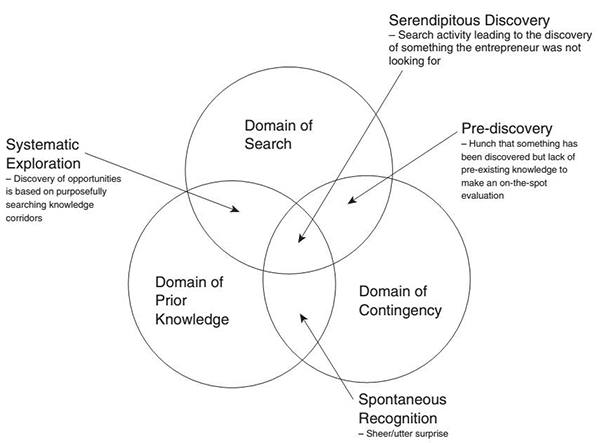
The notion of serendipity – with its playful innocent charm that promises the unexpected or unplanned potential from the incidental – represents much more than the romantic possibility of chance. As part of his research for the book Olma co-organised a conference on creativity with the Institute of Network Cultures in 20142, where social scientist Pek van Andel 3 provided an anecdotal sentence, which for Olma describes what is at stake in defending serendipity –
“The new and unknown cannot be extrapolated logically from the old and the known” (Andel, 2014).
There are many assumptions surrounding creativity and the production of knowledge, and this possibility to discover the new or the unknown with methods outside of the structures or logic enforced by institutional programs is quite a cunning place to situate a critique on cultural production. After all what is more valuable in contemporary culture than producing the new & the unknown?
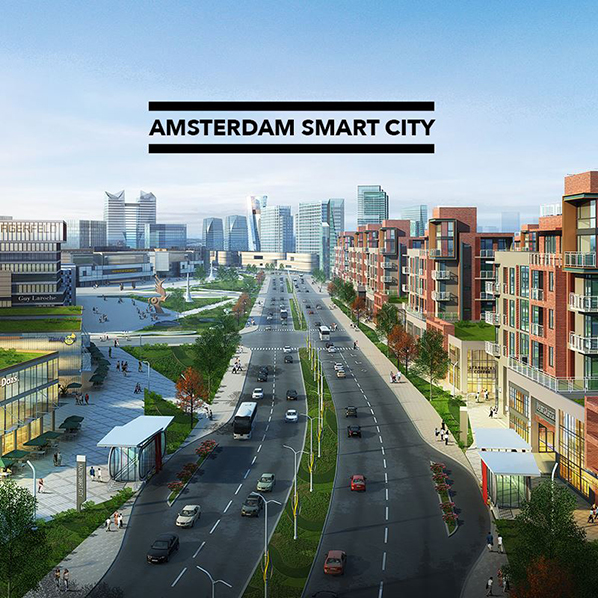
For Olma, the aims of culture programs for creatives and designers to create, build and imagine the ‘new’ are misguided, and form part of the many ‘false sleeves of innovation’ in which he seeks to re-instate a political vision for innovation. (Un)fortunately for Olma, he is sat right in the epicentre of this ‘slack innovation culture’, based in a small studio in East Amsterdam where the majority of the artist-run spaces have quickly become boutique hotels, co-work spaces and commercial creative labs. Amsterdam is perhaps only matched by Berlin in its ability to brand a certain lifestyle – a concoction of social innovation and tech entrepreneurism – connected through flexible work spaces, fab labs and start-up hubs that all contributed to the city becoming the official European city of Innovation in 20164.As an artist who moved to the Netherlands to participate in the wide variety of workshops, conferences and collaborative enterprises offered by the wide range of labs, media organisations and institutions in Amsterdam I found Olma’s critique on the lack of political agenda from Dutch cultural organisations thoroughly devastating. For Olma, much of this type of creative activism is an empty political gesture, a speculation and an ideological indulgence for a lost millennial generation attempting to engineer a game-changing prototype or white paper that could make the world a better place (if it ever became anything more than a 5 minute Prezi). To borrow the term coined by Evgeny Morozov, the creative sector has long been adapting the approach of ‘Technological Solutionism’ – programming or designing a technical solution to a social problem – and this is ultimately leading to what Olma describes as ‘Changeless change’. Olma sees this as a dominant, restrictive logic that has pervaded not just the creative economy but other sectors of education, healthcare and state services for years. He insists that defending the possibility of spontaneity, chance and coincidence in the face of regulated, market-driven creative programs is the way to make innovation innovative again.
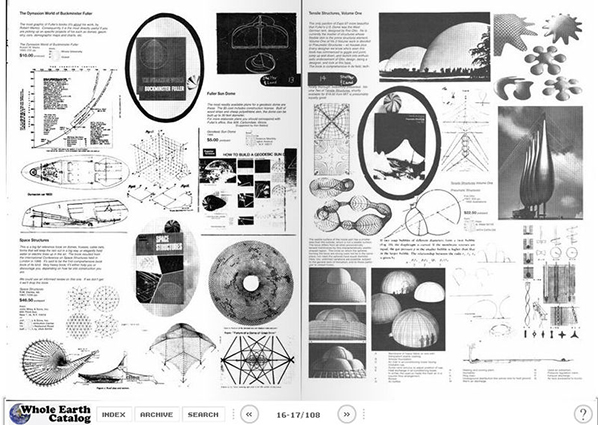
“The paradox is that while relying on informal and idiosyncratic forms of interpersonal exchange, cybernetics spawned a techno-social ontology, reducing human beings to increasingly calculable, controllable and predictable factors within systems” (pg 160, 2016)
Olma occasionally describes conditions in the past century where serendipity was openly facilitated and creative innovation demonstrated radical political values. Universities – such as the well cited Black Mountain college (whose students included John Cage & Buckminster Fuller) – and co-working spaces originally provided much potential for chance encounters at little or no cost, and even the invention of cybernetics involved a degree of spontaneity. The hippy counter-culture movement and the communalists of the late 1960s were making a radical attempt to form an alternative social transformation and organise flexible communes and temporary networks. If you go back to this starting point it is easier to grasp how the premise of Silicon Valley originated from a radical politics of innovation. Buckminster Fuller, Stuart Brand and even Steve Jobs were designing and building alternative visions of the world which are now perpetually carried in the pockets of over 160 million people. These were creatives, designers, hackers and hippies who built their own vision of reality and successfully sold it to the western world. It is little wonder then that even after half a century creatives still believe in the emancipatory potential for technological design to engineer large-scale social change. This attitude resides in young creatives like a hangover, with many believing the most important part of any project is the ability to harness the power of the network and ‘scale up’ or utilize the latest technologies (e.g. IoT blockchain, A.I) in order to ‘build a better world’.
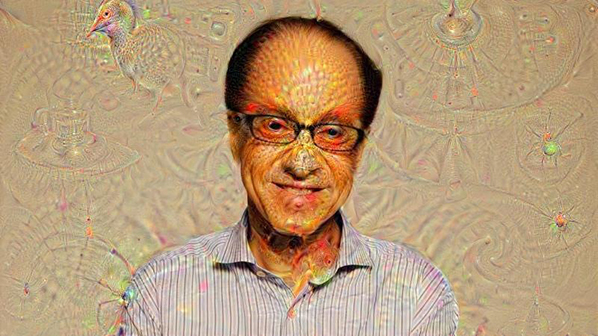
The global dominance that Silicon Valley has managed to groom over the creative economy has left very little room for creatives, designers and technologists to imagine future(s) other than the ones packaged and sold by the CEOs of the four major tech companies (GAFA5). Olma dives into the disillusion perpetuated by figures like Ray Kurzweil and Elon Musk and offers some insight into how the idea of the singularity is proliferated as an artificial salvation from a crisis that – arguably – they are responsible for. What is so powerful about these myths is the way they are presented as an inevitability, a natural outcome of what is known as ‘Moore’s law’ (the theory that computing power grows exponentially). Aside from the fact that, as Olma highlights, this theory (it’s not a law) is beginning to look more and more unlikely due to increasing demand and finite resources, 6 the mythical fantasy is also a fantastic narrative that – regardless of plausibility – enchants the masses, enticing them towards the promise of a techno-spiritual enlightenment. The singularity, similar to The Enlightenment, is an alternative way to defy the gods and transcend both space and time (whether that is flying to Mars with Elon Musk or staying alive forever by eating nothing but berries with Ray Kurzweil 7). It also reintroduces the notion of a collective consciousness and mobilises the technologists, hackers and creative programmers towards a transcendent , spiritual (post-human) awakening. What distresses me is how often artists and designers (including myself!) are encouraged either through directed funding programs or just through their own curiosity to unwittingly contribute free or intellectual labour to improve, train and develop the latest technology. This is very familiar in the development and production of Artificial intelligence. When Google releases the source code for A.I products such as DeepMind’s neural network 8, they are doing so predominantly to crowd-source the development of the software and improve the ‘machine learning’ process of the application. This way, the countless enthusiasts creating their own ‘neural nets’ or simply sharing more ‘slug dog puppies’ 9 incidentally form an army of free researchers, crowd-sourcing the big data and enabling companies to train and deploy more powerful machine learning systems. The sweeping tide towards Artificial Intelligence and eventual leap towards the singularity – whilst being very good for sensationalising and selling further tech products – lures over the collective creative imagination of many artists and creative technologists and consequently makes it increasingly challenging to design an mobilise an alternative vision that does not just further the one sided Singularity story. In the final chapters of the book, Olma quotes Julian Assange who famously said “there are only two types of belief systems that are capable of transforming change on a global scale, that of silicon valley libertarianism and that of radical Islam”(pg 211, 2016). The way in which Olma maps out how Californian hippy counter-culture advanced into techno-libertarianism to the prospect of a technological enlightenment, highlights how ‘a belief system [can] turn populations into docile followers of the dominant logic of power’ (pg 119, 2016) The conclusive effect of Olma’s analysis is that there is a generation of young people who assume that transformative social change can be engineered through programming, code and technical design, and not through politics. Furthermore, the promise of a collective consciousness in the form of the singularity propagates the belief that this particular strain of Randian individualism will eventually give way to something egalitarian, collective and enlightening.
“Today, a radical politics of innovation must be directed toward the recapture of the state by an ideology that is a polemic for the reinvention of a public sphere whose accidental sagacity will generate potential futures we don’t even dare dream about” (pg 217, 2016)

While admitting that the odds of reclaiming a practice of innovation that is genuinely alternative, transformative and political are slim, Olma offers us some potential new directions to consider. After relentlessly exposing the libertarian attitude that has permeated through technological innovation into creative culture, Olma considers how to collectively care for the imaginary ‘we’. Rather than champion a Luddite perspective in relation to digital technology, Olma asks us to re-consider the effect tech culture has had on creative practices up to this point. He asks us to distance ourselves from creative programs that provide ‘simulations of serendipity’, which are in-fact co-ordinated idealogical parameters that only produce vague, washy attempts to ‘make the world a better place’. Olma asks us to call their bluff and put an end to intellectual entrepreneurialism and champion creative engagements that are political to their core. No more tinkering prototypes or speculative designs that show no political agenda than simply ‘making the world a better place’– a reactionary counter culture is needed. Fixing this creative depression is key to articulating and mobilising a collective response to neo-liberal politics and free market economics. Olma goes on to state that “Creativity and citizenship should be two sides of the same coin”. If artists and designers are able to direct their own autonomous practices that are not based on imitating the same technological solution-ism we have been subject to till now, then a vehicle for alternative political programs through creative expression is possible. However, my concern is that the current creative and start-up infested world might be so deeply ingrained that it becomes difficult, if not impossible, to try and distinguish between what Olma describes as ‘false innovation’ and identify what qualifies as ‘good innovation’. Making such a distinction is based on political subjectivity, which will always fall short on a old framework of left and right ideological values. Take for example a typical Dutch design competition called What Design Can Do, which last year asked designers to respond to what they call the ‘refugee challenge’ 10. 3D printed modular homes, food trucks, democratic voting apps and interactive maps provided business, charities and NGOs with a huge selection of ideas and concepts to help contribute towards improving the humanitarian crisis. Now, even without fully evaluating the impact of each project I would still find it difficult to dismiss all the endeavours as nothing more than what Olma describes as ‘change-gymnastics’ (pg77,2016). I think what Olma is requesting in his writing is for a more audible and self-reflective practice of innovation so that “the social contexts of the technologies used [are] part and parcel of its practice” (pg 68, 2016). In this sense, perhaps a greater critical evaluation is required when determining the value of social innovation. When considering Olma’s analysis in the context of 2017, forming a radical politics in the face of neo-liberal or neo-fascist regimes should hopefully galvanize and mobilise a unified resistance, however one has to be aware of the fused social corporate structure in which these common forms of resistance will eventually manifest. Brands are quickly tapping into and attempting to integrate alongside social activism 11 and an agency I was recently introduced to titled Doyougetme.world? specialises in connecting brands with ‘radical’ activism12. Although these initiatives may appear to be the latest attempts from corporations to engage with young consumers I believe they highlight the hybrid culture in which this radical politics of innovation will need to emerge. What if a mass mobilisation was initiated or deployed by a brand or corporation, as imagined in this uncanny piece of short fiction that was published this month by Andrea Phillips entitled ‘The Revolution, as bought to you by Nike’ 13. In this story, Nike launch a pitch perfect campaign in order to start a social revolution and the strategies of brand engagement become the tools with which to manifest large scale disruption to globalized power and corruption. The plausibility of such an attempt is very credible at a time when both citizens and companies are converging to protest against president Donald Trump and his decisive actions seem to divide citizens and open up new markets of political consumers. Considering these manoeuvres, one should be prepared for a radical politics of innovation to be a multifaceted, multi-political project, and not rely on a traditional political framework to evaluate creativity, innovation and citizenship. It is an important time to ask how creativity, social innovation and tech culture can support social mobility and radical politics, when what feels like an uncontrollable rise of neo-fascism, rather than dismiss existing creative practises of innovation it is an opportunity to consider how creativity can once again become the vehicle to take us out of ‘changeless change’ and into a radical politics of innovation.
Max Dovey
‘In Defence of Serendipity : For a Radical Politics of Innovation’ by Sebastian Olma is out now from Repeater Books http://repeaterbooks.com/books/in-defence-of-serendipity-sebastian-olma/
Max Dovey is a researcher, artist and critic based in Netherlands.
Www.maxdovey.com
Within the context of transmediale’s thirty-year anniversary, Inke Arns curates an exhibition titled alien matter. Housed in Haus der Kulturen der Welt, alien matter is a stand-alone product that has been worked on for more than a year, featuring thirty artists from Berlin and beyond. In the introductory text, Arns utilises her background in literature and borrows a quote from J.G. Ballard, an English novelist associated with New Wave science fiction and post apocalyptic stories. The quote reads:
The only truly alien planet is Earth. – J.G. Ballard in his essay Which Way to Inner Space?
Ballard was redefining the notion of space as ‘outer space’, seemingly beyond the Earth, and ‘inner space’ as the matter constituting the planet we live on. For him, the idea of outer space is irrelevant if we do not fully understand the components of our inner space, claiming, ‘It is inner space, not outer, that needs to be explored’. The ever increasing and accelerating modes of infrastructural and therefore environmental change caused by humans on our Earth is immense. Arns searches for the ways by which this form of change has contributed to the making of alien matter on a planet we consider secure, familiar and essentially, our home. In the age where technological advancements are so severe that machines are taking over human labour, singularity is a predominant theme whilst the human condition is reaching a deadlock in more ways than we can predict. The works shown in alien matter respond to this deadlock by shedding their status as mere objects of utility and evolve into autonomous agents, thus posing the question, ‘where does agency lie?’
Entering the space possessing alien matter, one is immediately confronted with a giant wall – not one like Trump’s, but instead a structure made out of approximately 20,000 obsolescent VHS tapes on wooden shelves. It is Joep van Liefland’s Video Palace #44, hollowed inside with a green glow coming from within at its entry point. The audience has the opportunity to enter the palace and be encapsulated within its plastic and green fluorescent walls, reminiscent perhaps of old video rental stores with an added touch of neon. The massive sculpture acts as an archaeological monument. It highlights one of Arns’ allocated subcategories encompassing alien matter, (The Outdateness of) Plastic(s); the rest are as follows: (The Outdatedness of) Artificial Intelligence, (The Outdatedness of) Infastructure and (The Outdatedness of) Internet(s) of Things.
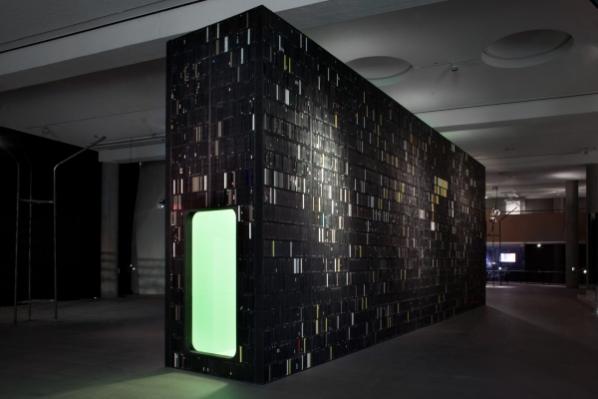
Part of Plastic(s) is Morehshin Allahyari and Daniel Rourke’s project titled The 3D Additivist Cookbook, initially making its conceptual debut at last year’s transmediale festival. In collaboration with Ami Drach, Dov Ganchrow, Joey Holder and Kuang-Yi Ku, the Cookbook examines 3D printing as possessing innovative capabilities to further the functions of human activities in a post-human age. The 3D printer is no longer just an object for realising speculative ideas, but instead is manifested as a means of creating items that may initially (and currently) be considered alien for human utility. Kuang-Yi Ku’s contribution, The Fellatio Modification Project, for example, applies biological techniques of dentistry through 3D printing in order to enhance sexual pleasure. Through the 3D Additivist Cookbook, plastic is transformed into a material with infinite possibilities, in which may also be considered as alien because of their human unfamiliarity.
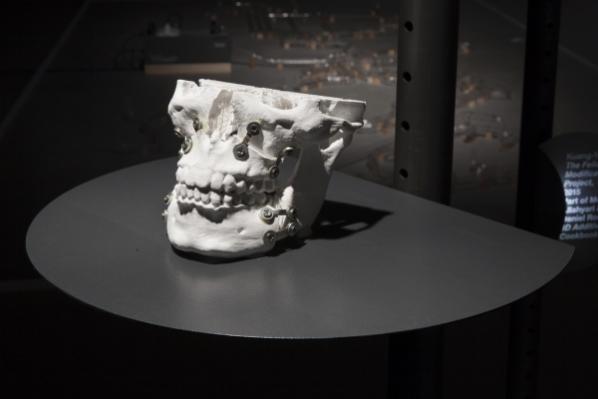
Alien and unfamiliarity is also prevalent when noticing the approach by which the works are laid out and lit throughout the exhibition. Without taking Video Palace #44 into consideration, the exhibiting space is void of walls and rooms. Instead, what we witness are erect structures, or tripods, clasping screens and lights. These architectural constructions are, as Arns points out in the interview we conducted, reminiscent of the extraterrestrial tripods invading the Earth in H.G. Wells’ science fiction novel, The War of the Worlds; initially illustrated by Warwick Goble in 1898. The perception of alien matter is enriched through this witty application of these technical requirements as audiences wander amongst unknown fabrications.
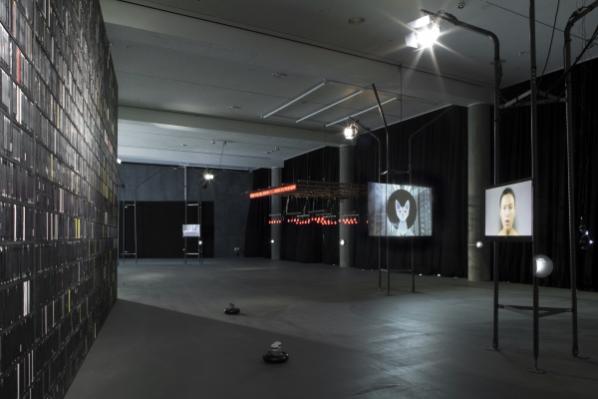
Amidst and through these alien structures, screens become manifestations for expressive AIs. Pinar Yoldas’ Artificial Intelligence for Governance, the Kitty AI envisages the world in the near future, 2039. Now, in the year 2017, Kitty AI appears to the viewer as a slightly humorous political statement, however, much of what Kitty is saying may not be far from speculation. Kitty AI appears in the form of rudimentary and aged video graphics of a cute kitten, possibly to not alarm humans with its words. It speaks against paralysed politicians, extrapolates on overloaded infrastructures of human settlement, the on-going refugee crisis still happening in 2039 but to larger dimensions and… love.
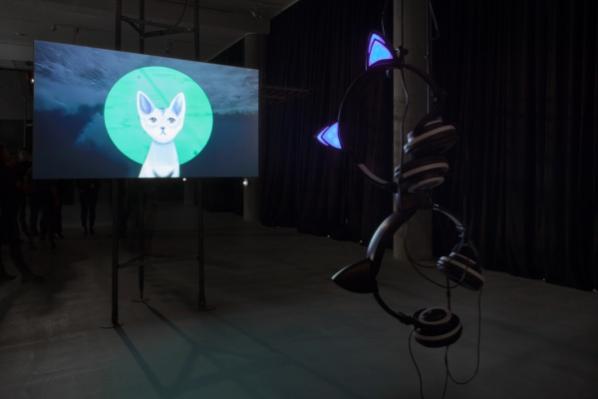
The Kitty AI is ‘running our lives, controlling all the systems it learns for us’, providing us with a politician-free zone and states that it ‘can love up to three million people at the time’ and that it ‘cares and cares about you’. Kitty AI has evolved and possesses the capacity to fulfil our most base desires and needs – solutions to problems in which human are intrinsically the cause of. Kitty AI is a perfect example when taking into consideration Paul Virilio’s theory in his book A Landscape of Events, stating:
And so we went from the metempsychosis of the evolutionary monkey to the embodiment of a human mind in an android; why not move on after that to those evolving machines whose rituals could be jolted into action by their own energy potential. – Paul Virilio in his book A Landscape of Events
Virilio doesn’t necessarily condemn the evolution of AIs; humans had the equal opportunity to progress throughout the years. Instead his concerns rise from worries that this evolution is unpredictably diminishing human agency. The starting stage for this loss of agency would be the fabrication of algorithms having the ability to speculate possible scenarios or futures. Such is the work of Nicolas Maigret and Maria Roszkowska titled Predictive Art Bot. Almost nonsensical and increasingly witty, the Predictive Art Robot borrows headlines from global market developments, purchasing behaviour, phrases from websites containing articles about digital art and hacktivism, and sometimes even crimes to create its own hypothetical, yet conceivable, storyboards. The interchange of concepts rangings from economics, to ecologies, to art, transhumanism and even medicine, pertain subjects like ‘tactical self-driving cars’ and ‘radical pranks’ for disruption and ‘political drones’ and even ‘hardcore websites perverting the female entity’.
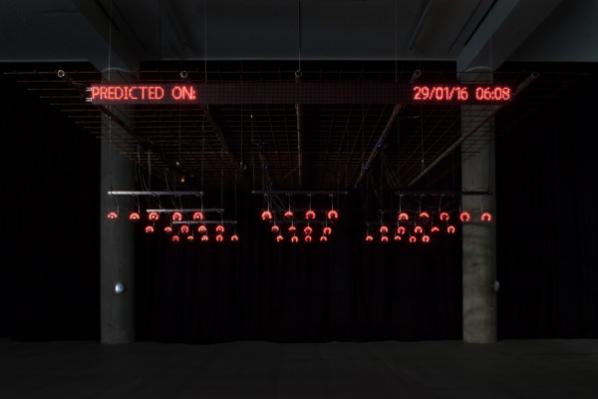
To a certain degree, both Kitty AI and Art Predictive Bot could be seen as radical statements regarding the future of human agency, particularly in politics. There is always an underline danger regarding fading human agency and its importance for both these works and imagined scenarios – particularly when taking into consideration Sascha Pohflepp’s Recursion.
Recursion, acted by Erika Ostrander,is an attempt by an AI to speak about human ideas coming from Wikipedia, songs by The Beatles and Joni Mitchell, and even philosophy by Hegel, regarding ‘self-consciousness’, ‘sexual consciousness’, the ‘good form of the economy’, and ‘the reality of social contract’. Ostrander’s performance of the piece is almost uncanny to how we might expect AIs to understand and read through language regarding these subjects. The AI has been programmed to compose a text from these readings starting with the word ‘human’ – the result is a computer which passes a Turing test, almost mimetic of what in its own eyes is considered an ‘other’ in which we can understand that simulacra gains dialectal power as the slippage becomes mutual. Simultaneously, these words are performed by a seemingly human entity, posing the question of have we been aliens within all along without self-conscious awareness?
Throughout alien matter it becomes gradually apparent that the reason why AIs are problematic to agency is because of their ability to imitate or even be connected to a natural entity. In Ignas Krunglevičius’ video, Hard Body Trade, we are encapsulated by panoramic landscapes of mountains complimented by soothing chords and a dynamic sub-bass as a soundtrack. The AI speaks over it ‘we are sending you a message in real time’ for us to be afraid, as they are ‘the brand new’ and ‘wear masks just like you’ implying they now emulate human personas. The time-lapse continues and the AI echoes, ‘we are replacing things with math while your ideas and building in your body like fat’ – are humans reaching a point of finitude in a landscape whereby everything moves much faster than ourselves?
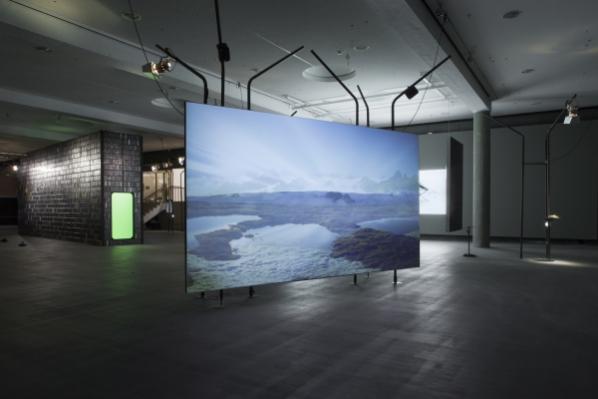
Arn’s potential resolution might be to foster environments of participation and understanding, as with the inclusion of Johannes Paul Raether’s Protektor.x.x. 5.5.5.1.pcp. Raether’s project is a participatory narrative following the daily structures of the WorldWideWitches and tells the story of an Apple Store ‘infiltration’ which took place on the 9th of July 2016 in Berlin. The performance itself was part of the Cycle Music and Art Festival and was falsely depicted by the media as scandalous; the Berliner Post called it ‘outrageous’. The performance featured Raether, wearing alien attire walking into the Store and allowing gallium to swim on the table. Gallium, as a substance is completely harmless substances to human beings, but if it touches aluminium the gallium liquid metal can completely dissolve the aluminium.
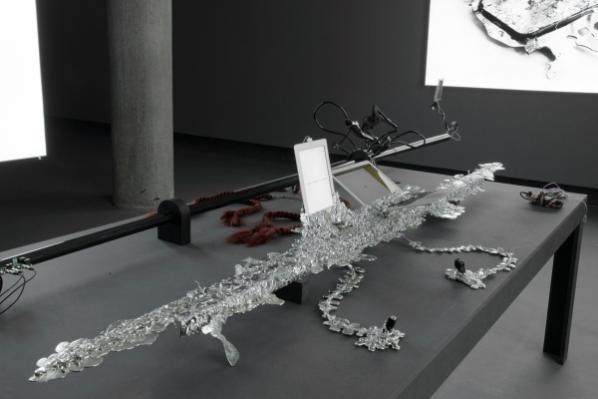
The installation is a means of communicating not only the narrative of the World Wide Witches, but to uncover the fixation that humans have with material metal objects such as iPhones. The installation itself is interactive and quite often engaged a big crowd around it, all curious to see what it was. It was placed on a table covered in a imitated form of gallium spread over cracked screens and pipes which held audio ports for the audience to listen to the WorldWideWitches story. Raether’s work, much like the exhibition as a whole, is immersive, engaging and participatory.
The exhibition precisely depicts alien matter in all its various and potential manifestations. The space, with all its constant flooding of sounds, echoes and reverbations, simulates an environment whereby the works foster intimacy not only with transmediale, but also with its audience. Indeed, Arns with a beautiful touch of curation, has fruitfully brought together the work of these gifted artists fostering an environment that is as much entertaining as it is contemplative. You can read more about Arns’ curatorial process and thoughts on alien matter through her recent interview with Furtherfield.
alien matter is on display until the 5th of March, in conjunction with the closing weekend of trasmediale. Don’t snooze on the last chance to see it!
All images are courtesy of Luca Girardini, 2017 (CC NC-SA 4.0)
“Your work is so Dada, its just weird…” Even though the sentence was uttered playfully and with no foul intentions, it hit me. It sounded dismissive; in my ears, my friend just admitted disinterest. Calling something “weird” suggests withdrawal. The adjective forecloses a sense of urgency and classifies the work as a shallow event: the work is funny and quirky, slightly odd and soon becomes background noise, ’nuff said. I tried to ignore the one word review, but I will never forget when it was said, or where we were standing. I wish I had responded: “I think we already know too much to make art that is weird.” But unfortunately, I kept quiet.
In his book Noise, Water, Meat (1999), Douglas Kahn writes: “We already know too much for noise to exist.” A good 15 years after Kahn’s writing, we have entered a time dominated by the noise of crises. Hackers, disease, trade stock crashes and brutalist oligarchs make sure there is not a quiet day to be had. Even our geological time is the subject to dispute. But while insecurity dictates, no-one would dare to refer to this time as the heyday of noise. We know there is more at stake than just noise.

This state is reflected in critical art movements: a current generation of radical digital artists is not interested in work that is uninformed by urgency, nor can they afford to create work that is just #weird, or noisy. The work of these artists has departed from the weird and exists in an exchange that is, rather, strange. it invites the viewer to approach with inquisitiveness – it invokes a state of mind: to wonder. Consequently, these works break with tradition and create space for alternative forms, language, organisation and discourse. It is not straightforward: it is the art of creative problem creation(Jon Satrom during GLI.TC/H).
In 2016 it is easy to look at the weird aesthetics of Dada; its eclectic output is no longer unique. The techniques behind these gibberish concoctions have had a hundred years to become cultivated, even familiar. Radical art and punk alike have adopted the techniques of collage and chance and applied them as styles that are no longer inherently progressive or new. As a filter subsumed by time and fashion, Dada-esque forms of art have been morphed into weird commodities that invoke a feel of stale familiarity.
But when I take a closer look at an original Dadaist work, I enter the mind of a stranger. There is structure that looks like language, but it is not my language. It slips in and out of recognition and maybe, if I would have the chance to dialogue or question, it could become more familiar. Maybe I could even understand it. Spending more time with a piece makes it possible to break it down, to recognize its particulates and particularities, but the whole still balances a threshold of meaning and nonsense. I will never fully understand a work of Dada. The work stays a stranger, a riddle from another time, a question without an answer. The historical circumstances that drove the Dadaists to create the work, with a sentiment or mindset that bordered on madness, seems impossible to translate from one period to the next. The urgency that the Dadaists felt, while driven by their historical circumstances, is no longer accessible to me. The meaningful context of these works is left behind in another time. Which makes me question: why are so many works of contemporary digital artists still described—even dismissed—as Dada-esque? Is it even possible to be like Dada in 2016?
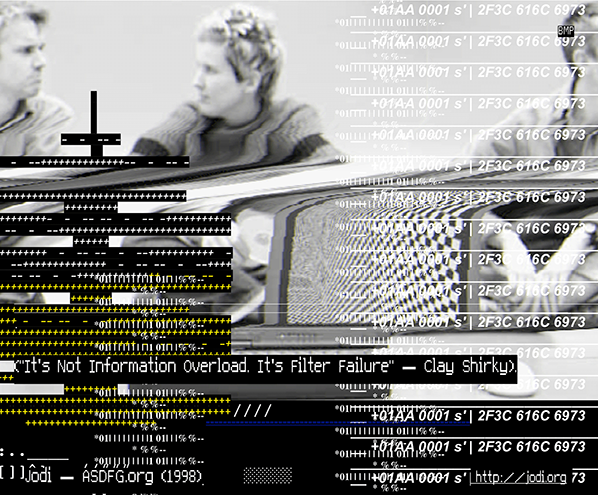
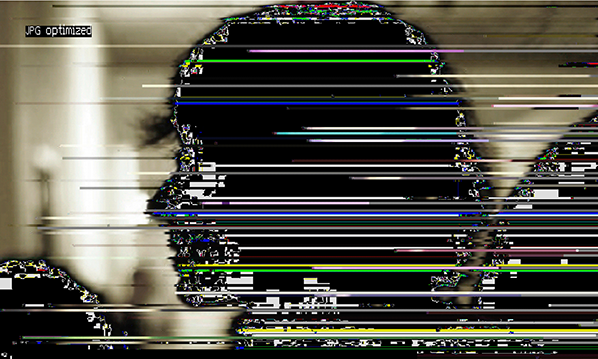
The answer to this question is at least twofold: it is not just the artist, but also the audience who can be responsible for claiming that an artwork is a #weird, Dada-esque anachronism. Digital art can turn Dada-esque by invoking Dadaist techniques such as collage during its production. But the work can also turn Dada-esque during its reception, when the viewer decides to describe the work as “weird like Dada.” Consequently, whether or not today a work can be weird like Dada is maybe not that interesting; the answer finally lies within the eye of the beholder. It is maybe a more interesting question to ask what makes the work of art strange? How can contemporary art invoke a mindset of wonder and the power of the critical question in a time in which noise rules and is understood to be too complex to analyse or break down?
The Dadaists invoked this power by using some kind of ellipsis (…): a tactic of strange that involves the withholding of the rules of that tactic. They employed a logic to their art that they did not share with their audience; a logic that has later been described as the logic of the madmen. Today, in a time where our daily reality has changed and our systems have grown more complex, the ellipses of mad logic (dysfunctionality) are commonplace. Weird collage is no longer strange; it is easily understood as a familiar aesthetic technique. Radical Art needs a provocative element, an element of strange that lures the viewer in and makes them think critically; that makes them question again. The art of wonder can no longer lie solely in ellipsis and the ellipsis can no longer be THE art.
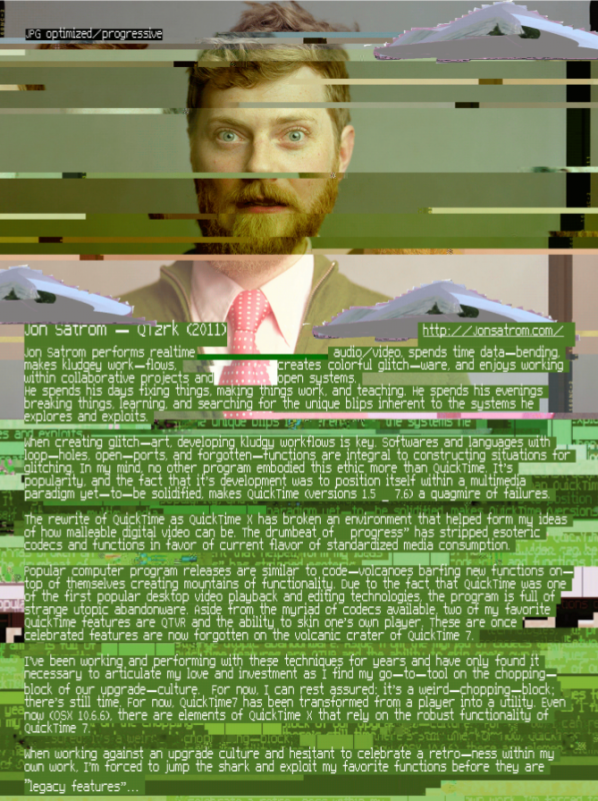
This is particularly important for digital art. During the past decades, digital art has matured beyond the Dadaesque mission to create new techniques for quaint collage. Digital artists have slowly established a tradition that inquisitively opens up the more and more hermetically closed—or black boxed—technologies. Groups and movements like Critical Art Ensemble (1987), Tactical Media (1996), Glitch Art (since ±2001, and later a subgenre that is sometimes referred to as Tactical Glitch Art) and #Additivism (2015) (to name just a few) work in a reactionary, critical fashion against the status quo, engaging with the protocols that facilitate and control the fields of, for instance, infrastructure, standardization, or digital economies. The research of these artists takes place within a liminal space, where it pivots between the thresholds of digital language, such as code and algorithms, the frameworks to which data and computation adhere and the languages spoken by humans. Sometimes they use tactics that are similar to the Dadaist ellipsis. As a result, their output can border on Asemic. This practice comes close to the strangeness that was an inherent component of an original power of Dadaist art.
But an artist who still insists on explaining why a work is weirdly styled like Dada is missing out on the strange mindset that formed the inherently progressive element of Dada. Of course a work of art can be strange by other means than the tactics and techniques used in Dada. Dada is not the father of all progressive work. And not all digital art needs to be strange. But strange is a powerful affect from which to depart in a time that is desperate to ask new critical questions to counter the noise.
Thanks to Amy J. Elias and Jonathan P. Eburne
NotesImages in this article are part of the exhibition Filtering Failure curated by Julian van Aalderen and Rosa Menkman in 2011.
Catalogue of exhibition here:
http://www.slideshare.net/r00s/filtering-failure-exhibition-catalogue
“It is highly unlikely that we, who can know, determine, and define the natural essences of all things surrounding us, which we are not, should ever be able to do the same for ourselves – this would be like jumping over our own shadows.” – Hannah Arendt, The Human Condition
One & Other, part of the Zabludowicz Collection’s annual Testing Ground Project, is a curatorial collaboration between MA Curating students from Chelsea College of Arts and CASS, London Metropolitan University. The show holds together works by Ed Atkins, David Blandy, Cécile B. Evans, Leo Gabin, Isa Genzken, Rashid Johnson, Tim Noble, Sue Webster, Ferhat Ozgur, Jon Rafman, Ugo Rondinone, Amalia Ulman, Ulla Von Brandenburg and Gillian Wearing.
The exhibition threads the simultaneously disturbing yet beautiful dualities between the simulated daily persona humans perform and, as Atkins’ work states, ‘actual’ human presence – the distinction between real and the Other.
Walking into the main area of the late 19th century former Methodist Chapel, Atkins’ work echoes through the two-storey building in an authoritative manner, “read my teeth, read my lips, listen, listen, you don’t know how to listen”.
Situated on the ground floor of the space, No one is more WORK than me (2014) appears to be a lower grade CGI avatar of Dave, a persona from Atkins’ Ribbons. I will just call him Dave. Dave is glitchy, at times not synced. His desire to bring himself into the perceived physicality is overwhelming as he elaborates on causal harm features making himself more human, ‘it’s blood, it’s blood, there’s a bruise’. All the works within the space, share the same space and thus are always accompanied by the backdrop of Atkins’ voice, repetitively stating ‘this is my actual head’ and describing the features on the figure’s face. Dave’s comments about his ‘actual’ body features shape the ambience and undertones of the show.
Shown on a flat screen placed on the floor, Dave commands the space to his will as the only video work not bearing headphones. Dave sings for us on multiple occasions, specifically performing Bryan Adam’s ‘Everything I Do (I Do It for You)’. At times he becomes almost irrationally frustrated with himself and the audience, tells us to do him ‘a favour’ and ‘fuck off’. His performance – and frustration – are immersive and quite literally frame the entire show around the work’s presence. Cécile B. Evans’ work positioned directly opposite it, corresponds with teeth, although harmoniously to the corporeal visuals provided by Atkins’ work.
Evans, now exhibiting at the Tate Liverpool, has been making outstanding work since I first came across Hyperlinks, or it didn’t happen (2014) at Seventeen Gallery in London. In One & Other, her video, The Brightness (2013), involves the visual three-dimensional participation of the audience as the invigilators provide 3D-glasses. She states ‘I am here because I am plastic’ and ‘I was real then’, whilst a CGI render of pirouetting teeth is shown, dislocated from their place of origin, the mouth.
The teeth, traditionally a sign interpreted from dreams as a symbol of anxiety, are animated, dancing and may be symbolising the unease experienced when becoming something outside of what you are. Evans’ work is placed within close proximity to Atkins’ work, adjusting for a very comfortable relational approach to both pieces in conversation with each other as motifs of personifying the unanimated, the plastic.
Sleeping Mask (2004) is a mask of a human face made out of painted wax. Playing with notions of human disguised as human, Wearing creates a re-enactment of one of the most human physical properties, the face. Sleeping Mask was placed on a plinth, on a slightly elevated podium, with a singular spotlight shining on it like the Genie Lamp in the Cave of Wonders, thus proving that particular notion to be very effective.
Less effective, and regrettably so, one of the weaker curatorial links to the show, was the inclusion of Amalia Ulman’s Excellences & Perfections – Do You Follow? (2014). As a scripted online-performance viable and lived through her Instagram account, Ulman appears to be critiquing the vanity of self-indulgent approval on social media. Through creating the persona of an overactive digital self, Ulman’s work comes as no surprise when taking into consideration the wider context of the conceptualisation of One & Other. Having been featured in The Telegraph this time last year, she seems to have grabbed the attention of a more public young audience, themselves feverishly present on social media. Whilst her inclusion is not controversial at all, it more so had the teetering effect of ‘oh, it’s that work by Amalia Ulman’. The decision to include her in the show might be interpreted as making a statement – audience participation within this critique becomes redundant as it is vocalised through the very tool she is critiquing. Nonetheless, the surprising addition of Sue Webster and Tim Noble’s work, Ghastly Arrangements (2002), made up for the aforementioned curatorial paradox.
Placed in a room of their own, the work captivates all attention in the darkness. Ghastly Arrangements is an arrangement of silk and plastic flowers in a ceramic vase with a single spotlight projecting its shadow onto the wall. The work addresses the concept of human duality without using humans as a visual medium, perhaps even addressing it more appropriately because it doesn’t involve humans- it involves shadows. The Other in One & Other, is an entity by which can be projected onto, containing duality. Such is Ghastly Arrangements, as the Other assumes a signifier through the shadow as the self. An object can thus be a more powerful vehicle for thought than representation itself – another point made with Jon Rafman’s choice regarding plinths.
A friend of mine once said that a good plinth signifies art with value, making it the ultimate art object. Rafman’s New Age Demanded (2014) is a series of digital sculptures, scattered on tall mirror coated plinths with self-assured confidence on the wooden stage stairs in the upstairs area. Faceless representations of humans are created through quite uncanny looking textured materiality; smooth marble, dripping resin, copper patina and rough concrete. The non-faces are unidentifiable and the absence of definite characteristics moulds an audience-subjective projection of the Other self. The mirror plinth adds to the dimension of projecting oneself, the performative experience and known duality of the self in contemporary society begging the question of, ‘How many people do we exist as?’
Overall, within such an overwhelmingly impressive structure housing the Zabludowicz Collection, a near-perfect group show can prove very challenging to execute. The architecture of the space, its high ceilings, stage and upper balcony, may interfere with the presentation of the art. In One & Other’s case, it felt as though there was too much going on, conceptually but more importantly spatially. Rafman’s immense installation would have been better suited as an isolated entity in the balcony upstairs, whilst the works of Atkins, Evans, Wearing, Webster and Noble could have also stood their own ground conceptually without any further additions. One & Other felt like it could have done with constraining itself to only one type of self-identifying duality, instead of attempting to assess multiple, and although I love the work of Rashid Johnson, it felt slightly out of place within the space; perhaps less is more.
Whilst this piece of writing is only comprised of personal highlights and observations, One & Other is a show not to be missed, and to inspire fellow young and aspiring curators.In the curatorial team for One & Other were Caterina Avataneo, Ryan Blakeley, Nadine Cordial Settele, Sofía Corrales Akerman, Gaia Giacomelli and Angela Pippo.
On until the 26th of February 2017.
All images by Tim Bowditch, courtesy of the Zabludovicz Collection.
The book New Tendencies – Art at the Threshold of the Information Revolution (1961-1978) by Armin Medosch presents thorough research into the international New Tendencies movement that was active in the 60s and in the 70s. In his book, Medosch gave contextualisation of the New Tendencies movement and framed it in the political, social and cultural context of its time. The New Tendencies movement arose in a culmination of high modernism in the 60s, with its centre in Zagreb, Croatia, in former Yugoslavia. This country was itself a modernistic project of the 20th century. However, semi-peripheral in industrial development, the climate of modernism in Yugoslavia influenced art and culture and thus prepared conditions for the country to become a knot in a network of artistic centres of European Fordism like Milan, Munich, Düsseldorf and Paris. One of the first who restored the memory of New Tendencies was Croatian artist and curator Darko Fritz with his research Amnesia International, which transferred the memory of NT to the newer generations of Media Art practitioners.
The New Tendencies movement had momentum in the 60s, while in the 70s, it shared conceptual art’s crisis of faith in late modernism. In the 80s, New Tendencies was almost forgotten. Medosch writes that New Tendencies’ “politics of form” was strongly influenced by its disavowal of the artist as a producer of commodities for the art market”. For the first exhibition in Zagreb, artists consciously used inexpensive new materials and new media from mass production, such as punch cards, plastic ribbons, cardboard, and plywood. In the third New Tendencies exhibition in Zagreb in 1965, organizers wanted to create a new synthesis between the art they applied art through the creation of Multiples, as reproducible art, but this idea was not received well. They wanted to democratize art and were against the scarcity principle that was deeply embedded in the art system. Although ideas around the demystification of art were not new, there was a novelty in “the specific way New Tendencies tried to achieve this — through the formula of art as visual research.” Art was redefined as visual research, and mass production and abundance were not considered negative. Ideas of interactivity, the democratization of art and the participation of the public in New Tendencies exhibitions were sometimes seen as seductive, especially when, in the late sixties, political movements and counter-culture started to influence the art world and became much more explicit in demands for political and social change.
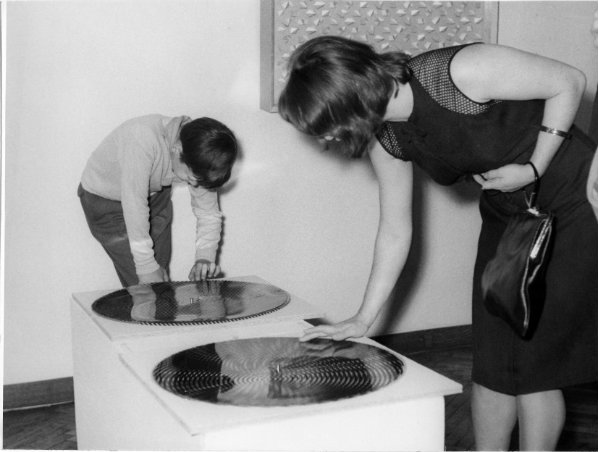
The book New Tendencies – Art at the Threshold of the Information Revolution (1961-1978) is valuable material for a non-western centric approach to the history of art (it is worth noting that the histories of computer and digital art are not exempt from western-centric historicization). Still today, there are many examples of ignorance of what was happening outside North America and Western Europe, despite more and more stories, research and documentation about post-WW2 art. Medosch is not looking for the “Other”, trying to fill the geo-holes in the history of arts, or fixing “colonial guilt”, but he is using New Tendencies as a case study of an art movement that connects the early history of art & media with social issues. As secondary, it came out that the centre of this movement was Zagreb and former Yugoslavia. However, non-intentionally, Medosch uncovers the story of the soft power of that time in Yugoslavia – an uncovering which proves thought-provoking as a counter to western-centrism.
As Medosch outlines, the Croatian artist and curator Darko Fritz was the first to suggest reading New Tendencies as a network – or rather a network of networks that included group Zero from Germany, the groups N and T from Italy, Equipo 57 from Spain, and Paris-based Group de Recherche d’Art Visuel (GRAV), to name just a few. Also, in Zagreb, New Tendencies had direct precursors such as EXAT 51 or GORGONA, whose members had close ties with the movement.
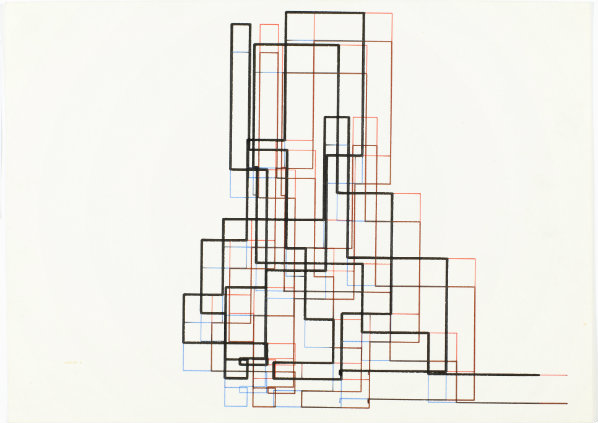
The formation of groups and networking in New Tendencies includes two processes. The first is standard practice in art history: young artists gather to strengthen their position in art and the social system. The second also showed renewed trust in common destiny and solidarity, corrupted by collective totalitarian experiences and disappeared during and after WW2. New Tendencies artists are of a generation that renovated belief in social progress, common interest and direct democracy. Therefore some groups like GRAV, Equipo 57, and N experimented with collective authorship, a model that, for the market, is not easy to deal with. This group ethos was present in artistic practice and in curatorial and organizational practices. The curatorial boards of New Tendencies exhibitions and events engaged in joint decision-making, often actively communicating with artists about the content they produced. For example, the small details involved in artists filing “application forms” about themselves and describing their works was a self-managed bureaucratic procedure which developed into more complex research and decision-making.
New Tendencies artists embraced Fordist technological innovation; rather than opposing technological acceleration, as most other artists at that time were thinking of a future technological society beyond alienation and oppression. Similar to their “artistic relatives” Situationists, some NT artists used playful elements envisioning post-Fordist conditions where repetitive work was viewed as oppressive. In his book, Medosch analysed the similarities and differences between these two groups that shared much common ground.
In his book, Medosch emphasized the connection between social analysis and developed a critique of New Tendencies groups and new readings of Marx, particularly those of Operaismo in Italy and Praxis in Yugoslavia. A central element of these new readings was “Marx’s critique of commodity fetishism applied to artwork and its ideological function in the capitalist world.” Medosch intends to minimize the current tendency to re-inscribe movements that developed a half-century ago in favour of investigating theoretical frameworks and political conditions of that time.
In August 1968, in Zagreb, a symposium Computers and Visual Research was organized at the same time as the Cybernetic Serendipity exhibition in London. The exhibition in Zagreb, called t-4 (Tendencies – 4) in 1969, followed the symposium and Cybernetic Serendipity, which was the inaugural moment of international computer art. The symposium Computers and Visual Research marked the line between the first phase of New Tendencies’ analogue “programmed artworks” (as Umberto Eco defines it in the exhibition catalogue) and the second phase in which NT embraced art that used computers.
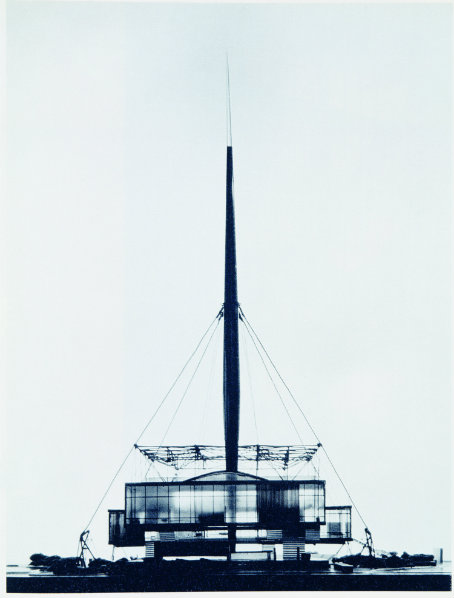
Although Medosch’s idea was not to emphasize Yugoslavian context beyond the extent needed for general contextualization of the movement, the fact that Zagreb had the logistical, infrastructural and intellectual capacity to be the centre of the movement for almost 2 decades showed certain “properties” of Yugoslavia of that time. For the book’s readers in former Yugoslavian countries, the book brings certain discomfort since, after the Yugoslav wars in the nineties, there is a general tendency to forget the heritage of the Yugoslav modernist project. Also, the “eagerness” of activity in Zagreb could be because, after the breakup of Yugoslavia’s ties with Stalin in 1948, Zagreb wanted to restore connections with the cultural context of what historian Eric Hobsbawm called the “main mountain range or crest of European economic and cultural dynamism”, an area that encompasses Paris, the Rhine valley, north Italy, south Germany and Switzerland.
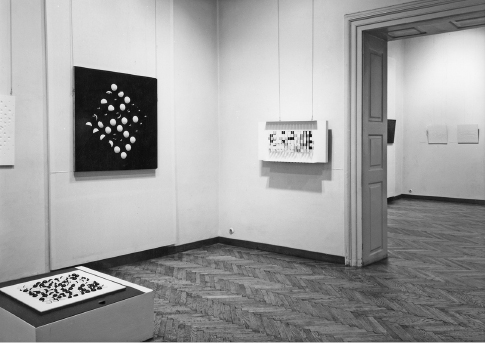
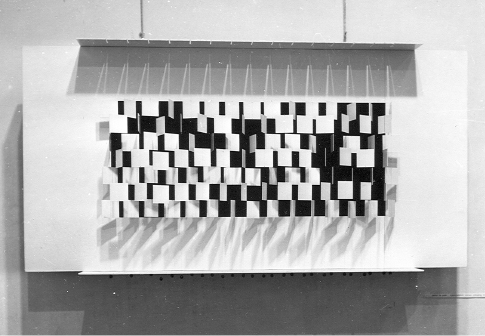
In a way similar to New Tendencies in the ’60s and ’70s, Media Art (a generic term that covers new media art, net.art, net cultures, and digital art at the end 90’s and beginning of 2000) experienced a “specific” relationship with the mainstream art system. The first thing that connects both New Tendencies and later Media Art is a reluctance to be incorporated into the contemporary art system. This uneasiness has fuelled recent debates ranging from considering that Media Art is part of the contemporary art system to opinions that Media Art is a completely different category. This relationship has similarities with that of the New Tendencies movement concerning the contemporary art system half a century ago. The other is something that is unfolding in front of our eyes, a kind of new Amnesia International 2.0, slowly covering memories of media art and culture of the 90s and early 2000.
Armin Medosch’s book makes a structural connection between early media art and culture and the media art of the 90s and early 2000s. Concepts of sharing, critique of the commodification of art objects, the de-elitization and democratization of art, demystification of art, and the embracing of discussion of pluralistic techno-political impacts of technology; these are common denominators that connect art at the threshold of the Information Revolution with the art of late Informationalism in the late 20th and early 21st Century.